Text
Research - Artistic Research
Excerpts from:
What is artistic research?
JULIAN KLEIN, What is artistic research?, Gegenworte 23, Berlin-Brandenburgische Akademie der Wissenschaften 2010
WHAT IS ARTISTIC RESEARCH?
Research
According to the UNESCO definition, research is "any creative systematic activity undertaken in order to increase the stock of knowledge, including knowledge of man, culture and society, and the use of this knowledge to devise new applications." (OECD Glossary of Statistical Terms, 2008).
(...)
Research therefore means not-knowing, rather: not-yet-knowing and desire for knowledge (Rheinberger 1992, Dombois 2006). Research also seems to be no unique selling point of scientists, but to include many activities that have been made by artists, for example.
(...)
"Research about / for / through Art | Art about / for / through Research."
(...)
Even natural scientific research alone is very diverse in its objects, methods and products, as McAllister (2004) notes. How much more this applies to research including the humanities and social sciences, and further industrial, market or opinion research. Not surprisingly, this is also true for artistic research. Among the authors cited here, there is agreement that this diversity has to be preserved against efforts to canonical restrictions.
(...)
The principal diagnosis is, however, "research" in the singular exists not more than "science" or "art" - they all are collective plurals, assembling very different processes, which often are closer related to others over category boundaries, like disciplines, than with some other members of their own faculty, and then assemble much better under common interdisciplinary roofs, such as topics, methods or paradigms. This “urge of singularization” is probably the strongest root of the supposed and stubborn opposition between art and science: Baecker (2009) calls this the "organizing principle of the functional difference", which emerged in the 19th century according to Mersch & Ott (2007).
Art and science are not separate domains, but rather two dimensions in the common cultural space. (...) However, at least not everything, what is considered being art, has therefore to be unscientific and not everything that is regarded as science, inartistic.
Research is not only artistic, if carried out by artists (as helpful as their participation may be), but deserves the attribute “artistic”, when made under the specific quality of an artistic experience.
Artistic Experience
In the mode of aesthetic sensing perception is present to itself, opaque and sensible. Artistic experience can be determined similarly as the perception mode of sensible interfering frames (for details see Klein 2009). (...) The artistic experience as well as the aesthetic sensing are modes of our perception and, as such, constantly available, even outside of art works and art places.
In the experience the subjective perspective is constitutively included, because experience can not be delegated and only be negotiated intersubjectively in second order. This is a major reason for the conception of the singular nature of artistic knowledge (Mersch & Ott, 2007, Nevanlinna 2004, McAllister 2004, Busch 2007, Bippus 2010. Dombois 2006 points to Barthes' proposal of a "mathesis singularis" in 1980). Artistic experience is particularly dependent on and inseparable from the underlying undergoings. Artistic experience is an active, constructive and aesthetic process, in which mode and substance are fused inseparably. This differs from other implicit knowledge, which generally can be considered and described separately from its acquisition (see Dewey 1934, Polanyi 1966, Piccini and Kershaw 2003).
Artistic Research
If "art" is a mode of perception, "artistic research" must be the mode of a process. Therefore, there can be no categorical distinction between "scientific" and "artistic" research - because the attributes independently modulate a common carrier, namely, the aim for knowledge within research. Artistic research can therefore always also be scientific research (Ladd 1979). For this reason, many artistic research projects are genuinely interdisciplinary, specifically: indisciplinary (Rancière in Birrell 2008, Klein & Kolesch 2009).
Against this background the phrase "art as research” seems to be not quite accurate, because it is not the art, which evolves into research somehow. What exists, however, is research that becomes artistic - so it should be rather named "Research as Art", with the central question: When is Research Art?
In the course of a research, artistic experience can occur at different times, be of different durations and different importance. This complicates the categorization of the projects, but allows on the other hand a dynamic taxonomy: At what times, in which phases can be research artistic? First, in the methods (such as search, archive, collection, interpretation and explanation, modeling, experimentation, intervention, petition,...), but also in the motivation, inspiration, in reflection, discussion, in the formulation of research questions, in conception and composition, in the implementation, in the publication, in the evaluation, in the manner of discourse - in order only to begin the list hereby. These phases can be summarized only posthoc and categorize, for example in the usual triple of object, method and product. This sequence is important: for the discussion on artistic research is not to fall into a normative restriction in a canonical system (Lesage 2009).
At what level will the reflection of artistic research take place? In general at the level of artistic experience itself. This does not exclude neither an (subjective or intersubjective) interpretation on a descriptive level, nor a theoretical analysis and modeling on a meta- level. But: "It is a myth that reflection is only possible from the outside." (Arteaga 2010). Artistic experience is a form of reflection.
Artistic knowledge
Who are we? How do we want to live? What are things meaning? What is real? What are we able to know? When does something exist? What is time? What's a cause? What is intelligence? Where is sense? Could it all be otherwise? - These are examples of common artistic and scientific interest. Their treatment does not always lead to secure and universally valid knowledge (with regard to the history of science: only in very few cases, no?). The arts are granted the authority to formulate and address such basal and yet complex issues in their specific ways, which don’t have to be less reflected than those of philosophy or physics, being capable to gain specific knowledge that could not be delivered otherwise.
(...)
Some authors require that artistic knowledge must nevertheless be verbalized and thus be comparable to declarative knowledge (e.g. Jones 1980, 2004 AHRB). Others say it is embodied in the products of art (e.g. Langer 1957, McAllister 2004, Dombois 2006, Lesage, 2009, Bippus, 2010). But ultimately it has to be acquired through sensory and emotional perception, precisely through artistic experience, from which it can not be separated. Whether silent or verbal, declarative or procedural, implicit or explicit - in any case, artistic knowledge is sensual and physical, "embodied knowledge". The knowledge that artistic research strives for, is a felt knowledge.
____________________
Excerpt from:
Text: Angelika Boeck and Peter Tepe | Section: On “Art and Science”, What is Artistic Research? W/K Between Art and Science, A Peer reviewed online journal. February 25, 2021. Taken from: https://between-science-and-art.com/what-is-artistic-research/
1. Angelika Boeck: my understanding of artistic research
Since 1999 I have been carrying out research using the means and methods of my artistic practice. My dissertation, titled De-Colonising the Western Gaze: The Portrait as a Multi-Sensory Cultural Practice (2019), is also committed to this position. Artistic research is a broad field; it encompasses many different concepts. I prefer to use the term art practice-based research, as I consider it to be research founded on a particular art practice: firstly, on the artist’s activity in pursuit of a concrete question or a set of not yet clearly defined questions by employing artistic means and methods, and secondly, on the presentation of the process and/or outcome in the form of an artwork. The proximity to scientific strategies and practices lies in the “not-yet-knowing” (Klein 2011: 1); in the desire to show and understand; and in the fact that artists often use ethnographic, sociological, collecting/archiving or laboratory work practices; that they experiment with processes that produce images or deal with new media and technosciences (for example the Brazilian media artist and theorist Eduardo Kac, who manipulated living organisms according to aesthetic criteria as part of his Bio Art or Transgenic Art in the early 1990s). Thus, artistic research can be considered as a means of approaching human subjects (including oneself), objects and contexts (current or historical) — an examination often combined with an interest in gaining concrete experiences in an endeavour to convey these in a sensorially perceptible form (to incite reflection, amusement, disturbance or provocation). Artistic research is therefore not just a matter of analysing a given circumstance or certain emotions.
Reflection takes place during artistic production. Other forms of knowledge production (particularly in the natural sciences) require the use of approved methods, being part of a theoretical discourse and a verifiable, generalisable and comprehensible depiction of the research process. Artistic research functions differently: methodological and the theoretical aspects can often only be identified retrospectively, through a process of reverse engineering. This means that the creation process of the artistic works is examined and put in relation to the works of other artists, scientists and theorists in order to extract the components of which they are made. A written reflection of the artist (formulating the question, identifying the context and conditions, providing information on the method and theory, self-reflection) is possible, but not absolutely necessary; though I do consider it to be profitable.
_____________________
Excerpt from KabK, Lectorate Art Theory and Practice. Taken from: https://www.kabk.nl/en/lectorates/art-theory-and-practice/keywords/artistic-research
Artistic research is distinguishable from other forms of academic research by the central role of artistic practice. The research question derives from the artistic practice of the artist-researcher, the research methods are characterized by the use of artistic practice and materials, and the results of the research project contribute to both artistic practice (on an individual as well as on a more general level) and to artistic academic discourse. Because artistic research is carried out by artist-researchers this produces knowledge, experiences and understanding that cannot be obtained by any other means. They are manifest in the art works and the artistic practices themselves.
__________________
0 notes
Text
P1 - Portraits of a River
Class done in collaboration with tutors from the WdKA (Xenia, Mia and Eric) Practice 1 - 2024.
8 week duration
Assignment:
Objective: Create a visual narrative exploring the river Nieuwe Maas, encompassing its physical, metaphorical, and social dimensions through interdisciplinary research methods.
During this course, you will produce a new collaborative work in the form of a visual narrative* together with an interdisciplinary group of peers. Your visual narrative will explore the river Nieuwe Maas, encompassing its physical, metaphorical, and social dimensions. Your work will depart from a series of interdisciplinary research methods that will be addressed and discussed in class.
*A visual narrative or visual storytelling is a story told with visual material. You can use images, video, audio, text, performance or object-based materials to tell this story and/or convey a message.
Week 1: Introduction, context and team-building
In class:
Welcome, introduction of the course (and competencies/assessment criteria), its goals, timeline, and expectations, teachers. Icebreaker activities to help students get to know each other.
Students write their names and pronouns on papers
Introduction of Practices (film) + Natalia presents her work
Drawing Station Introduction
Group formation and introduce homework for next class.
By the river activity:
Look for suspicious things (objects, smells, colours, textures, shapes, movements, sounds, temperature etc.)
Document it and/or how could you document it?
Homework: Each student group gets a topic in connection to the Maas River they must research and present to the class in no more than 5 mins. Topics: history, geography, criminology, ecology, biology, urban planning, environmental damage over water quality, architecture, demographics, Economic and social impact of the river, water usage, cultural significance, hydrology, etc.
Week 2: Exploring diverse interdisciplinary approaches, understanding interdisciplinarity, intro to visual narrative
Natalia's Class:
10:30 – 13:15 Group A – Drawing Station
14:15 – 17:00 Group B – Drawing Station
Students share their skills and preferred methods of experimentation corresponding to their own field and discipline.
Students build their own catalogue of methods in the form of a zine/manual made in class.
Collaborative exercises where the students exchange and practice to entangle their ideas, styles, methods and skills by putting in practice their own manual (methods) by the Maas near WdKA.
10:30 - 10:45 (14:15 - 14:30): Sitting in their groups, students individually list the methods for conducting research that they practice in their own field. ex. Advertisement - target group study, Fine Arts - material research, Photography - site visits.
10:45 - 11:30 (14:30 - 15:15): As a group they discuss the lists and make one unified list that can be useful for their group project. They will name each method and provide a description of: 1) What it is, 2) How to practice it, 3) With whom to do it, 4) When it should be done, 4) What materials are needed to practice it, and 5) What are the possible challenges.
11:30 - 12:30 ( 15:15 - 16:15) : Make this list (catalogue of the groups research methods) into a zine.
12:45 - 13:15 (16:30 -17:00): Groups show their zine and group discussion.
Materials needed: (color) paper, magazines, scissors, glue, markers, pens, paint or colour pencils, erasers, sharpeners, staplers. (drawing and collage materials).
Homework: Students work independently and in groups on:
Students put in practice the research methods they consolidated as a group in the form of a zine at the Maas. They must document their process and findings.
Students print copies of their zine and bring it for our next class
Video: John Berger Susan Sontag (storytelling lecture) watch before Friday.
Week 3: Research through drawing, integrating research into creative process (research by making)
Natalia's class:
10:30 – 13:15 Group A – Drawing station and outside
14:15 – 17:00 Group B - Drawing station and outside
Introduction to artistic research
Embodied research exercises in location – Inspired by Sara Ahmed, Orientations: Toward Queer Phenomenology.
10:30 - 11:30 (14:15 -15:15): Read the Forward of Mika Hannula, Artistic Research Methodology.
11:30 - 12:45 (15:15 - 16:30): Out in the landscape
Choose on of the following exercises and allow your intuition to guide your experience, dont question it or try to make it rational or with an end. The keyword to this exercise is *Desire.
Descriptions: Walk around and make thorough descriptions of what you see. Don’t stand only in one location, if you have made the description of something, then move on to the next. Let your intuition determine what you want to describe. Record your descriptions. Think of words, situations or sounds that can help describe what you see and sense. Include them in your recording and narrations.
Acute listening: Tune in to the sounds of the landscape. Try to isolate the sounds from all other noise, so that you have clarity over its qualities. Imitate it, try to make the same rhythm, the same pitch, the same fade in/out. Record yourself + Walk around the landscape and make your body encounter other bodies (non-human) by touching, licking, laying on or under, standing on or under and listen to the sounds these encounters create. Record them. Record the sounds of the landscape and write down what sounds you are recording.
Choreograph of space and relation: Think of the movement that the space / location suggests to your body. If you follow your intuition in navigating the landscape and encountering other non-human bodies, what type of movements do you do in order to reach those encounters? + Think of the movements that would be habitual in that landscape and how they shape that landscape. Enact those movements and document them. Be wary of how your body is shaped and moved by the space. While enacting them change pace, change orientation, and enact the movements in different locations, document your experience and the impact of those shifts in writing, drawings or video.
Extensions of the body: Find objects, bodies or non-human bodies that can help your own body extend in the space. Practice these extensions and document them in writing, drawings or video. Reflect on their inherent agency, their power and impact over your body, your movements, your voice, your rhythm and the space around you. Write down or record your reflections.
and:
Collect: Gather a collection of everything you encountered. Keep these objects and bodies (matter) for the next class, you will need them. Document you collection.
*If taking an other-than-human-body or object hurts or damages something, then document it with a drawings or tracing its textures or describing it in sound.
12:45-13:15 (16:30-17:00): Group discussion: Show and discuss findings
Guide discussion around Desire: What is desire for me? How do I experience desire? How does desire mediate my relations with other bodies and objects? Write down your ideas, realizations, confusions, questions, etc.
Materials needed: phone - recording (audio/video/photo) device, notebook and pen/pencil.
Homework:
Students compile all the materials gathered during the session in physical form. If images were taken, sounds were recorded or videos were filmed, they must be printed or displayed in a device in the following session with Natalia.
Week 5: No Class with Natalia.
Week 4: Experimentation and making, with emphasis on experimental and collaborative process
10:30 – 13:15 Group A – at Drawing Station and WdKA
14:15 – 17:00 Group B – at Drawing Station and WdKA
Collaborative session in class: with all the material collected in the previous embodied research session.
Peer to peer review about material they collected + Group analysis of the material
Arranging, re-arranging and installing the material for public display (exercise) - improvising a narrative within a different context. (object-based, presenting archived material)
10:30 - 11:30 (14:15 - 15:15): In groups students share the collected material from the previous class and they do group a analysis of the material.
11:30 -12:30 (15:15 - 16:15): Each group will find a spot in the 3rd floor of WdKA (drawing station and around). They will arrange and re-arrange the material as a group improvising a narrative that is self-standing.
12:30 - 13:15 (16:15 - 17:00): We go around to see and discuss the results.
Materials needed: Materials collected from the previous class and installing material such as rope, tape, nails, etc.
Homework: Each student individually brings a news article about the Maas River in Rotterdam that they find relevant to their interests and/or project.
Week 6: Production of Visual narrative.
10:30 – 13:15 Group A - Drawing Station
14:15 – 17:00 Group B - Drawing Station
Collaborative session in location: Each student brings an article from the news about the Maas River. As a group they agree on a question(s) or topic(s) they would like to find out more about. Students conduct artistic research (conversation/interview) with the nearby inhabitants in order to gather testimonies on the topic.
Students analyze the interviews they conducted and how they may affect their project/knowledge of the Maas.
Discussion over the relevance, impact and value of art and design in the broader social and cultural context.
10:30 - 11:00 (14:15 - 14:45): Each student shares the content of the article they brought with their group. As a group they agree on a question(s) or topic(s) they would like to investigate further. Each group writes down the questions or topics.
11:00 - 12:00 (14:45 - 15:45): Students conduct interviews/conversations with people in the city near our chosen location. Students gather testimonies on that topic(s) or question(s).
12:00 - 12:45 (15:45 - 16:30): Students analyze the interviews/conversations they conducted and how they impact their stories, narratives, and knowledge of the Maas River.
12:45 - 13:15 (16:30 - 17:00): Group discussion about their findings.
Week 7: Refining the visual narrative, asking critical questions, production
Natalia's class:
10:30 – 13:15 Group A – Drawing Station
14:15 – 17:00 Group B – Drawing Station
Feedback session with groups and peers.
Asking critical questions.
Writing for 1.3
10:30 - 11:30 (14:15 - 15:15): Writing reflection for 1.3:
Choose 3 out of the 5 prompts below to write about. Write for 15 minutes on each prompt. Write in whatever way feels natural to you. You don’t have to write in an academic or literary format. You won’t be assessed on correct grammar or spelling; getting your thoughts on paper is what counts. Before you start to write, travel in your mind to moments and memories. Think about how you felt and where you felt it in your body. Think about your sensory experience: what did you see, hear, smell, feel, etc. Use these memories and experiences to be as detailed and elaborate as possible in your writing.
Describe an object you interacted with during P1.2 program.
Describe a moment during the P1.2 program where you experienced a shift in knowledge or learned something new.
Describe something unexpected you experienced during the P1.2 program.
Describe an experience from P1.2 that feels valuable to your future projects.
Describe a space outside of the Academy that you connected with during the P1.2 program.
Homework: Save your writing assignment as .docx. Upload the link to your assignment under the correct Station and student group (A or B). Deadline for submission is Thursday, March 28 at 23:59 (uploading is not possible after)
11:30 - 12:30 (15:15 -16:15): Feedback between groups and asking critical questions.
Week 8: Presentations and reflection on the project
Groups present their Portraits of the River. Peer and teachers’ team feedback.
0 notes
Text
Site-Specific Works
Ana Mendieta
"Cuban-American Ana Mendieta, born in Havana, Cuba, 1948, explores the topic of identity by representing the theme of exile in a temporary yet concrete visual way. Identity can be defined as the permanent characteristics that make someone who they are. However, by depicting only a silhouette of a female body in a changing environment, Mendieta is questioning whether the idea of identity — gender, race, nationality, ethnicity, etc. — is something that is unchanging.[12]
Mendieta studied at the University of Iowa in 1967, where she earned both her BA and MA degrees in painting. At the time, art was becoming more exploratory and experimental, with many artists crossing between multimedia, video art, performance art, installation art, and photography. While studying painting, Mendieta also began to experiment with mixed media and performance, which she is most famous for. Mendieta’s Silueta Series, which stretched from 1973 to 1980, has become her best-known work, crossing boundaries between land art, body art, and performance art. The series of photographs which now comprise the performance work show Mendieta’s silhouette in various landscapes and nature, with her body typically absent from the photographs but occasionally present. Because the Silueta Seriesis created within nature and with the surrounding landscape, it is considered to be earth art. Representing her body or silhouette as part of the landscape, Mendieta creates a crossover between subject and object, meaning her work
points to Mendieta as a subject in so far as Mendieta is a human being who has made the work, but it also points to her as an object in so far as her very silhouette is an object of art also represented by photographic means. Nevertheless, this work of art also problematizes the sharp dichotomy between subject and object, precisely by disclosing a space where it is not clear whether Mendieta is subject or object.[13]
The sites that Mendieta chose for her Silueta Series are temporary and easy to be missed, where “the sense of absence is heightened by the feeling that the wind could make the silhouette disappear. This is a characteristic that can be found in most of the silhouettes, since Mendieta chooses to make her silhouettes in places where their disappearance is only a matter of time”.[14] In other words, Mendieta chooses particular locations in nature where her work will be fleeting and eventually erased by other elements of the environment, making the Silueta Series site-specific. In Mendieta’s Untitled (from the Silueta Series), her silhouette is documented as red flowers on the beach in Mexico, where the water is already removing the flowers and erasing Mendieta’s silhouette. In this silhouette, like many of her silhouettes in the series, Mendieta has portrayed the female silhouette with arms stretched overhead, which “recalls the pose of the goddess with outstretched arms familiar from statues of the Minoan snake goddess amongst many other ancient sculptures and reliefs”.[15] By using the goddess pose, Mendieta reinforces the idea that nature is feminine and depicts a “celebration of feminine power, energy and divinity. Mendieta’s images seem to partake of aspects of all of these meanings, while also retaining something of the opacity of the gesture, its refusal or inability to be rendered directly into speech”.[16]" taken from: https://opening-contemporary-art.press.plymouth.edu/chapter/site-specificity/
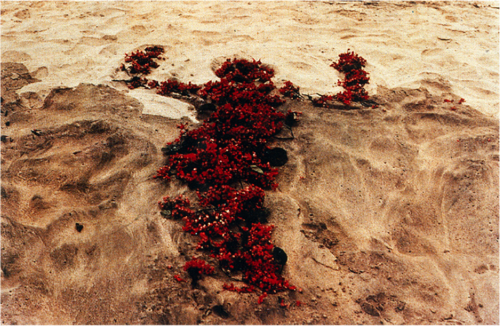
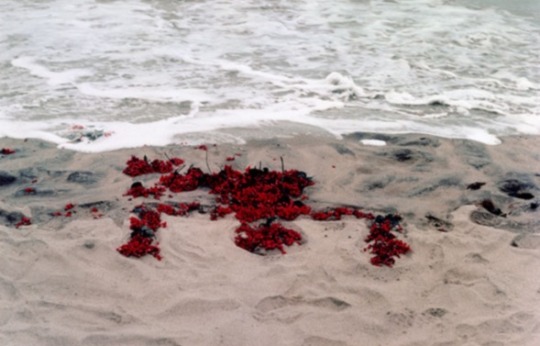
"While her work explores the relationship between femininity and nature, Mendieta’s work also has ties to the Santería religion,
which provided familiar connections to memories of her childhood. Santería is the religion of the Yoruba-speaking people of Nigeria who were brought in chains to Cuba. Over time, slaves blended their traditional religion with elements of Spanish Catholicism and European spiritualism. Women are powerful participants and leaders in Santería as over half of the Santería priests are women. Afro-Cuban beliefs like Santería were introduced into New York City during the 1940s and surged in popularity following the exodus from the Cuba after the revolution in 1959.[17]
In many of her works, Mendieta uses blood, which is an essential part of the Santería tradition.
Mendieta’s work also deals with the theme of exile. In 1961, the same year that Fidel Castro declared Cuba a Marxist-socialist country, Mendieta’s parents sent her and her sister to the United States under a program sponsored by the Catholic Church called Operation Peter Pan. Mendieta’s father Ignacio was sentenced to 20 years in prison in 1965 for being involved with planning the Bay of Pigs invasion, and it was also discovered that Ignacio had received training from the FBI and had suspected connections to the CIA. Mendieta and her sister were moved through multiple foster homes in Iowa until being reunited with their mother and younger brother in 1966.[18] It can be seen in the Silueta Series“that having been torn from her homeland is what led her to carry out a dialogue between earth and the female form—and bring to light the ‘space of exile’ or ‘exiled space’ that is disclosed through her art”.[19] By being in exile, one is separated from their home. It seems as though Mendieta tries to portray her lack of home or find a new home in different landscapes, overcoming her exile from Cuba and accepting that the Earth is her home.
Mendieta moved to New York City in 1978 and continued to create her unique earth-body art until her unfortunate death in 1985, where she fell from her apartment window.[20] At the time of her death, Mendieta and her husband, Carl Andre, had only been married for nine months. Andre became a suspect and was “arrested and charged with Ana Mendieta’s death. At the end of the trial, however, the jury dismissed all of the charges against him. Ana’s death has remained a mystery to her family and friends. To many, Andre’s acquittal was not only a sign of a failed justice system, but also of a patriarchal disregard of domestic violence”.[21] Even after her death, Mendieta’s art continues to be relevant to the contemporary world through her discussion of femininity, nature, exile and identity." taken from: https://opening-contemporary-art.press.plymouth.edu/chapter/site-specificity/

Siluetas (Image from Yagul), 1973

On Giving Life, 1975
Mendieta tends to a study skeleton representative of death, putting modeling clay and red pigment on the bones. After finishing this beautification of the skeleton, Mendieta laid on top of it, creating a physical bond between life and death.

Untitled (Siluetas Series), 1976
Mendieta created this silhouette in the sand then added red pigment. The silhouette deteriorates slowly between each photograph as the waves take away sand, dissolving the outline of the silhouette and washing away all evidence of the artist’s presence.
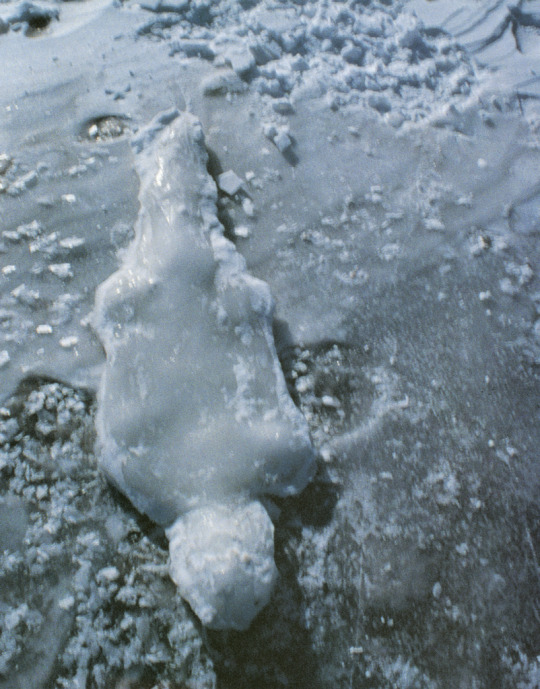
Untitled (Snow Silueta), 1977
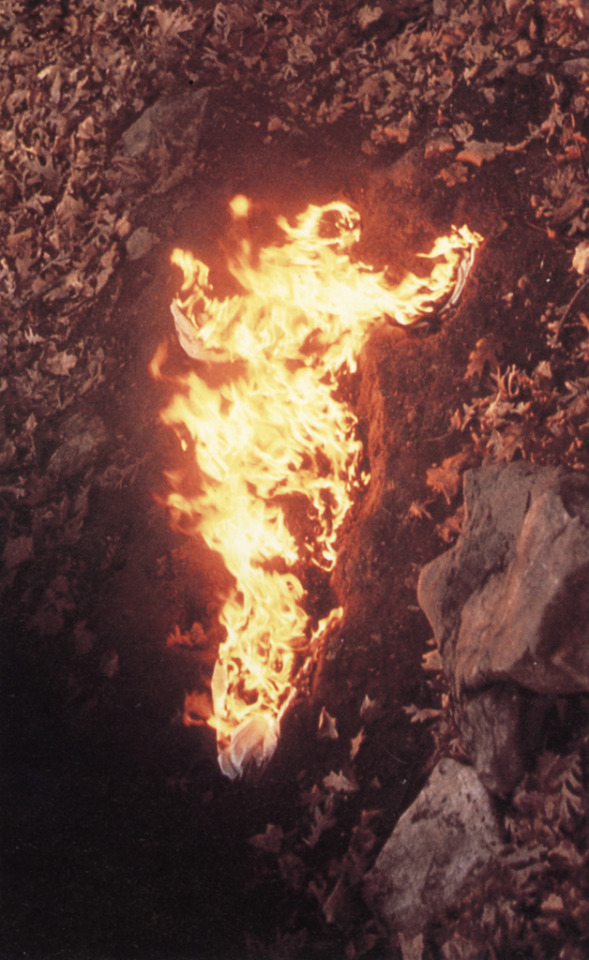
Silueta en Fuego, 1976

Anima (Firework Piece), 1976
The forces that changed Mendieta’s silhouettes were not always drawn out natural regressions. She subjected them in some cases to immediate destruction, using fire or in the case of Anima she created a theatrical display using fireworks.


Tree of Life, 1976
Camouflaged against a tree with her arms raised in a gesture symbolizing a “wandering soul,” the artist is present yet absent. It is only when looking closer at the photograph that the outline of Mendieta’s body becomes visible. Otherwise, she has all but melted into the natural surroundings.

Alma. Silueta en Fuego. Iowa, november 1975
Thomas Hirschhorn
Gramsci Monument

"Gramsci Monument is a new artwork by Thomas Hirschhorn, taking place on the grounds of Forest Houses, a New York City Housing Authority development in the Bronx, New York. Gramsci Monument is the fourth and last in Hirshhorn’s series of “monuments” dedicated to major writers and thinkers, which he initiated in 1999 with Spinoza Monument (Amsterdam, the Netherlands), followed by Deleuze Monument (Avignon, France, 2000) and Bataille Monument (Kassel Germany, 2002).
This fourth monument pays tribute to the Italian political theorist Antonio Gramsci (1891–1937), famous for his volume of Prison Notebooks(1926–1937). Gramsci Monument is based on Hirschhorn's will “to establish a definition of monument, to provoke encounters, to create an event, and to think Gramsci today.”
Constructed by residents of Forest Houses, the artwork takes the form of an outdoor structure comprised of numerous pavilions. The pavilions include an exhibition space with historical photographs from the Fondazione Istituto Gramsci in Rome, personal objects that belonged to the philosopher from Casa Museo di Antonio Gramsci in Ghilarza, Italy, and an adjoining library holding 500 books by (and about) Gramsci loaned by the John D. Calandra Italian American Institute in New York. Other pavilions include a stage platform, a workshop area, an Internet corner, a lounge, and the Gramsci Bar—all of which are overseen by local residents.
Gramsci Monument will offer a daily program of lectures by philosopher Marcus Steinweg, a children's workshop run by artist Lex Brown, a radio station, happy hour, and a daily newspaper. Weekly programs include a play titledGramsci Theater, Gramsci Seminars led by international scholars, Poetry Lectures and Workshops led by poets and writers, Art Workshops led by Hirschhorn, open microphone events coordinated by the community, and field trips organized by the project’s “ambassador,” Dia curator, Yasmil Raymond.
Hirschhorn has also created a website as part of the Gramsci Monument. It is a platform offering texts, notes, pictures, and videos documenting the process of the artwork, from its earliest sketches. The website features lives radio streaming, and will be updated daily with documentation from the daily events and philosophy lectures, as well as archived editions of the newspaper." (taken from: DIA: https://diaart.org/exhibition/exhibitions-projects/thomas-hirschhorn-gramsci-monument-project )
"Art in public space[edit]
In 1991, he left graphic design in favor of being an artist.[4] He then started to create works in space that incorporate sculpted forms, words and phrases, free-standing or wall mounted collages, and video sequences.[5] He uses common materials such as cardboard, foil, duct tape, magazines, plywood,[6] and plastic wrap. He describes his choice to use everyday materials in his work as "political" and that he only uses materials that are “universal, economic, inclusive, and don't bear any plus-value”.[7] All of his works are accompanied by written statements that include his observations, motivations and intentions.[8]
Hirschhorn has followed his early commitment to always include the “Other” and address the “non-exclusive audience”[9] in presenting his work in exhibition spaces such as museums and galleries, but also in “public space”: urban settings, sidewalks, vacant lots, and communal grounds of public housing projects.[10]
He has said that he is interested in the “hard core of reality”, without illusions, and has displayed a strong commitment to his work and role as an artist.[11] He described working and production as “necessary”, discounting anyone who encourages him to not work hard, and says “I want to be overgiving in my work”.[11] Hirschhorn is also very adamant about not being a political artist, but creates “art in a political way.”[12]
Aiming "to demonstrate the importance that art can have in transforming life",[13] he created in 2004 the Musée précaire Albinet in Aubervilliers, France, where he presented for two months original artworks from the Musée national d'Art moderne and the Fonds national d'art contemporain. The artworks presented included modern art icons such as Bicycle Wheel by Marcel Duchamp, and works by Kazimir Malevich, Piet Mondrian, Salvador Dalí, Josef Beuys, Andy Warhol, Le Corbusier, and Fernand Léger.[14] Located in the public space at the foot of a building bar, in a popular suburb of Paris, the project was an almost unprecedented attempt to bring museum art to underprivileged populations in their own space.[15] The presentation of the works was complemented by numerous workshops, discussions and activities organised with the local population.[16]
Through his experience of working in public space, Hirschhorn has developed his own guidelines of “Presence and Production” in being present and producing on location during the full course of a project in public space.[17] “To be ‘present’ and to ‘produce’ means to make a physical statement, here and now. I believe that only through presence — my presence — and only through production — my production — can my work have an impact in public space or at a public location.”[18] Other ‘Presence and Production’ projects besides the Musée Précaire Albinet include Bataille Monument (Kassel, 2002), The Bijlmer Spinoza Festival (Amsterdam, 2009), Gramsci Monument (New York, 2013), Flamme éternelle (Palais de Tokyo, Paris, 2014), What I can learn from you. What you can learn from me (Critical Workshop) (Remai Modern, Saskatoon 2018), and the Robert Walser-Sculpture (Fondation Exposition Suisse de Sculpture, Biel, 2019).
Since early 1990s, Thomas Hirschhorn has created more than seventy works in public space.[19]" (from wikipedia)
"Thomas Hirschhorn was born in 1957 in Bern, Switzerland. Originally trained as a graphic designer, Thomas Hirschhorn shapes public discourse that relates to political discontent, and offers alternative models for thinking and being. Believing that every person has an innate understanding of art, Hirschhorn resists exclusionary and elitist aesthetic criteria—for example, quality—in favor of dynamic principles of energy and coexistence." (from Art21).
Black Quantum Futurism
Black Quantum Futurism (BQF) is a new approach to living and experiencing reality by way of the manipulation of space-time in order to see into possible futures, and/or collapse space-time into a desired future in order to bring about that future’s reality. This vision and practice derives its facets, tenets, and qualities from quantum physics and Black/African cultural traditions of consciousness, time, and space. Under a BQF intersectional time orientation, the past and future are not cut off from the present - both dimensions have influence over the whole of our lives, who we are and who we become at any particular point in space-time. Through various writing, music, film, visual art, and creative research projects, BQF Collective also explores personal, cultural, familial, and communal cycles of experience, and solutions for transforming negative cycles into positive ones using artistic and wholistic methods of healing. Our work focuses on recovery, collection, and preservation of communal memories, histories, and stories.
Based in Philadelphia, USA, Black Quantum Futurism (BQF) is the collective practice of Camae Ayewa and Rasheedah Phillips. Their work sets forth new connections of time and space, thereby becoming liberated from the constraints of linear time. Their writing, films, and performances draw on sources such as alternative futurities, Afro-diasporan temporalities, quantum physics, housing futures, and speculative fiction as frameworks through which to reconnect to the past and create new futures.

Black Quantum Futurism, 2021, photo: Chris Stitch
At documenta fifteen, BQF are represented by three projects. The Clepsydra Stage (2022) is an interactive installation on the banks of the river Fulda. An abstracted water clock, consisting of three entangled circles, serves as a hub for memories, visions, and stories. Two of the circular elements that make up the stage construction are set in motion by the water. Different experiences of space and time as well as identities meet; the personal always intersects with the universal.
More concretely, through the work, new spaces are opened for local marginalized communities for expression and exchange. Conceived as an interactive space, in the course of documenta fifteen The Clepsydra Stage is also activated by other participants. Responding to each visitor’s movements, it gives voice to varying temporalities, spatialities, and identities. BQF uses it for its own concerts, as well as one by Camae Ayewa’s jazz ensemble, Irreversible Entanglements.
The other two works also collect and make accessible the memories and experiences of audiences. Black Grandmother Clock (Oral Futures Booth) (2021) is installed in the Fünffensterstraße / Frankfurter Straße underpass and collects audio testimonies of Kassel visitors. A questionnaire encourages audiences to develop their own visions. Stories from the past that have long since disappeared from public memory can thereby be documented. Suggestions for additional contributions such as speeches, songs, or sounds from the city can be submitted to BQF. All of these collected audio elements are incorporated into an evolving soundscape, merging archival sounds, song snippets, and voices of the neighborhood that plays from sound sculptures called the Sonic Shades (2021). In these novel forms, BQF brings local memories together with nascent visions of the future, creating a unique archive.
BQF has created a number of community-based projects, performances, experimental music projects, installations, workshops, books, short films, and zines, including the award-winning Community Futures Lab and Community Futurisms project. BQF Collective is a 2021 Knight Arts + Tech Fellow; recipient of the 2021 Collide Residency Award, CERN; 2018 Velocity Fund Grantee; 2018 Solitude x ZKM Web Resident; and a 2015 artist-in-residence at West Philadelphia Neighborhood Time Exchange. BQF has presented, exhibited and performed at SAVVY Contemporary, Berlin (2021); Manifesta 13, Marseille (2020); Squeaky Wheel Buffalo (2019); Le Gaite Lyrique, Paris (2018); Serpentine Gallery, London (2017); Philadelphia Museum of Art (2017); MOMA PS1, New York (2017); and Bergen Kunsthall (2017), and among others.
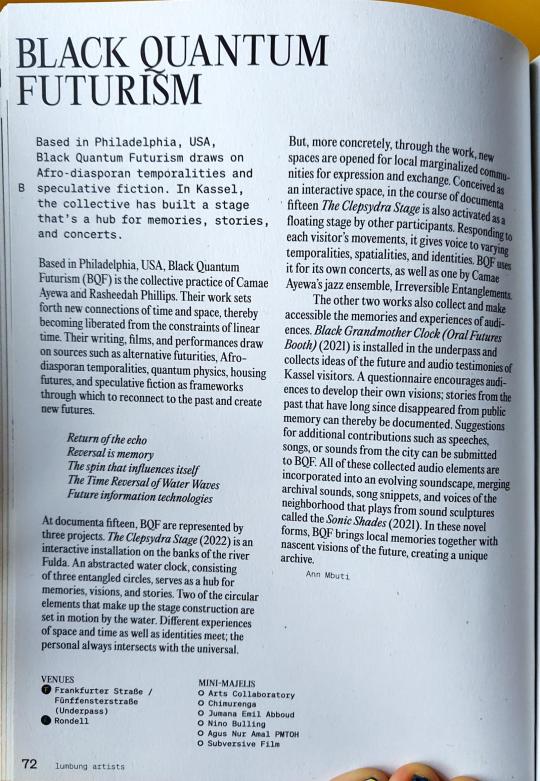
youtube
Watch Night Service was a performance with Irreversible Entanglements and lumbung artist Black Quantum Futurism on the Clepsydra stage floating on the Fulda River, in honor and memory of Juneteenth. Juneteenth (also known as Freedom Day or Emancipation Day) is a celebration created by formerly enslaved Black people of Galveston, Texas to mark their liberation two years after the Emancipation Proclamation claimed to end slavery. The performance entangled complex and often startling interrelationships of meaning and message between different modes of time, Black histories, and their implications for Black futures through a galvanizing synthesis of speech, sound, and sensation. It took place on the Clepsydra Stage, created by Black Quantum Futurism for documenta fifteen and installed on the Fulda River. “Wading/waiting in the water was an act in the war for liberation that created a temporary time portal, a vortice of protection. To wait in the water, to stop, to rest against the current, to submerge the Master’s clock, is a revolutionary act within a revolutionary act of escape.” – Black Quantum Futurism More about Black Quantum Futurism: https://documenta-fifteen.de/en/lumbu...
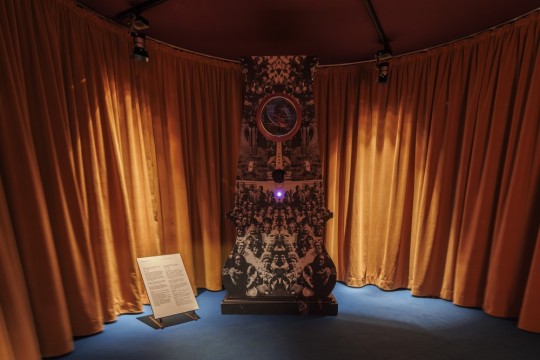
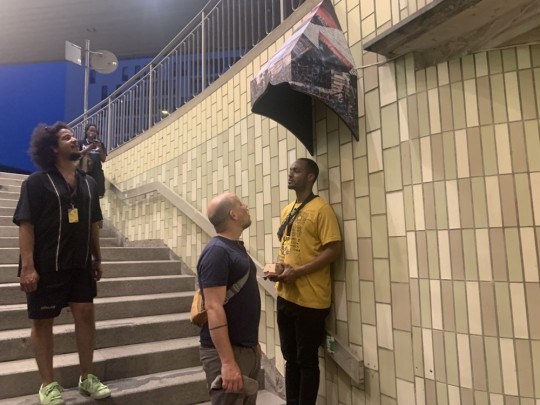
"At Documenta 15, BQF present three projects. Along the Fünffensterstraße/Frankfurter Straße underpass, the time-space travel capsule Black Grandmother Clock (Oral Futures Booth) (2021) offers a series of prompts to Kassel locals and visitors and invites them to record their oral stories around communities, housing, and neighbourhoods. The ever-growing soundscape archive brings together local memories with visions of the future, registering undocumented stories for the public memory.
Activated upon standing underneath, the adjacent sound sculpture Temporal Confessional (2021) incorporates three soundscapes that feature interviews between Rasheedah Phillips and CERN physicists merged with sound field recordings of the laboratory’s technological landscapes. The audio installation calls forth all the possible worlds that quantum physics offers beyond the limitations of traditional, linear notions of time. To confront issues of temporality afforded by the prime meridian, Black Quantum Futurism also installed posters in the Fünffensterstrasse from their ongoing research project timezoneprotocols.space, claiming ‘Restore Black Temporal Realities’; ‘We demand temporal reparations. Yesterday, now and tomorrow!’.
Ciudad Abierta (Open City)


The Open City, located on the dunes of Ritoque, north of Valparaíso, arises from the need of its founders and inhabitants to have a space to develop, in the light of Amereida, the project of combining life, work and study from of the encounter between poetry and crafts. The place is an area of 270 hectares located 16km north of Valparaíso. Its land includes an extensive dune field, wetlands with an extraordinary diversity of flora and fauna, a beach border of more than 3 kilometers, ravines and fields.
It was founded in 1970 by poets, architects, designers, sculptors, philosophers and artists largely from the School of Architecture of the Catholic University of Valparaíso, as well as from Latin America and Europe. Its origin is found in the Amereida Journey, a trip made by a group of them in 1965, who, traveling the American continent from Tierra del Fuego to Santa Cruz de la Sierra in Bolivia, questioned themselves about the meaning of America; to then understand and propose, in the poem of Amereida, (the Aeneid of America) a way of living and being American. From the journey and the poem, the Open City is constituted as a landmark or “milestone of America”, which facing the Pacific Ocean, gives rise to poetry in action and by voice, first constructing the public space of the agoras ( place to talk), then the inns (place to live), later the spaces that link (places to visit), and the cemetery.
All this occurs in the creative meeting of life, work and study; unity that becomes possible in the exercise of hospitality, between its citizens and inhabitants, with guests and visitors; until the present. The Amereida Cultural Corporation is today the legal face of the Open City. ( Taken from:https://www.ead.pucv.cl/espacios/ciudad-abierta/ )
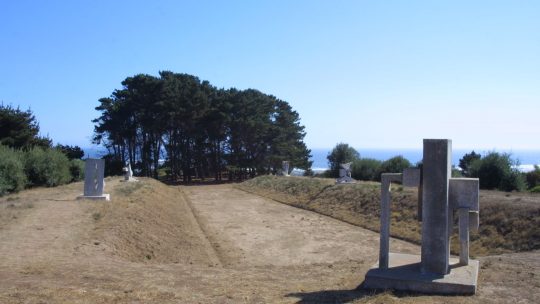
Agora of the guests

"The Open City is a Chilean architectural experimentation field, located in the Punta de Piedra sector, in the town of Ritoque, Quintero Commune, Valparaíso Region. History In 1969, the professors and students of the School of Architecture of the Catholic University of Valparaíso formed the Amereida Cooperative. In 1971, the Cooperative purchased an area of land of about 300 hectares,1 north of the Aconcagua River, composed of a dune field, wetlands, ravines, fields and adjacent to the beach for 3 kilometers,2 making up the land where today The Open City is located. Various works of architecture and design are built in this field of experimentation." (...)
"Si bien Amereida no es un proyecto político, poéticamente es altamente revolucionario".5
El poeta chileno Manuel Sanfuentes, miembro de la comunidad, describe así el paisaje y la manera de intervenir en este:
"La mitad de la Ciudad Abierta son dunas. Es un paisaje muy abstracto. Y la duna tiene la gracia de que tus huellas se borran. Vuelves al otro día y la duna está intacta. Ellos nombraron esto como el volver a no saber. El modo de emprender las obras de la Ciudad Abierta pasa siempre por volver a no saber".6Victoria Jolly and Javier Correa, curator of the show La invención de un mar: Amereida 1965-2017 en el Museo de Bellas Artes de Santiago
(taken from wikipedia)
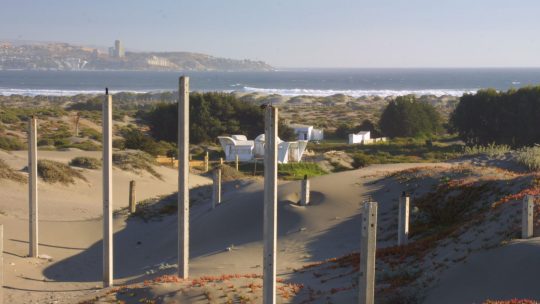

“It is a city, with houses and cemeteries and temples, very special ones, made in the Universidad Católica de Valparaíso. It was really successful and really important for our generation, because in the middle of postmodernism in our school there was a sign that was really important, throughout this really boring architecture: and it was a really good exercise for them. And I think right now it’s not really powerful, but it’s still there in the imaginary, it’s still there working for us in our memory”.
These are the words of Chilean architect Smiljan Radic, in dialogue a few years ago with Hans Ulrich Obrist on the pages of Domus (1020, January 2018) evoking the Ciudad Abierta (Open City), an experience of community and education that to this day remains unique, and above all to this day is still alive and evolving, born in 1971 not far from Valparaíso, surviving the darkness of the dictatorship and the tendency – typical of all Bauhaus-like circles – to crystallise and statically preserve what was once born as a set of revolutionary principles.
How could this happen? The answer lies in the nature of the Ciudad itself, of a community born in Ritoque, not far from Valparaíso, in the rejection of the Beaux-Arts and treatise-style teaching of architecture at the instigation of Professor Alberto Cruz and of poet Godofredo Iommi; an idea of community that abandons Eurocentrism to re-centre its cultural geographies on America, building them on the creation of a poetic journey called Amereida, and that in a totally horizontal and collective dimension brings together students and teachers (role denominations that immediately lose their hierarchical meaning and significance) around the creation of poetic acts that could eventually be translated into architecture.
Poetry is the way to disclose, to understand, the real and the possible, it is something completely open and transient like the sand of the dunes on which the Ciudad Abierta has been welcoming travellers and new members for more than 50 years, in a city visibly lacking a normed and recognisable form; a vision of existence and coexistence that in February 1997 led Domus to choose this experience as a manifesto of social sustainability, a model for the urban communities of the future, to investigate in issue 789, entirely dedicated to the challenge of Designing Sustainability.
Open City, Valparaiso, Chile
The construction of a new town near Valparaiso in Chile has been going on now for over 25 years. To be more precise it is a model of a town, designed and built on the initiative of the School of Architecture at the University of Valparaiso. It is based on the poetic idea of dwelling the threshold, a no-man’s land, and the creative use of existing resources. The aim is to develop an architectural model that can re-define the identity of a South American town and at the same time use space and materials to generate a new form of urban life and community.
(taken from Domus: https://www.domusweb.it/en/from-the-archive/gallery/2022/10/25/ciudad-abierta-building-a-community-from-acts-of-poetry%20.html )

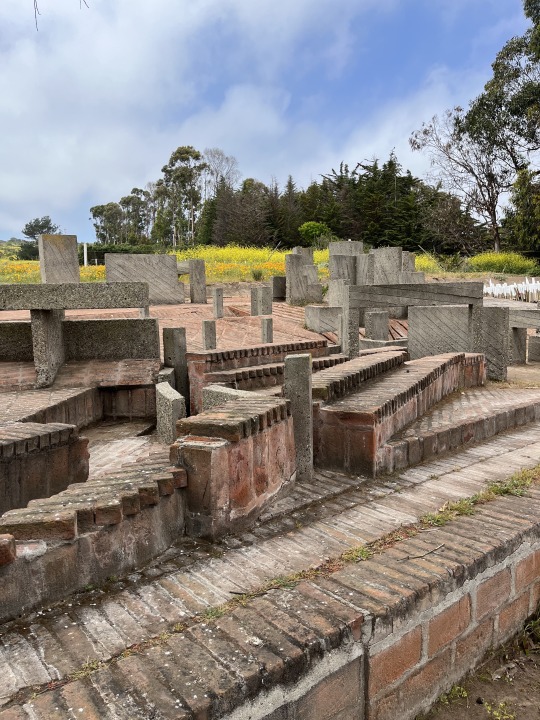
Pope L.
The Whispering Campaign

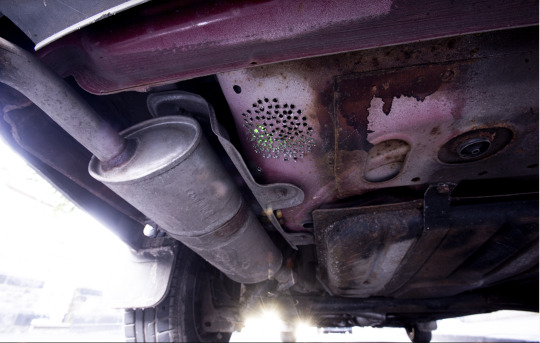
"William Pope.L, a Chicago-based performance artist known for his interventions in cityscapes, has produced a new work to address the liminal status of refugees and immigrants, specifically for documenta 14. For the first time, documenta, which has taken place every five years in Kassel, Germany since 1955, was also held in a secondary location, Athens, Greece. Pope.L’s VIA-supported project, entitled Whispering Campaign, is a sound installation of whispers emitted through speaker systems, installed both in public spaces and on mobile maintenance trucks, disseminating their content throughout the streets and in restaurants, bars, shopping centers, public transit, and more.
Whispering Campaign first premiered in Athens (April 6) and remained there through July 16, 2017. Simultaneously, the work launched in Kassel on June 10 and remained on display for the respective 100-day duration of documenta 14. Having interviewed migrants in both cities, Pope.L interweaves their stories with local mythology, poetry, and rhythmic, non-narrative elements in his “whispers.” These pre-recorded elements were supplemented by scheduled live performances throughout each 100-day period." (taken from: https://viaartfund.org/grants/pope-l-whispering-campaign/ )
"Pope.L’s contribution took on the guise of an immersive, seemingly omnipresent sound installation titled Whispering Campaign, consisting of thousands of hours of whispered content—addressing nationhood and borders—broadcast throughout Athens and Kassel using both speakers and live “whisperers.” (taken from: https://shop.deappel.nl/products/pope-l-campaign )
Performers spread whispers in the street—adding an unpredictable, living dimension to this wide-spread audio work, which quietly charts a minor history of the city.

The “Whispering Campaign” will run for the 100 days in both Athens and Kassel. Five performers will wander throughout designated areas of the city either broadcasting a pre-recorded score in English, Greek and German or whispering live their observations as they roam the city.
Performances occur Tuesdays, Thursdays, and Saturdays in designated areas throughout both cities. In addition to the live performances occurring three days a week, there will be several broadcasts of the pre-recorded text will play at select documenta 14 venues. (taken from: https://www.miandn.com/news/pope-l-in-documenta142 )
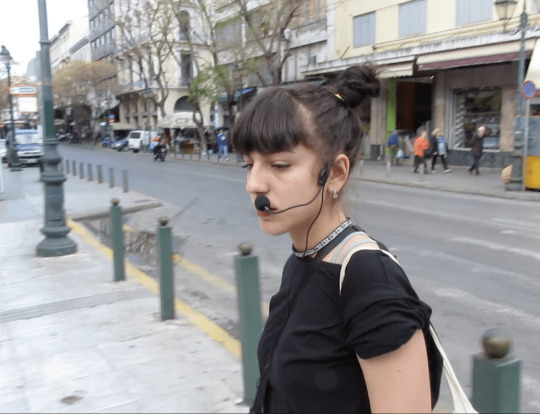
b. 1955, Newark, NJ
Lives and works in Chicago, IL
Pope.L is a visual artist and educator whose multidisciplinary practice uses binaries, contraries and preconceived notions embedded within contemporary culture to create art works in various formats, for example, writing, painting, performance, installation, video and sculpture. Building upon his long history of enacting arduous, provocative, absurdist performances and interventions in public spaces, Pope.L applies some of the same social, formal and performative strategies to his interests in language, system, gender, race and community. The goals for his work are several: joy, money and uncertainty— not necessarily in that order. (taken from: https://www.miandn.com/artists/pope-l )


0 notes
Text
Hannah Arendt
i(14 October 1906 – 4 December 1975) Germany - USA.
A political philosopher, author, and Holocaust survivor. She is widely considered to be one of the most influential political theorists of the 20th century. In 1998 Walter Laqueur stated "No twentieth-century philosopher and political thinker has at the present time as wide an echo", as philosopher, historian, sociologist and also journalist. Arendt's legacy has been described as a cult.

THE HUMAN CONDITION
The Human Condition, written by Hannah Arendt and originally published in 1958, is a work of political and philosophical nonfiction. Arendt, a German-American philosopher and political theorist, divides the central theme of the book, vita activa, into three distinct functions: labor, work, and action. Her analyses of these three concepts form the philosophical core of the book. The rest of the book is historical in approach.
NOTES:
Vita activa: are 3 fundamental human activities
LABOR
WORK
ACTION
Vita activa is a different to the ultimate way of life of the vita contemplativa - the only truly free way of life.
“The primacy of contemplation over activity rest on the conviction that no human hands can equal in beauty and truth the physical kosmos, which swings in itself in changeless eternity without any interference or assistance from outside, from man or god. This eternity discloses itself to mortal eyes only when all human movements an activities are at perfect rest.
Contemplation was the philosopher’s way of life.
Theoria or “contemplation”, is the word given to the experience of the eternal, as distinguished from all other attitudes, which at most must pertain to immortality.
LABOR: Activity related to biological processes of the body.
-Greeks considered that the labor of our bodies needed by the needs of our bodies (metabolism, survival, food, warmth, etc) was slavish (submissive, passive, servil).
-To labor meant to be enslaved by necessity.
-Labor deals with the tasks that sustain our existence as animals.
WORK: Activity related to the unnaturalness of human existence, -to the world of things- different to the natural surroundings of the environment.
-Artificial.
LABOR OF OUR BODIES IS DIFFERENT TO THE WORK OF OUR HANDS
The work of our hands fabricates the unending variety of things constituting the human artifice (chairs, beds, buildings, cars, etc)
Arendt uses the Latin phrase homo faber (human being the maker) in contrast to labor’s animal laborans. For Arendt, without this distinction, humanity is reduced to animals restricted to the biological processes that merely sustain life (labor) without building a world (work).
ACTION: Activity that happens between people.
-Relation.
-We do not live alone.
-In birth the new comer possesses the capacity to start something anew that is: OF ACTING.
For Arendt, action encompasses both acts or deeds and speech. Like an act, speech reveals the specificity of its agent to others. Action is what makes us human, even more so than work.
THE HUMAN CONDITION OF LABOR IS LIFE ITSELF.
THE HUMAN CONDITION OF WORK IS WORLDLINESS.
THE HUMAN CONDITION OF ACTION IS PLURALITY.
All human conditions are related to politics, yet plurality is the ground of all political life.
All these activities are related to birth and death.
-Labor assures not only individual survival, but the life of the species.
-Work and its products assure and procure the human artifact that transcends life.
-Action engages in founding and preserving political bodies = which leads to remembrance and history.
Hanna Arendt argues: Humans are conditioned beings because everything they come in contact with turns immediately into a condition of their existence.
TERM VITA ACTIVA: a life devoted to public - political matters.
(Politics (from Greek: Πολιτικά, politiká, 'affairs of the cities') is the set of activities that are associated with making decisions in groups, or other forms of power relations among individuals, such as the distribution of resources or status. The branch of social science that studies politics and government is referred to as political science.) from wikipedia
THE PUBLIC AND THE PRIVATE REALM
Vita activa is rooted in a world of humans.
Things and people form the environment for human’s activities.
World made by humans includes:
-Produced environment.
-Cared for cultivated land
-organization of the city - body politic.
All activities happen in the society of people, of humans; mainly action which can only happen with the company of others.
SOCIAL: alliance of people for a specific purpose
The social has a political meaning.
(Roman word that then became a human condition)
For the greeks, human capacity for political organization stands in direct opposition to natural association whose center is the home and the family.
With the rise of the city-state man received a second life besides his private life, that of the bios politikos - political life-.
Every citizen belongs to two orders: their own and the communal.
Aristotle - of all human activities only two constitute the bios politikos:
SPEECH (Lexis)
ACTION (Praxis)
*from these two activities rise the realm of human affairs. In this realm anything that is necessary (for existence) or useful (for worldliness) is excluded.
-so labor and work are excluded from this realm.
-Thought was secondary to speech but speech and action were equal in importance.
-Through speech one exercises action.
-In the experience of the polis (polis = city-state) everything was decided through words and persuasion, not with force and violence.
-Violence and force were considered pre-political.
Aristotle - everybody outside the polis (slaves and barbarians - family included) was deprived of the way of life in which speech was the main concern for citizens.
to talk to each other, to make decisions together.
-In the polis - in the political realm - nothing was absolute nor uncontested.
While in the household the paterfamilias (father of the household) ruled over the household, over slaves and over the family.
*What was said by the paterfamilias was absolute and could not be contested.
The distinction between the public and the private spheres were then concieved as the political realm and the household.
+The social sphere is neither private nor public, it was born in modern age with the nation-state. Seen as: the collection of families economically organized into the copy of one super-human family is what we call “society” and its political form of organization is called Nation.
+Keep in mind: In ancient Greece whatever was economic or related to the life of the individual and the survival of the species was a NON POLITICAL, it referred to a household affair by definition.
-Historically, the rise of the public realm and the city-state happened at the expense of the private state, the family and the household.
-Households and private lives were not interfered by the polis because without owing a house a man could not participate in the affairs of the world because he would not have a location of his own on the world.
HOUSEHOLD - in it men live together because they are driven by wants and needs.
individual maintenance and survival of the specie needs the company of others.
Men - individual maintenance (nourish)
Women - species survival (birth)
All encompassed by NECESSITY.
While the realm of the polis was FREEDOM
The mastering of the necessities of life in the household was the condition for freedom in the polis.
Politics not only to protect society, but to protect “freedom” or (freedom?) of society.
Protect via (or justify) restraint of political authority.
HOWEVER:
-Freedom only in public realm
-necessity considered pre-political and bound to private households.
-Force and violence are justified in private because they are the only means to master necessity and become free.
Wealth and health= MEN ONLY
-To be pour or ill meant to be subject to physical necessity.
-To be a slave meant to be subject to physical necessity and be subject to man-made violence.
+In the polis (city-state/public realm) there could only be equals. Equals as in peers, men who owned a home and had a family.
+In the household there was the most strict inequality.
To be free meant to:
-not be subject of necessity of life
-not under command of another
-not in command of oneself.
*In the household freedom did not exist
To be FREE meant to be free from the inequality present in rulership and to move in a sphere where ruling or being ruled did not exist.
In the modern world the division of household and public life is blurred with the rise of society. That is, the rise of the household and economic activities to the public realms.
House keeping, the private and the family became collective concerns.
Private interests assumed public significance = SOCIETY
THE RISE OF THE SOCIAL
The emergence of society - the rise of houskeeping, its activities, problems and organizational devices into the public sphere changed the meaning of the public and the private.
Greeks: thought that a life spent in ‘one’s own’ was idiotic
Romans: thought privacy offered a temporary refuge for business (res publica)
Modern Age: Private if the sphere of intimacy.
-In ancient feeling the privative trait of privacy indicated being deprived of something - the highest and most human capacities - RELATION.
A man who lived only only in private life, who like the slave was prohibited to enter the public realm or the barbarian who chose not to establish such a realm were not fully human.
In modern age: social matters are not part of the private realm, because they pertain to the political.
In modern age: the intimate is the opposite to the social.
Explorer and theorist of Intimacy Jean-Jaques Rousseau characteristically rebelled against society’s perversion of the human heart.
Jean Jacques Rousseau (1712-1778)
Romanicism: Romanticism (also known as the Romantic movement or Romantic era) was an artistic, literary, musical, and intellectual movement that originated in Europe towards the end of the 18th century, and in most areas was at its peak in the approximate period from 1800 to 1850. Romanticism was characterized by its emphasis on emotion and individualism, clandestine literature, idealization of nature, suspicion of science and industrialization, and glorification of the past with a strong preference for the medieval rather than the classical.[1] It was partly a reaction to the Industrial Revolution,[2] the social and political norms of the Age of Enlightenment, and the scientific rationalization of nature.(wikipedia)
-The intimacy of the heart has no place in the world.
(I say: one’s body?)
To Rousseau both intimate and social were subjective modes of human existence.
Rebellion of the heart means: individual endless conflicts, inability to be at home in society or live outside of it, ever changing moods, radical subjectivism of emotional life.
Romanticist against society occurred with the discovery of intimacy and it first rebelled against the leveling demands of the social.
Said to be the conformism of society (negative connotation).
these demands were: Its members must act as though they were members of one great family with one opinion and interest.
She mentions: before the concept of equality existed.
Rise of the social = the decline of the family
Arendt -Family was absorbed by corresponding social groups.
*Society excludes the possibility of action - society expects from each of its members a certain kind of behavior by imposing rules which tend to normalize its members.
-Make them behave
-Exclude spontaneous action
-Exclude outstanding achievements.
*conventions are created that frae social status:
RANK in the half-feudal society
CLASS in the 19th Century society
FUNCTION in mass society of the 20th Century.
In mass society the realm of the social embraces and controls all members of the community equally and with equal strength.
Equality in modern world (1950s when the book was written) is: political and legal recognition that society has conquered the public realm and that distinction and difference are private matters of the individual.
In modern age: behavior replaced action as a mode of human relations.
In ancient Greece: Equality meant permitted to live amongst peers, but in the polis it every man distinguishing himself from others with their achievements - showing off.
Public realm was reserved for individuality, to show who they really were.
Due to this reason, they would agree to share the burden of jurisdiction, defense and administration of the public affairs.
Ancient Greeks: they did not find meaningfulness in the everyday but in rare deeds and highlighted achievements and life events.
Arendt - critical to the establishment of behavior over action.
The application of the law in large numbers over politics and history eliminated their very subject matter. Hopeless to search for meaning in politics and history when everything that is not behavior or trend is immaterial.
In regards to the large numbers of a growing society, the Greeks knew their system based on speech and action could only happen in a small city-state scale.
Large numbers of people lead to despotism: either one person rule or a majority rule.
The unfortunate truth about behaviorism is that the more people, the less likely to tolerate non-behavior.
The rise of the social - tendency to grow and devour other realms: the public, the private and the intimate.
Modern age -There was a shift in what was understood as society: “turned all moern communities into laborers and job holders, in other words, they became centered around the once activity necessary to sustain life.
The mutual dependence between people for the sake of life. All activities related to the survival were permitted to appear in the public.
Labor rises to public status
-Labor is a process: it got liberated from the monotonous and circular to a progressive development, a process. This changed the “inhabited” world.
The constantly growing social realm left the public, the intimate and the private relegated.
Constantly growing social realm means that it had an accelerated increase in the productivity of labor.
This growth factor happened due to the organization of laboring and the division of labor.
*Division of labor as in innumerable minute manipulations and development of skills - professionalization
+This could only happen in the realm of the public, because it is there that one can attain excellence. Excellence is assured by being public with others.
+We have become excellent in laboring performance, but our capacity of speech and action lost quality.
-It went to the intimate and the private.
*no activity can become excellent if the world does not provide a proper space for its exercise.
No ingenuity, talent or education can replace the public realm where human excellence can be achieved.
THE PUBLIC REALM: THE COMMON
The term Public means two things:
1st: everything that appears in public can be seen and heard by everybody and has the widest possible publicity.
-Appearance - The something that is being seen and heard by others as well as by ourselves—constitutes reality.
public = Reality.
Reality in the passions of the heart, the toughts of the mind and the delights of the sences have an uncertain existance compared to appearing in public.
To bcome public they are transfored, deprivatizedf and deindividualized to fit public appearance.
examples: in storytelling and art.
But not only: “Each time we talk about things that can be experienced only in privacy or intimacy, we bring them out into a sphere where they will assume a kind of reality they didnt have before.”
The presence of other assure the reality of the world and of ourselves.
While the intimacy of a fully developed private life will intensify and enrich the scale of subjective emotions and feelings, this intensification will always come to pass at the expense of the assurance of the reality of the world and others.
PAIN:
Indeed, the most intense feeling we know of, intense to the point of blotting out all other experiences, namely, the experience of great bodily pain, is at the same time the most private and least communicable of all. Not only is it perhaps the only experience which we are unable to transform into a shape fit for public appear- ance, it actually deprives us of our feeling for reality to such an extent that we can forget it more quickly and easily than anything else. (...) the most radical subjectivity, in which I am no longer "recognizable," to the outer world of life. Pain, in other words, truly a borderline experience be- tween life as "being among men" {inter homines esse) and death, is so subjective and removed from the world of things and men that it cannot assume an appearance at all.
Not everything can appear in the public space, only what is considered to be relevant and worthy of being seen and heard.
Irrelevant becomes a private matter.
HOWEVER: not all private matters are irrelevant. ex. LOVE.
“Love, in distinction from friendship, is killed, or rather extinguished, the moment it is displayed in public.”
Reason: “love can only become false and perverted when it is used for political purposes such as the change or salvation of the world.”
Shift in what is considered to be great: “This enlargement of the private, the enchantment, as it were, of a whole people, does not make it public, does not constitute a public realm, but, it means that the public realm has almost com- pletely receded, so that greatness has given way to charm everywhere; for while the public realm may be great, it cannot be charming precisely because it is unable to harbor the irrelevant.”
2nd the therm public means:
Signifies the world itself, in so far as it is common to all of us and distinguished from our privately owned place in it.
This world is not identical with the earth or with nature. It is related to the human artifact, the fabrication of human hands, as well as to affairs which go on among those who inhabit the man-made world together. The To live together in the world means essentially that a world of things is between those who have it in common, as a table is located between those who sit around it; the world, like every in-between, relates and separates men at the same time.
The public realm, as the common world, gathers us together and yet prevents our falling over each other
In mass society: The world between them has lost its power to gather them together, to relate and to separate them.
Interesting metaphor: “ The weirdness of this situation resembles a spiritualistic seance where a number of people gathered around a table might suddenly, through some magic trick, see the table vanish from their midst, so that two persons sitting opposite each other were no longer separated but also would be entirely unrelated to each other by anything tangible.”
the existence of a public realm and the world's subsequent transformation into a community of things which gathers men together and relates them to each other depends entirely on permanence. If the world is to contain a public space, it cannot be erected for one generation and planned for the living only; it must transcend the life-span of mortal men.
-Without this transcendence into a potential earthly immortality, no politics, strictly speaking, no common world and no public realm, is possible.
-”The common world is what we enter when we are born and what we leave behind when we die. It transcends our life- span into past and future alike; it was there before we came and will outlast our brief sojourn in it. It is what we have in common not only with those who live with us, but also with those who were here before and with those who will come after us.”
-This transcendence of the common world only survives because it appears in public.
-Through many ages before us—but now not any more— men entered the public realm because they wanted something of their own or something they had in common with others to be more permanent than their earthly lives.
*She exemplifies what was done during slavery: not only deprived of freedom and visibility, but also after death there would be no trace that they had existed.
Modern age: loss of authentic concern with immortality and eternity. (Space search?) - regarded as vanity
The philosopher’s vita contemplativa’s main concern was eternity.
Modern age - public admiration and monetary reward.
Public admiration and status are consumed too. They fulfill one’s needs. Public admiration is consumed by ones own vanity.
In Modern age reality does not lie in the public presence of others, but in peoples own needs, needs that can be assured by others but by those who suffer them.
Public admiration and monetary reward are futile (pointless), yet they became more objective and real in modern age.
Money became the fulfillment of all needs.
However, “objectivity” implied before “simultaneous presence of innumerable perspectives and aspects in which the common world presents itself and for which no common measurement or denominator can ever be devised.”
“Only where things can be seen by many in a variety of aspects without chang- ing their identity, so that those who are gathered around them know they see sameness in utter diversity, can worldly reality truly and reliably appear.”
Under the conditions of a common world, reality is guaranteed by the differences of position and the resulting variety of perspectives while everyone is concerned with the same object.
Modern age: men have become entirely private, that is, they have been deprived of seeing and hearing others, of being seen and being heard by them. They are all imprisoned in the subjectivity of their own singular experience, which does not cease to be singular if the same experience is multiplied innumerable times. The end of the common world has come when it is seen only under one aspect and is permitted to present itself in only one perspec- tive.
1 note
·
View note
Text
P3 - Mapping Theory
Read before class and bring questions or segments that they would like to discuss in class:
1 “Cartography as Power” by Jeremy Black until the last paragraph of page 10 of the PDF (page 20 of the article) where it’s marked.
Dual naming - recognition of indigenous names in Australia:
youtube
youtube
youtube
Read in class:
2 “Urban Landscape History-the sense of place and the politics of space” by Dolores Hayden.
Excerpts from Doreen Massey Space, Place and Gender, University of Minnesota Press Minneapolis, 1994:
“The central thread linking the papers is the attempt to formulate concepts of space and place in terms of social relations.”
“Central to that paper is the argument that space must be conceptualized integrally with time; indeed that the aim should be to think always in terms of space-time. That argument emerged out of an earlier insistence on thinking of space, not as some absolute independent dimension, but as constructed out of social relations: that what is at issue is not social phenomena in space but both social phenomena and space as constituted out of social relations, that the spatial is social relations 'stretched out'.”
“The initial impetus to insist on this came from an urge to counter those views of space which understood it as static, as the dimension precisely where nothing 'happened', and as a dimension devoid of effect or implications.”
“There is no holding nature still.' Physics, since the beginning of the century, had been advocating similar views. Thus Minkowski:
The views of space and time which I wish to lay before you have sprung from the soil of experimental physics, and therein lies their strength. They are radical. Henceforth space by itself, and time by itself, are doomed to fade away into mere shadows, and only a kind of union of the two will preserve an independent reality.3 The view, then, is of space-time as a configuration of social relations within which the specifically spatial may be conceived of as an inherently dynamic simultaneity. Moreover, since social relations are inevitably and everywhere imbued with power and meaning and symbolism, this view of the spatial is as an ever-shifting social geometry of power and signification.
Such a way of conceptualizing the spatial, moreover, inherently implies the existence in the lived world of a simultaneous multiplicity of spaces: cross-cutting, intersecting, aligning with one another, or existing in relations of paradox or antagonism. Most evidently this is so because the social relations of space are experienced differently, and variously interpreted, by those holding different positions as part of it.”
“The spatial' then, it is argued here, can be seen as constructed out of the multiplicity of social relations across all spatial scales, from the global reach of finance and telecommunications, through the geography of the tentacles of national political power, to the social relations within the town, the settlement, the household and the workplace. It is a way of thinking in terms of the ever-shifting geometry of social/power relations, and it forces into view the real multiplicities of space-time. It is a view of space opposed to that which sees it as a flat, immobilized surface,8 as stasis, even as no more than threatening chaos - the opposite of stasis - which is to see space as the opposite of History, and as the (consequently) de- politicized. The spatial is both open to, and a necessary element in, politics in the broadest sense of the word.”
“Briefly, it seemed to me that such political and academic positions all rested on a particular view of place. It is a view of place as bounded, as in various ways a site of an authenticity, as singular, fixed and unproblematic in its identity. It is a conceptualization of place which rests in part on the view of space as stasis.
If, however, the spatial is thought of in the context of space-time and as formed out of social interrelations at all scales, then one view of a place is as a particular articulation of those relations, a particular moment in those networks of social relations and understandings (see 'A global sense of place' and 'A place called home?').9 But the particular mix of social relations which are thus part of what defines the uniqueness of any place is by no means all included within that place itself.10 Importantly, it includes relations which stretch beyond - the global as part of what constitutes the local, the outside as part of the inside. Such a view of place challenges any possibility of claims to internal histories or to timeless identities. The identities of place are always unfixed, contested and multiple. And the particularity of any place is, in these terms, constructed not by placing boundaries around it and defining its identity through counter- position to the other which lies beyond, but precisely (in part) through the specificity of the mix of links and interconnections to that 'beyond'. Places viewed this way are open and porous.11
“The argument here is that we must not only recognize these changes in the spatial organization of social relations but must also, in consequence, rethink the unity of space and place in different terms, thereby concep- tually confronting in a constructive way this changed state of the world. Indeed, Edward Said, in his second Reith Lecture, delivered while I was writing this introduction, argued that rejecting such notions of place- identity must be a central task for intellectuals today:
With regard to the consensus on group or national identity, it is the intellectual's task to show how the group is not a natural or god-given entity but is a constructed, manufactured, even, in some cases, invented object, with a history of struggle and conquest behind it, that it is sometimes important to represent.13
-----------
For homework: Find one photograph of a space/place that interests you and analyze it in terms of gender, race, class, sexuality, age, etc.
There are more references for the micro assignment here. https://2223.mywdka.nl/WDKP31APPP/references/Read the text:
References:
https://www.queeringthemap.com/

Stanley Brouwn - This way Brouwn
Dutch artist, born in Paramaribo, Suriname. From 1957 onwards he worked as an artist in Amsterdam. He provides no biographical information, gives no interviews and does not permit reproduction of his work. He only says that ‘the work provides the interviews, writes the biography’. Since 1960 he has been preoccupied with the idea of measurement and the relationship to the body’s movements. The series of drawings this way brouwn, made from 1961 onwards, was based on directions provided by passers-by. These were then impressed with a printed rubber stamp bearing the title. including obsolete ones. For instance, in an exhibition at the Centro Andaluz de Arte Contemporáneo in 2005 he used the old Castilian foot abolished in 1849 when the metric system was made compulsory in Spain. R. H. Fuchs writes of him: ‘The work is not imagination; it is fact’ (Dutch Painting, 1978).


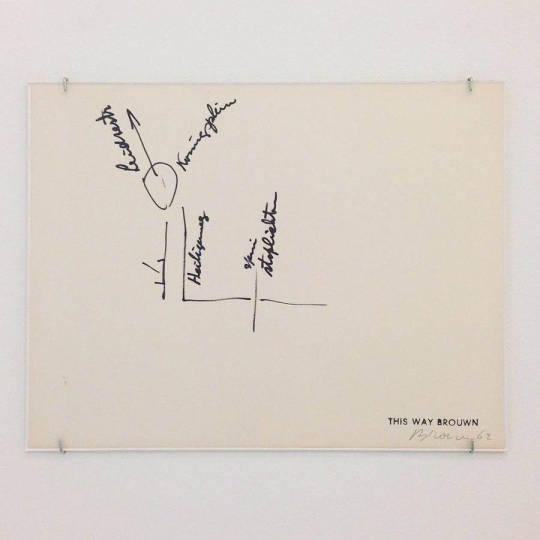
His conceptual works deal with distances, measurements, or spaces between two points, persons, and places, but also, in line with his most well known artist’s book This Way Brouwn, with paths. For his layout sketches, he asked passers-by he accidentally met on the street to make a sketch of from memory of certain distances they had covered. Indeed, for Stanley Brouwn, motion, dealing with distances in space and time are the primary material for his artistic activity. He examines this fundamental human activity in ever new contexts and measures distances according to his own units of measure, such as the Brouwn cubit, the Brouwn foot, or the Brouwn step. In 1976 he published his artist’s book 1m 1step, which consists of two lines—one the length of a (his) step, the other one meter long. Thus his own, subjective unit of measurement (the sb foot, the sb cubit, the sb step) is in opposition to a generally acknowledged, universal metric system or an—outdated—local unit of measurement.

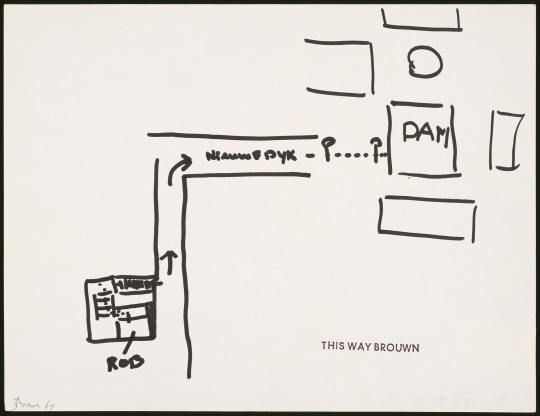
Anti-gentrification maps and messages to tourist
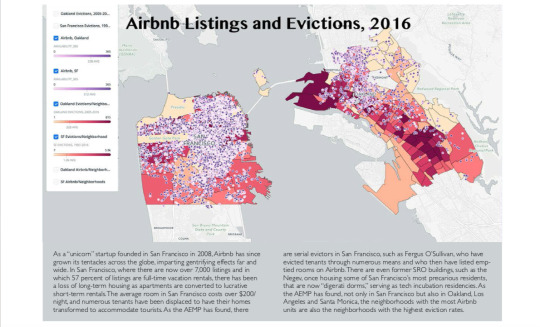

This Is Not an Atlas - A Global Collection of Counter-Cartographies
A New Social Cartography1
Defending Traditional Territories by Mapping in the Amazon
Projeto Nova Cartografia Social da Amazônia – Alfredo Wagner Berno de Almeida, Sheilla Borges Dourado, Carolina Bertolini
novacartografiasocial.com

This Is Not an Atlas - A Global Collection of Counter-Cartographies
While New York City politicians rhetorically prioritize urban ag- riculture and public space, 596 Acres actually fills the gap between place and the people in our neighborhoods. 596 Acres sees – and teaches others to see – empty spaces as sites of opportunity, both for potential green spaces in neighborhoods that lack them, and as focal points for community organizing and civic engagement.
In January 2015, when the City published a list of 181 "hard-to-develop" properties they were willing to sell for $1 to housing developers to build pretty expensive housing, we analyzed the list and found out that it included 18 community gardens, six of which had formed through our support. We published a map and called the impacted gardeners, tapping into and expanding our network, while arming the impacted residents with the tools to advocate for the preservation of the existing community spaces (see map at the end of the article).
Within three weeks, over 150 New Yorkers, including four City Council members, rallied on the steps of City Hall (Tortorel- lo, 2015). A year-long campaign followed. It included Communi- ty Planning Boards, City Council and advocates in every level of the administration. On 30 December 2015 the NYC Departments of Parks and Housing Preservation and Development agreed to permanently preserve fifteen of the gardens on the for-sale list; community pressure was so great that the announcement extend- ed to community spaces that were not even on-offer to develop- ers in January: In total, 36 community spaces were permanently preserved as a result of information-driven advocacy – the fourth wave of major garden preservation successes in NYC history.

https://livinglotsnyc.org/#11/40.7181/-73.9510
This Is Not an Atlas - A Global Collection of Counter-Cartographies
X-Ray of Soy Agribusiness in the Pampa and Mega-Mining in the Andes1
Iconoclasistas – Julia Risler, Pablo Ares
iconoclasistas.net
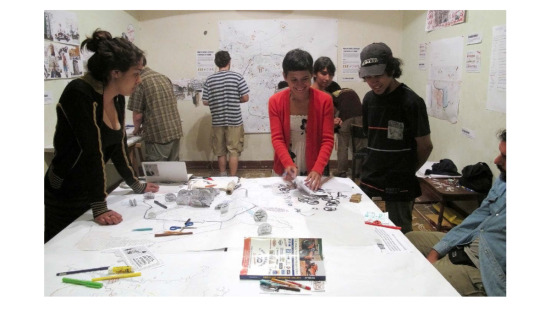
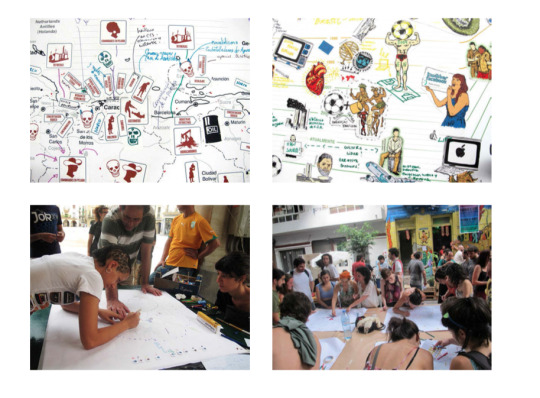
This Is Not an Atlas - A Global Collection of Counter-Cartographies
We are a duo formed in 2006. We combine graphic art, creative workshops and collective research to produce activist resources that can be circulated, used and appropriated freely. Through designing and carrying out workshops, we seek to strengthen the communication between activists, to set up networks of solidarity and affinity, and to promote collaborative practices of resistance and transformation. Through this dynamic web of affinity and solidarity, built by sharing and promoting open projects and collective workshops in Argentina, Latin America and Europe, our practice keeps on spreading.
"The Map Is Not the Territory"2
When we talk about local territories, we don't just mean the phys- ical space in which we find ourselves, but also the social body and rebel subjectivities. Mapmaking is one of the principal tools em- ployed by the dominant powers to appropriate territories for util- itarian purposes. This happens not just as a form of spatial plan- ning but also to set borders that define new occupations and plan strategies of invasion, plunder and appropriation of communal property. As such, the maps commonly circulating in our societies are based on a vision that is imposed onto territories by the domi- nant powers in order to create hegemonic representations of space. These are functional to the development of the capitalist model, rationally decoding the land, classifying natural resources, demo- graphic characteristics and the type of production that can most effectively transform labor power and resources into capital.
But the map is not the territory. A connection with a particular territory is established through processes of interpretation, feel- ings and personal experiences. Maps are not the territory because they are unable to account for the subjectivity of the territorial processes, symbolic representations and imaginations inherent to them and the constant mutability and changes they are subject to.
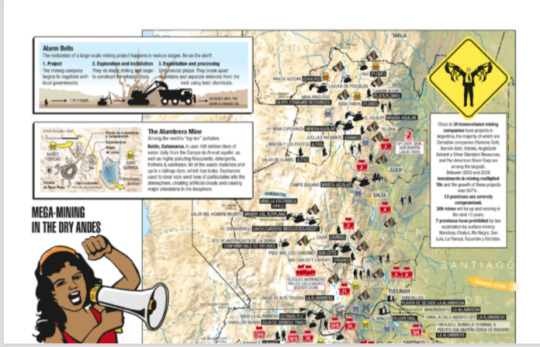

This Is Not an Atlas - A Global Collection of Counter-Cartographies
Indigenous Cartography in Acre Influencing Public Policy in Brazil
Comissão Pró-Índio do Acre – Renato Antonio Gavazzi cpiacre.org.br
“The ethnomaps made by indigenous communities are important planning tools for the protection, conservation and management of natural resources. They fill the void of information found on official maps. They also expose opinions, ideas and aesthetic preferences. Furthermore, they are a powerful tool that can be used for various political purposes. The maps are also powerful tools to fight for certain claims. The production of ethnomaps creates the possibility for indigenous peoples to build their knowledge and values on the Indian's relationship with "the other", thus contributing to the formulation of a future strategy by enabling non-indigenous people to understand the processes of occupation of geographical space. It also sheds light on social interdependen- cies within the economic, political and ecological contemporary world. In this case, the cartographic knowledge of and for indigenous peoples can be an important advocacy tool within the territory and the cultural and intellectual heritage it depicts.”

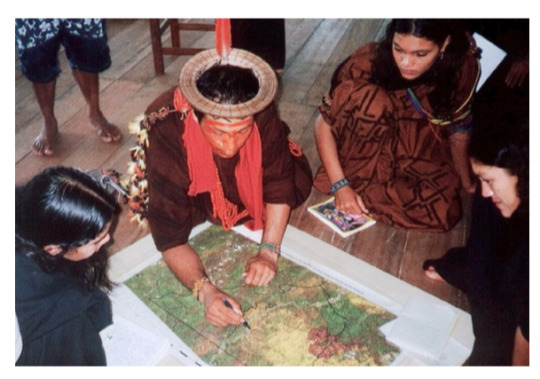

This Is Not an Atlas - A Global Collection of Counter-Cartographies
Towards unMaking Maps
A Guide to Experiments in Paracartography John Krygier, Denis Wood
youtube
Alternative mappings could range widely. They could borrow from or hybridize conventional cartography, maybe even influence it, but they are never obliged to conform to its ideas of what maps are supposed to be. The maps of artists, of activists engaged in indigenous and counter-mapping, diagrammatic social map- ping, and maps guiding or emerging from psychogeographic activities are but a few examples of the forms paracartography may take, but others may reach for the wild blue yonder.
The outcomes of the paracartographic practices and experiments we're exploring may expand the possibilities of mapping, may be funny or amusing, may undermine mainstream cartographic theory and practice, may be a waste of time, may help to understand the conventions and limitations of maps, may be stupid or puerile or may even leak out into the world, inspiring engagement with place and landscape. unMaking Maps: A Guide to Experiments in Paracartography is aimed at the growing number of people who want to explore the possibilities of mapping ... beyond accepted practice.
But why? Why would anyone want to do this?
The paracartographic answer would be, "Why not?", which is pretty unanswerable, but there are plenty of more reasonable answers, too. Perhaps the most important is that while most maps are unfathomably authoritative – they're right, they're accurate pictures of our world – they're simultaneously incredibly impoverished. That is, they may be right, but right about so unbelievably little. The world we actually live in is richly multidimensional, it has sunlight and starlight, it has shadows, it has birdsong and the roar of motorcycles, it has people and animals, and it's powerfully dynamic, changing not just day by day, but minute by minute and year by year. None of this makes it onto your Google map or onto the government topographic survey or onto the map hanging in the front of the classroom. None of this or any of the rest of it, which is the overwhelming most of it.
youtube
Situationist Maps

Guy Debord and Asger Jorn’s The Naked City (1957)
Situationist counter-maps are the product of drifts or dérives practiced by Guy Debord and his companions in post-World War II Paris. Often collective rather than solitary, of no preset route or duration, and driven by intuition rather than calculation, a dérive is a ritual exorcism of the instrumental, efficient, and ratiocinative life Le Corbusier and other urban planners envisioned for post-war cities of steel-framed, glass-enclosed housing blocks; pre-fabricated, mass-produced office and manufacturing complexes; and networks of ring roads, shuttle stops, and pedestrian “circulation paths” designed to bind them together.
0 notes
Text
Site-specific art
Class No. 1
The following notes are taken from: Miwon Kwon, One Place After Another, site-specific art and locational identity, MIT Press, 2002.
Brief history of Site Specificity:
Early formations:
“Site-specific works, as they first emerged in the wake of minimalism in the late 1960s and early 1970s gave itself up to its environmental context, being formally determined or directed by it.”
“Site specificity used to imply something grounded, bound to the laws of physics. Often playing with gravity, site-specific works used to be obstinate about “presence,” even if they were materially ephemeral, and adamant about immobility, even in the face of disappearance or destruction.”
“...site-specific art initially took the site as an actual location, a tangible reality, its identity composed of a unique combination of physical elements: length, depth, height, texture, and shape of walls and rooms; scale and proportion of plazas, buildings, or parks; exist- ing conditions of lighting, ventilation, traffic patterns; distinctive topographical features, and so forth.”
“Site-specific works, as they first emerged in the wake of minimalism in the late 1960s and early 1970s gave itself up to its environmental context, being formally determined or directed by it.”
In the 1960′s and 1970s site-specific practices were purposely anti-commercial and anti-idealist. They “incorporated the physical conditions of a particular location as integral to the production, presentation, and reception of art.”
By anti-idealist it meant it opposed the uncontaminated and pure idealist space of dominant modernisms where art was fully focused on its own material qualities, self-referential, autonomous and indifferent to external matters such as a site.
“...the space of art was no longer perceived as a blank slate, a tabula rasa, but a real place. The art object or event in this context was to be singularly and multiply experienced in the here and now through the bodily presence of each viewing subject, in a sensory immediacy of spatial extension and temporal duration...”
Site-specificity in the late 1960s was a new radicality in vanguardist sculptural practice, marking an early stage in the aesthetic experiments that were to follow through the1970s (land/earth art, process art, installation art, conceptual art, performance/body art, and various forms of institutional critique).
Site-specific work in its earliest formation, then, focused on establishing an inextricable, indivisible relationship between the work and its site, and demanded the physical presence of the viewer for the work’s completion. The (neo-avant-gardist) aesthetic aspiration to exceed the limitations of traditional media, like painting and sculpture, as well as their institutional setting; the epistemological challenge to relocate meaning from within the art object to the contingencies of its context; the radical restructuring of the subject from an old Cartesian model* to a phenomenological one* of lived bodily experience; and the self- conscious desire to resist the forces of the capitalist market economy, which circulates art works as transportable and exchangeable commodity goods—all these imperatives came together in art’s new attachment to the actuality of the site.”
*Cartesian model considers the physical world as the sum of static and unchanging closed systems.
*A phenomenological model is a scientific model that describes the empirical relationship of phenomena to each other.
The phenomenological method aims to describe, understand and interpret the meanings of experiences of human life. The purpose of the phenomenological approach is to illuminate the specific, to identify phenomena through how they are perceived by the actors in a situation.
Relationship with Minimalism, Institutional Critique and Conceptual Art
1952 on
Conceptual Art
-The main aspect of the work is the idea, not the creation of a tangible object.
-Sol LeWitt: “Conceptual art is good if the idea is good”
-A founding figure of Conceptual Art was Marcel Duchamp with his ready-mades, specifically with his urinal from the year 1917. Before that moment, art had been made with a focus on its aesthetic qualities, which included technical and intellectual merit.
-Duchamp considered that concepts needed to asssume protagonism and only then could the artist decide what was the best way to materialize that idea. Art needed no longer to be regarded on the basis of beauty, but on ideas.
-A change in how art was materialized occurred. Moved from paintings and sculptures to include to include the artists bodies. Performance art was born as a branch of conceptual art.
-Performance begun in the Happenings taking place in the Black Mountain College Art Center in the USA in the beginning of the 1950s. They were collective and collaborative, multidisciplinary events with various activities happening simultaneously, amongst them a talk (with silences) by Cage, music playing on a Victrola, dancing, actions with objects, objects in dialogue and hanged art works. They were first made by students and alumni, accompanied by famous artists like John Cage, his partner choreographer Merce Cunningham and Robert Rauschenberg.
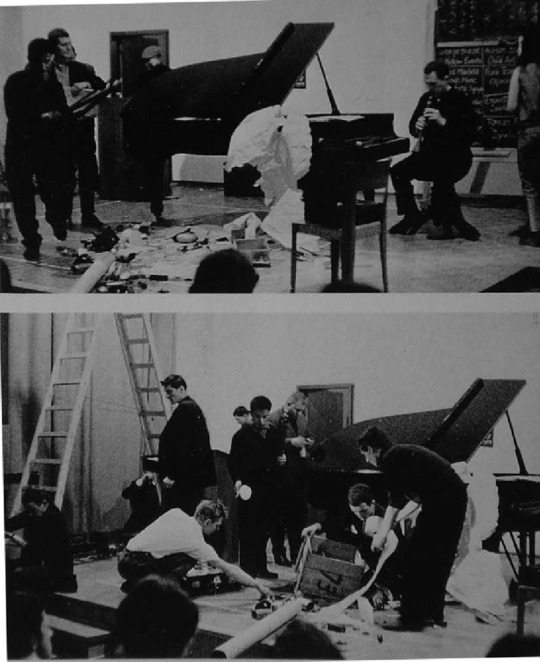
youtube
-However, on other accounts and texts, such as Artificial Hells by Claire Bishop, the author determines that performance dates back to Futurist’s Seratas in the 1910′s. From italian Serata translate to evening party or soirée. In these events a series of brief actions in a variety of media would unfold, amongst them: recitations of political statements and artistic manifestos, musical compositions, poetry and paintings.
-Futurist activities were performance-based held in theaters, but also in the streets. They would tour cities in Italy.
Further read: Bishop, Claire. Artificial Hells : Participatory Art and the Politics of Spectatorship. London :Verso, 2012.


Yves Klein, Anthropometric Paintings, Orchestra and Choir.
youtube
Allan Kaprow's How to Make a Happening was released as a LP album in 1966 by Mass Art Inc.
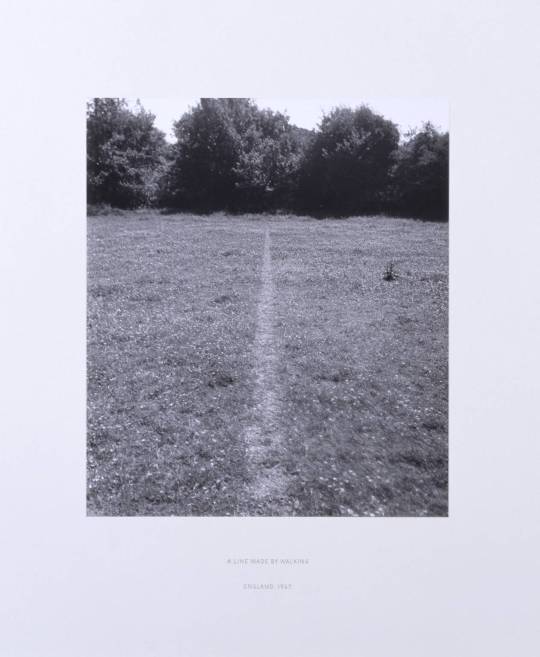
Richard Long, A Line Made By Walking, 1967. One of the first examples of Land Art, also a branch of Conceptual Art, in trend during the late 1960s and early 1970s.
Minimalism: 1960 - 1975
Notes from Gompertz, Will. What are you looking at? : The Surprising, Shocking, and Sometimes Strange Story of 150 Years of Modern Art. Ed. Plume, 2013.
Minimalist sculptures: Interior Strenght. Not bright and colourful, but calm and balanced and reserved. Self-contained. Well presented and clean. Neat and pristine. Cold and impenetrable.
Three dimensional cubes and rectangles with straight lines built with industrial materials that appear on the floors of exhibition spaces or on a wall, exercising their dominion over the space and over the audience.
they deal with the intelectual contemplation, but not with emotions. They preach self-containment and objectivity.
Although they apear still in the space, these sculptures are part of a performance and the audience is the performer. For minimalists artists, these scultures were only active when they have an audience.
Their main purpose is to influence the space and the people present in it.
The protagonists of Minimalist art are white men from the USA.
Very masculine, male-oriented works. Rigurose pieces, cold and mechanical with a hight attention to details. The works seem as if they were industrially produced with no marks or elements that could give subjectivity to the works.
They specifically subtracted the personal from the work to make it as impartial and objective as possible.
Highly rational work.
Many artists were exclusively interested in the materials and their aesthetic qualities. No interest in concepts or ideas or narratives behind the work.
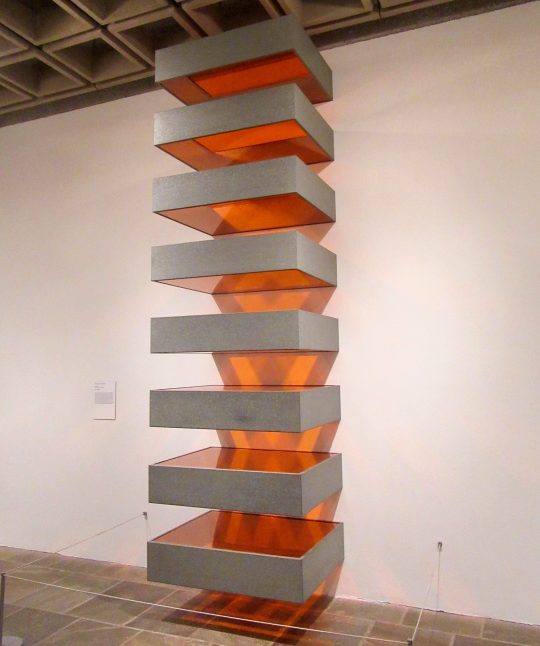
Donald Judd, Untitled, 1970
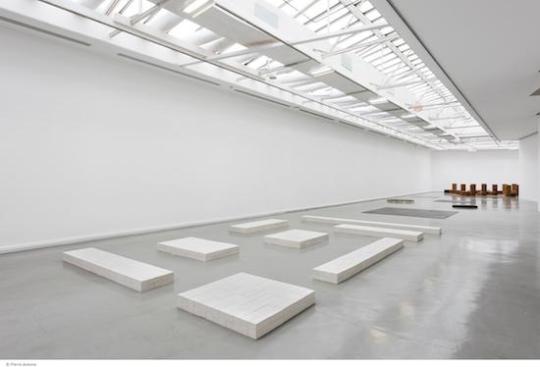
Exhibition: Carl Andre, Sculpture as Place, 1958–2010 au Musée d’Art moderne de la Ville de Paris
Institutional Critique
“By the late 1960s, it was clear that the art world is rapidly changing, due to an inevitable intersection with social and political shifts happening on a global scale. The phenomenon aimed to penetrate the very core of the art system and problematize different aspects of the same such as the modes of hierarchy, gender, race, as well as the art market, was Conceptual art. Although mostly focused on the notion of the artwork, language, and semiotics, it nurtured a particular group of artists and critical thinkers who were interested specifically in the institutional critique.“ (from: Widewalls).
“The critique of art institutions, such as museums, galleries, private collections, or publications, through artworks. A frequent target of avant-garde attacks since the late 19th-century, the institutions of art were condemned perhaps most fervently in the Futurist Manifesto (1909), which called upon artists to “set fire to the library shelves! Turn aside the canals to flood the museums!” The term “institutional critique,” however, has come to designate a strand of conceptual art beginning in the 1960s and associated with Michael Asher, Marcel Broodthaers, Daniel Buren, and Hans Haacke. These artists sought to expose the ideologies and power structures underlying the circulation, display, and discussion of art. In his seminal 1972 work the eagle from the Oligocene to the present, for example, Broodthaers brought together 266 found objects and displayed a wall text alongside each one that read “This is not a work of art,” thus questioning museums’ role in exhibiting and conferring status to artworks, as well as the role of the artist as the maker of original artworks.”
_____________________________________
“Informed by the contextual thinking of minimalism, various forms of institutional critique and conceptual art developed a different model of site specificity that implicitly challenged the “innocence” of space and the accompanying presumption of a universal viewing subject (albeit one in possession of a corporeal body) as espoused in the phenomenological model. Artists such as Michael Asher, Marcel Broodthaers, Daniel Buren, Hans Haacke, and Robert Smithson, as well as many women artists including Mierle Laderman Ukeles, have variously conceived the site not only in physical and spatial terms but as a cultural framework defined by the institutions of art. If minimalism returned to the viewing subject a physical body, institutional critique insisted on the social matrix of the class, race, gender, and sexuality of the viewing subject.9 Moreover, while minimalism challenged the idealist hermeticism of the autonomous art object by deflecting its meaning to the space of its presentation, institutional critique further complicated this displacement by highlighting the idealist hermeticism of the space of presentation itself. The modern gallery/museum space, for instance, with its stark white walls, artificial lighting (no windows), controlled climate, and pristine architectonics, was perceived not solely in terms of basic dimensions and proportion but as an institutional disguise, a normative exhibition convention serving an ideological function. The seemingly benign architectural features of a gallery/museum, in other words, were deemed to be coded mechanisms that actively disassociate the space of art from the outer world, furthering the institution’s idealist imperative of rendering itself and its values “objective,” “disinterested,” and “true.”
Michael Asher, Claire S. Copley Gallery, LA,1974

Michael Asher, Claire S. Copley Gallery, Los Angeles, California, USA, September 21–October 12, 1974, view through the gallery toward the office and storage areas. For this work, Asher removed the partition wall dividing the office and gallery space, revealing the day-to-day activities of the gallery to the public.
As early as 1970 Buren proclaimed, “Whether the place in which the work is shown imprints and marks this work, whatever it may be, or whether the work itself is directly—consciously or not—produced for the Museum, any work presented in that framework, if it does not explicitly examine the influence of the framework upon itself, falls into the illusion of self-sufficiency—or idealism.”10 More than just the mu- seum, the site comes to encompass a relay of several interrelated but different spaces and economies, including the studio, gallery, museum, art criticism, art his- tory, the art market, that together constitute a system of practices that is not sepa- rate from but open to social, economic, and political pressures. To be “specific” to such a site, in turn, is to decode and/or recode the institutional conventions so as to expose their hidden operations—to reveal the ways in which institutions mold art’s meaning to modulate its cultural and economic value; to undercut the fallacy of art’s and its institutions’ autonomy by making apparent their relationship to the broader socioeconomic and political processes of the day.
In nascent forms of institutional critique, in fact, the physical condition of the exhibition space remained the primary point of departure for this unveiling. For ex- ample, in works such as Hans Haacke’s Condensation Cube (1963–1965), Mel Bochner’s Measurement series (1969), Lawrence Weiner’s wall cutouts (1968), and Buren’s Within and Beyond the Frame (1973), the task of exposing those aspects which the institution would obscure was enacted literally in relation to the architecture of the exhibition space—highlighting the humidity level of a gallery by allow- ing moisture to “invade” the pristine minimalist art object (a mimetic configuration of the gallery space itself); insisting on the material fact of the gallery walls as “framing” devices by notating the walls’ dimensions directly on them; removing portions of a wall to reveal the base reality behind the “neutral” white cube; and exceeding the physical boundaries of the gallery by having the art work literally go out the window, ostensibly to “frame” the institutional frame. Attempts such as these to expose the cultural confinement within which artists function—“the apparatus the artist is threaded through”—and the impact of its forces upon the meaning and value of art became, as Smithson had predicted in 1972, “the great issue” for artists in the 1970s.”
Hans Hacke’s Condensation Cube

The Condensation Cube, 1963-1965. Some amount of water is maintained inside the cube. It then changes to a gaseous state, to mist, and then back to the liquid inside the cube. While over time the artist developed a critique of art as an institution and system, these early works focus on art in the sense of process and physical system. Interested in biology, ecology and cybernetics, in the mid-sixties Haacke was influenced by the ideas of Ludwig von Bertalanffy, especially those outlined in his General System Theory of 1968. For the Austrian biologist and philosopher, a living organism is an open system that continuously changes depending on its dialogue or interaction with the environment.
Mel Bochner’s Measurement series


Lawrence Weiner’s wall cutouts

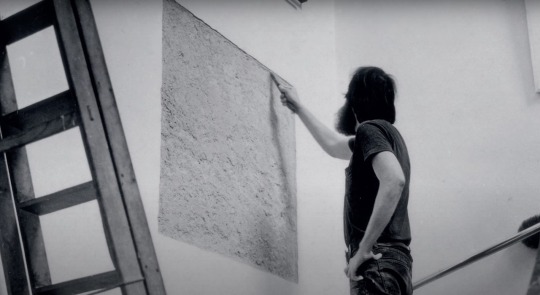
Buren’s Within and Beyond the Frame


“As this investigation extended into the 1980s, it relied less and less on the physical parameters of the gallery/museum or other exhibition venues to ar- ticulate its critique.”
“In the paradigmatic practice of Hans Haacke, for instance, the site shifted from the physical condition of the gallery (as in Condensation Cube) to the system of socioeconomic relations within which art and its institutional programming find
their possibilities of being.”
“In these ways, the site of art begins to diverge from the literal space of art, and the physical condition of a specific location recedes as the primary element in the conception of a site. Whether articulated in political and economic terms, as in Haacke’s case, in epistemological terms, as in Asher’s displacements, or in systemic terms of uneven (gendered) labor relations, as in Ukeles’s performances, it is rather the techniques and effects of the art institution as they circumscribe and de- limit the definition, production, presentation, and dissemination of art that become the sites of critical intervention.”
Mierle Laderman Ukeles’s 1973


“Yet another approach to a critique of the institutional frame is indicated in Mierle Laderman Ukeles’s 1973 series of “maintenance art” performances at the Wadsworth Atheneum in Hartford, Connecticut.15 In two of the performances, Ukeles, literally on her hands and knees, washed the entry plaza and steps of the museum for four hours, then scrubbed the floors inside the exhibition galleries for another four hours. In doing so, she forced the menial domestic tasks usually associated with women—cleaning, washing, dusting, and tidying—to the level of aesthetic contemplation, and revealed the extent to which the museum’s pristine self-presentation, its perfectly immaculate white spaces as emblematic of its “neutrality,” is structurally dependent on the hidden and devalued labor of daily maintenance and upkeep. By foregrounding this dependence, Ukeles posed the museum as a hierarchical system of labor relations and complicated the social and gendered division between the notions of the public and the private.”
“Concurrent with this move toward the dematerialization of the site is the simultaneous deaestheticization (that is, withdrawal of visual pleasure) and dematerialization of the art work. Going against the grain of institutional habits and desires, and continuing to resist the commodification of art in/for the marketplace, site-specific art adopts strategies that are either aggressively antivisual—informational, textual, expositional, didactic—or immaterial altogether— gestures, events, or performances bracketed by temporal boundaries. The “work” no longer seeks to be a noun/object but a verb/process, provoking the viewers’ critical (not just physical) acuity regarding the ideological conditions of their viewing. In this context, the guarantee of a specific relationship between an art work and its site is not based on a physical permanence of that relationship but rather on the recognition of its unfixed impermanence, to be experienced as an unrepeatable and fleeting situation.”
Group Material, Dazibaos, Union Square, New York, 1982
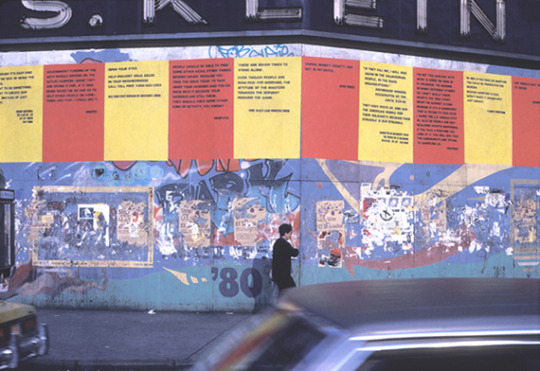
'Group Material was founded as a constructive response to the unsatisfactory ways in which art has been conceived, produced, distributed and taught in New York City, in American society.'
Daziboas means big word poster and is a means for debate in China which Tim had visited in 1978, 'a handwritten poster that opines, informs, or protests is mounted on a public wall'(8). They illegally mounted 12 posters in red and yellow in Union Square, New York with juxtaposing statements on current social and political issues gained from passersby on Union Square and six organisations (9).
1990s and 2000s
-In the late 1990s and early 2000s site-specifica artists wanted to distinguish themselves from these past practices because they were “deemed to have reached a point of aesthetic and political exhaustion.”
But if the critique of the cultural confinement of art (and artists) via its institu- tions was once the “great issue,” a dominant drive of site-oriented practices today is the pursuit of a more intense engagement with the outside world and everyday life—a critique of culture that is inclusive of nonart spaces, nonart institutions, and nonart issues (blurring the division between art and nonart, in fact). Concerned to integrate art more directly into the realm of the social,17 either in order to redress (in an activist sense) urgent social problems such as the ecological crisis, homelessness, AIDS, homophobia, racism, and sexism, or more generally in order to rel- ativize art as one among many forms of cultural work, current manifestations of site specificity tend to treat aesthetic and art historical concerns as secondary issues. Deeming the focus on the social nature of art’s production and reception to be too exclusive, even elitist, this expanded engagement with culture favors public sites outside the traditional confines of art both in physical and intellectual terms
...Contemporary site-oriented works occupy hotels, city streets, housing projects, prisons, schools, hospitals, churches, zoos, supermarkets, and they infiltrate media spaces such as radio, newspapers, television, and the Internet. In addition to this spatial expansion, site-oriented art is also informed by a broader range of disciplines (anthropology, sociology, literary criticism, psychology, natural and cultural histories, architecture and urbanism, computer science, political the- ory, philosophy) and is more sharply attuned to popular discourses (fashion, music, advertising, film, and television).
“...many artists, critics, historians, and curators, whose practices are engaged in problematizing received notions of site specificity, have offered alternative formulations, such as context-specific, debate-specific, audience-specific, community-specific, project- based.2 These terms, which tend to slide into one another at different times, collectively signal an attempt to forge more complex and fluid possibilities for the art-site relationship while simultaneously registering the extent to which the very concept of the site has become destabilized in the past three decades or more.”
the distinguishing characteristic of today’s site- oriented art is the way in which the art work’s relationship to the actuality of a loca- tion (as site) and the social conditions of the institutional frame (as site) are both subordinate to a discursively determined site that is delineated as a field of knowl- edge, intellectual exchange, or cultural debate. Furthermore, unlike in the previous models, this site is not defined as a precondition. Rather, it is generated by the work (often as “content”), and then verified by its convergence with an existing discur- sive formation.
ex:
Mark Dion’s 1991 project On Tropical Nature
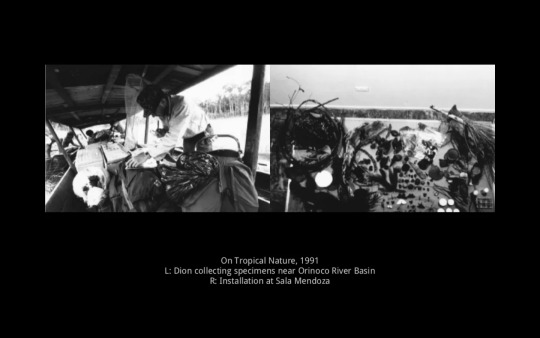

For example, in Mark Dion’s 1991 project On Tropical Nature, several differ- ent definitions of the site operated concurrently. First, the initial site of Dion’s inter- vention was an uninhabited spot in the rain forest near the base of the Orinoco River outside Caracas, Venezuela, where the artist camped for three weeks collecting specimens of various plants and insects as well as feathers, mushrooms, nests, and stones. These specimens, picked up at the end of each week in crates, were deliv- ered to the second site of the project, Sala Mendoza, one of two hosting art institu- tions in Caracas. In the gallery space of the Sala, the specimens, which were uncrated and displayed like works of art in themselves, were contextualized within what constituted a third site—the curatorial framework of the thematic group exhi- bition.19 The fourth site, however, although the least material, was the site to which Dion intended a lasting relationship. On Tropical Nature sought to become a part of the discourse concerning cultural representations of nature and the global environ- mental crisis.
Sometimes at the cost of a semantic slippage between content and site, other artists who are similarly engaged in site-oriented projects, operating with multiple definitions of the site, in the end find their “locational” anchor in the dis- cursive realm. For instance, while Tom Burr and John Lindell have each produced diverse projects in a variety of media for many different institutions, their consistent engagement with issues concerning the construction and dynamics of (homo)sexuality and desire has established such issues as the “site” of their work. And in many projects by artists such as Lothar Baumgarten, Renée Green, Jimmie Durham, and Fred Wilson, the legacies of colonialism, slavery, racism, and the ethnographic tradition as they impact on identity politics have emerged as an important “site” of artistic investigation. In this way different cultural debates, a theoretical concept, asocial issue, a political problem, an institutional framework (not necessarily an art institution), a neighborhood or seasonal event, a historical condition, even particular formations of desire are deemed to function as sites.
This is not to say that the parameters of a particular place or institution no longer matter, because site-oriented art today still cannot be thought or executed without the contingencies of locational and institutional circumstances. But the primary site addressed by current manifestations of site specificity is not necessarily bound to, or determined by, these contingencies in the long run. Consequently, al- though the site of action or intervention (physical) and the site of effects/reception (discursive) are conceived to be continuous, they are nonetheless pulled apart. Whereas, for example, the site of intervention and the site of effect for Serra’s Tilted Arc were thought of as coincident (Federal Plaza in downtown New York City), Dion’s site of intervention (the rain forest in Venezuela or Sala Mendoza) and his projected site of effect (discourse on nature) are distinct. The former clearly serves the latter as material source and inspiration, yet does not sustain an indexical relationship to it.
James Meyer has distinguished this trend in recent site-oriented practice in terms of a “functional site”: “[The functional site] is a process, an operation occur- ring between sites, a mapping of institutional and discursive filiations and the bod- ies that move between them (the artist’s above all). It is an informational site, a locus of overlap of text, photographs and video recordings, physical places and things. . . . It is a temporary thing; a movement; a chain of meanings devoid of a particular focus.” Which is to say, the site is now structured (inter)textually rather than spatially, and its model is not a map but an itinerary, a fragmentary sequence of events and actions through spaces, that is, a nomadic narrative whose path is articu- lated by the passage of the artist. Corresponding to the model of movement in electronic spaces of the Internet and cyberspace, which are likewise structured as transitive experiences, one thing after another, and not in synchronic simultaneity,24 this transformation of the site textualizes spaces and spatializes discourses.
A provisional conclusion might be that in advanced art practices of the past thirty years the operative definition of the site has been transformed from a physical location—grounded, fixed, actual—to a discursive vector—ungrounded, fluid, virtual. Of course, even if a particular formulation of site specificity dominates at one moment and recedes at another, the shifts are not always punctual or definitive. Thus, the three paradigms of site specificity I have schematized here—phenom- enological, social/institutional, and discursive—although presented somewhat chronologically, are not stages in a neat linear trajectory of historical development. Rather, they are competing definitions, overlapping with one another and operating simultaneously in various cultural practices today (or even within a single artist’s single project).
In addition, current forms of site-oriented art, which readily take up social issues (often in- spired by them), and which routinely engage the collaborative participation of audience groups for the conceptualization and production of the work, are seen as a means to strengthen art’s capacity to penetrate the sociopolitical organization of contemporary life with greater impact and meaning. In this sense the chance to conceive the site as something more than a place—as repressed ethnic history, a political cause, a disenfranchised social group—is an important conceptual leap in redefining the public role of art and artists.
Other notes on Site-specificity:
“Art historian James Meyers splits site-specificity into two parts, literal site and functional site. He explains that the literal site is the actual location of the work. It is important to note that because site specific work derives part of its meaning from the location, the art is created uniquely for the literal site. Meyers describes the functional site as the process that gives meaning to the literal site. The functional site is the temporary movement of information surrounding the work such as the debates about the work, as well as the ideas, drawings, photographs and videos of the work.[2] In direct response to Meyers, Miwon Kwon proposed her own way of defining site specific work and argues that there are three parts to site-specificity. The first site Kwon identifies in her article “One Place After Another: Notes on Site Specificity” is the physical site where the work is located. The second site Kwon identifies is the cultural site, which can be defined as the cultural, political, economic, or social meanings of the work. The third site Kwon argues is the discursive site, or the discourse of knowledge and ideas surrounding the work.[3] This last site that Kwon identifies stems from both the physical site and cultural site to create a deeper meaning that is specific and relevant to the particular time that the art is on show. However, because the discursive site is characterized by the debates and discussions about the work, this site may change and evolve over time as the work may become more or less relevant to the viewer.”
from: https://opening-contemporary-art.press.plymouth.edu/chapter/site-specificity/
Class No. 2
Looking into references highlighted in the text:
Richard Sierra Tilted Arc case.
youtube
more in-depth on this case in the chapter: Sitings of Public Art_ Integration Versus Intervention. (Kwon, pg. 71-84).
Article about Artangel Pyramid:
https://www.theguardian.com/uk-news/2013/dec/12/heygate-pyramid-london-estate-evicted-condemn-artwork

“Francis Alÿs in collaboration with Cuauhtémoc Medina and Rafael Ortega
When faith moves mountains (Cuando la fe mueve montañas)
“Sometimes making something leads to nothing, sometimes making nothing leads to something.” The seemingly paradoxical logic of this statement, uttered by the artist himself, informs the work of Francis Alÿs. His works often begin as simple actions performed by himself or commissioned volunteers, which are recorded in photographs, film, and other means of documentation such as postcards. Many of his projects are generated during the artist’s “walks,” or paseos, in which he traverses city streets. In these works, Alÿs proposes witty updates to Baudelaire’s figure of the 19th-century flaneur. His first walk was The Collector (1991–92), in which he strolled through the streets of Mexico City pulling a small metal “dog” by a leash, its magnetic wheels collecting the city’s detritus in its wake. In Paradox of Praxis (1997), the artist pushed a large block of ice down the streets for hours until it was reduced to a mere puddle. For The Leak (1995), he roamed the streets of Ghent with a punctured can of paint, leaving a sort of Jackson Pollock–like bread-crumb trail back to a gallery space, where he finally mounted the empty paint can to the wall.
Alÿs’s endeavors often exceed the dimensions of discrete objects. In 2002 a group of some five hundred volunteers armed with shovels formed a line at the end of a massive, 1,600-foot sand dune and began moving the sand about four inches from its original location. This epic project, When Faith Moves Mountains (Cuando la fe mueve montañas, 2002), was completed for the Third Ibero-American Biennial of Lima in a desolate landscape just outside the Peruvian capital. The work is neither a traditional sculpture nor an earthwork, and nothing was added or built in the landscape. That the participants managed to move the dune only a small distance mattered less than the potential for mythmaking in their collective act; what was “made” then was a powerful allegory, a metaphor for human will, and an occasion for a story to be told and potentially passed on endlessly in the oral tradition. For Alÿs, the transitory nature of such an action is the stuff of contemporary myth.”
Taken from: https://www.guggenheim.org/artwork/11412
youtube
Francis Alÿs, When Faith Moves Mountains 2002
Alÿs’s motto for When Faith Moves Mountains is “Maximum effort, minimum result.” For this epic project the artist invited five hundred volunteers to walk up a sand dune on the outskirts of Lima, Peru, shoveling in unison, thus displacing the dune by a few inches. Demonstrating a ridiculous disproportion between an effort and its effect, the work is a metaphor for Latin American society, in which minimal reforms are achieved through massive collective efforts. Participants in the project gave their time for free, reversing conservative economic principles of efficiency and production. Embracing rumor, urban myth, and oral history, Alÿs aims to make works that continue beyond the duration of the event itself, through stories disseminated by word of mouth.
Doris Salcedo




In an act of protest against a civil conflict that has raged for more than 50 years, the plaza was covered in a massive white shroud bearing the names of the war’s many victims.
The public statement of mourning by artist Doris Salcedo was temporarily installed as the country grapples with the rejection of a peace deal with leftist Farc rebels that would have ended the war.
Under the direction of Salcedo – best known for her 2007 installation of a deep crack in the floor of Tate Modern in London – 2,350 pieces of white cloth symbolizing death shrouds were stamped in ash with the name of a victim of the conflict, and then stitched together by volunteers, eventually covering the entire square.
Throughout the day, pairs of volunteers carried each shroud and placed it on the ground, as if laying a victim to rest.
“The ashes are symbolic. Because ash is either taken by the wind or it serves as a base for resurgence,” says María Belén Sáez de Ibarra, a curator for Salcedo, who is known for her installations that evoke mourning, loss, absence and remembrance.
“These names symbolize all those who have suffered from the war in Colombia,” said Sáez.
Critiques:
https://www.vice.com/es/article/nnp87g/doris-salcedo-plaza-bolivar-victimas-sumando-ausencias
Campamento por la Paz - 45 days taking the Central Plaza after a referendum for the peace agreement was voted negative.
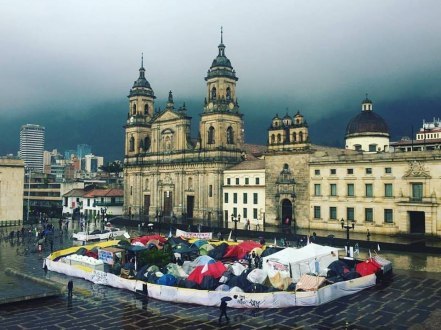
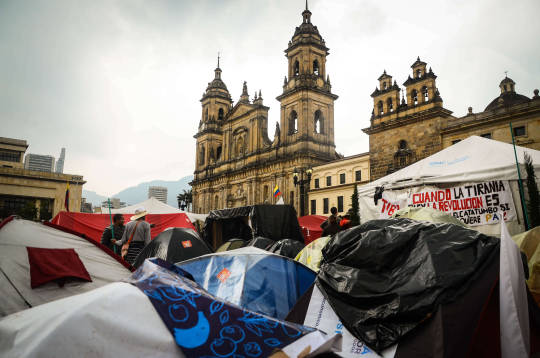

Also watch:
Works by
Abigail deVille




“Abigail DeVille is an American artist known for her large-scale sculptures and site-specific installations, which incorporate objects, materials, and narrative elements native to the site where the work manifests.
The depth and ingenuity of DeVille's work is a reflection of the artist's exhaustive historical research and disciplined approach to fostering an intertextual understanding of the role art plays in the everyday life of communities. DeVille’s works are meticulously crafted, elegant, abstract, undeniably dramatic, and nuanced in their many layers of meaning.
DeVille's work is keenly attuned to the optimism and endurance embedded within the ongoing struggles of African American communities. She perceives "lost voices" within her materials, and deploys the art of assemblage as a medium through which to reanimate these voices, and amplify their reach.
"America has numerous black holes in which it tries unsuccessfully to bury the bodies of its many democratic operatives,” DeVille says. “I use black holes as a loose metaphor for historical erasure. Black holes eviscerate matter, but the gravity of the matter remains to be discovered, interrogated, and recognized."
DeVille's work has been the subject of an Art21 documentary, and has been the subject of exhibitions at Hirshhorn Museum and Sculpture Garden, Washington DC; Contemporary Art Museum St. Louis; Institute of Contemporary Art, Los Angeles; The Studio Museum in Harlem; the Pinchuk Art Centre, Kiev; New Museum, NY; and Stedelijk Museum, Amsterdam, among others. She has been a Creative Capital grantee, was nominated for The Future Generation Art Prize in the 55th Biennale di Venezia, and was artist in residence at the American Academy in Rome in 2017-2018. Her work is in the permanent collections of Pinault; Memphis Brooks Museum of Art; Kadist Art Foundation; The Bronx Museum of the Arts; The Studio Museum Harlem; and Centre National des Arts Plastiques, Paris, among others. She teaches at the Maryland Institute College of Art in Baltimore, and is a visiting critic at the Yale School of Art and Columbia University New York MFA program.” taken from: https://kavigupta.com/artists/115-abigail-deville/
https://art21.org/watch/new-york-close-up/abigail-devilles-harlem-stories/
Shahzia Sikander

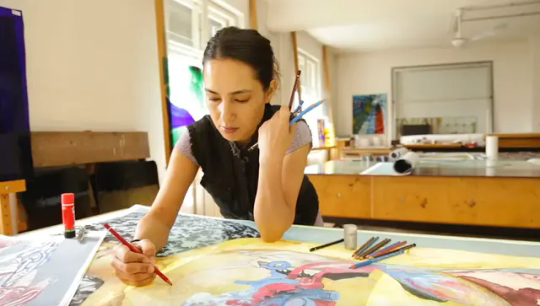
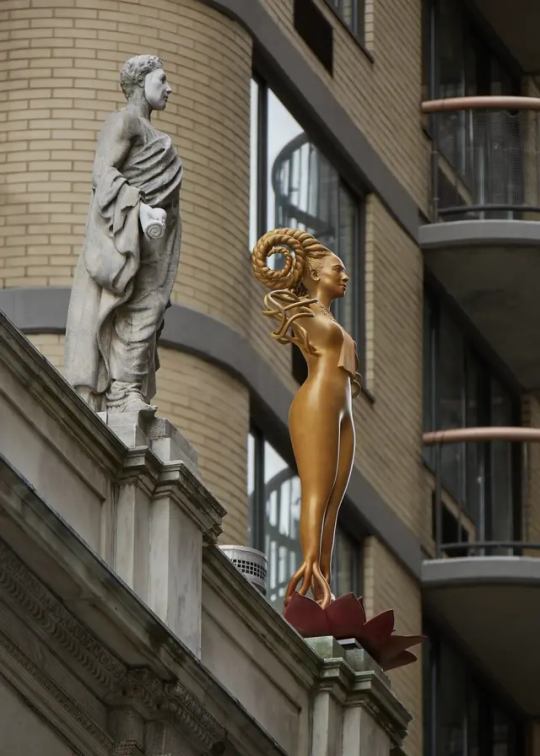
Shahzia Sikander was born in 1969 in Lahore, Pakistan. Educated as an undergraduate at the National College of Arts in Lahore, she received her MFA in 1995 from the Rhode Island School of Design.
Sikander specializes in Indian and Persian manuscript painting, a traditional style that is both highly stylized and disciplined. While becoming an expert in this technique-driven, often impersonal art form, she imbued it with a personal context and history, blending the Eastern focus on precision and methodology with a Western emphasis on creative, subjective expression. In doing so, Sikander transported manuscript painting into the realm of contemporary art.
Raised as a Muslim, Sikander is also interested in exploring both sides of the Hindu and Muslim “border,” often combining imagery from both—such as the Muslim veil and the Hindu multi-armed goddess—in a single painting. Sikander has written: “Such juxtaposing and mixing of Hindu and Muslim iconography is a parallel to the entanglement of histories of India and Pakistan.” Expanding the manuscript painting to the wall, Sikander also creates murals and installations, using tissue-paper-like materials that allow for a more free-flowing style. In what she labeled performances, Sikander experimented with wearing a veil in public, something she never did before moving to the United States.
Utilizing performance and various media and formats to investigate issues of border crossing, she seeks to subvert stereotypes of the East and, in particular, the Eastern Pakistani woman. Sikander has received many awards and honors for her work, including the honorary artist award from the Pakistan Ministry of Culture and National Council of the Arts. Sikander resides in New York.” From: www.art.21.org
Links:
Artist’s website
https://art21.org/artist/shahzia-sikander/
2 notes
·
View notes
Text
Institutional Critique
“By the late 1960s, it was clear that the art world is rapidly changing, due to an inevitable intersection with social and political shifts happening on a global scale. The phenomenon aimed to penetrate the very core of the art system and problematize different aspects of the same such as the modes of hierarchy, gender, race, as well as the art market, was Conceptual art. Although mostly focused on the notion of the artwork, language, and semiotics, it nurtured a particular group of artists and critical thinkers who were interested specifically in the institutional critique.“ (from: Widewalls).
“The critique of art institutions, such as museums, galleries, private collections, or publications, through artworks. A frequent target of avant-garde attacks since the late 19th-century, the institutions of art were condemned perhaps most fervently in the Futurist Manifesto (1909), which called upon artists to “set fire to the library shelves! Turn aside the canals to flood the museums!” The term “institutional critique,” however, has come to designate a strand of conceptual art beginning in the 1960s and associated with Michael Asher, Marcel Broodthaers, Daniel Buren, and Hans Haacke. These artists sought to expose the ideologies and power structures underlying the circulation, display, and discussion of art. In his seminal 1972 work the eagle from the Oligocene to the present, for example, Broodthaers brought together 266 found objects and displayed a wall text alongside each one that read “This is not a work of art,” thus questioning museums’ role in exhibiting and conferring status to artworks, as well as the role of the artist as the maker of original artworks.”
Artists involved in the movement:
“The pioneers of this important movement were active in both Europe and The States, among them Marcel Broodthaers, Hans Haacke, Michael Asher, and Daniel Buren, although all of them declined to be part of the movement. The second generation included Andrea Fraser, Fred Wilson, Louise Lawler, John Knight, Carey Young, Renée Green, Amalia Mesa-Bains, and Barbara Bloom, who were more comfortable with their work being labeled Institutional Critique.
The generation of artists to follow, including Liam Gillick, Rirkrit Tiravanija, Dominique Gonzalez-Foerster, and Pierre Huyghe, was influenced by Daniel Buren and Roland Barthes, as well as the participatory sculptures of Felix Gonzalez-Torres. Their practices were described as Relational Aesthetics by critic Nicolas Bourriaud, who perceived institutional exhibition spaces as sites of social interaction and the spontaneous production of artworks characterized by their temporality. In recent years, artists such as Tino Sehgal, Tameka Norris, Maurizio Cattelan, and others critically explore the role of the art museum as a public and private institution.” (from Widewalls).
Hans Haacke
“The work of German-born artist Hans Haacke was essential for the development of Institutional Critique in the United States. His 1965 manifesto proposing art as a nonstable, indeterminate field of human activity was important for the movement, as well as some of his early works such as Condensation Cube (1963). In 1967, the artist started teaching at Cooper Union in New York, and he became more interested in the art world and the critique of its social and political systems which culminated with his participation with a 1969 protest movement called the Art Workers' Coalition, which included Lucy Lippard, Robert Morris, and other artists. Under their text 13 Demands, they called for the equal representation of women and black artists in art institutions, museum reforms, and the end of the war in Vietnam.” (from: Widewalls)
Condensation Cube
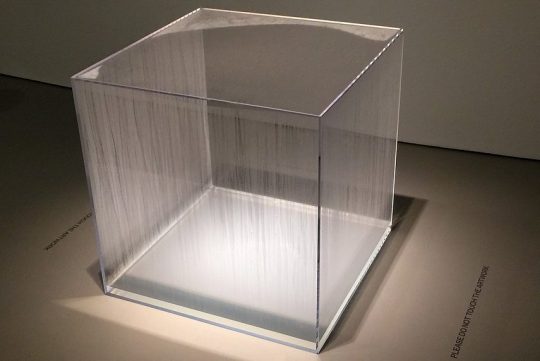
“In the early 1960s Haacke produced works that explored the interactions of physical and biological systems and their natural processes. Although related to the cube form adopted by minimalist artists, Condensation Cube departs from the notion of the static object animated only by the interaction of the viewer. It consists of a sealed Perspex box filled with a small amount of water. Condensation begins to form and to run down the sides of the box, changing according to the ambient light and temperature. The work’s appearance therefore depends upon the environment in which it is placed.” (from: Tate)
Group Material
An artist collective active in New York between 1989 and 1996 that was established by Julie Ault, Tim Rollins, and Mundy McLoughlin, among others, and later joined by various other artists, including Felix Gonzalez-Torres. Members generally expressed their disenchantment with the contemporary dominance of Neo-Expressionist painting and the increasing dependency of artists’ livelihood on the art market (and accordingly, the making of their artworks as easily-consumable commodities). Championing collaborative exhibitions instead of individual artist shows, community engagement over exclusivity, and alternative spaces in lieu of the customary white cube gallery, Group Material asked "everyone to question the entire culture we have taken for granted.” Group Material’s exhibitions adopted activist stances towards sensitive issues, exemplified most in their AIDS Timeline project, which sought to illustrate the complex political and cultural reception of the disease.
Democracy




Democracy was conceived by three members–Doug Ashford, Julie Ault, and Felix Gonzalez-Torres. Organized by New York artist collective Group Material, Democracy is a four-part exhibition and public forum responding to the “state of crisis” of democracy in the United States at the tail end of the Reagan era. The collective, comprised of Doug Ashford, Julie Ault, and Félix González-Torres, identified four significant arenas of this crisis: education, electoral politics, cultural participation, and the AIDS crisis. Around each of the four issues, they organized a roundtable discussion with guest speakers from interest groups, an exhibition at 77 Wooster Street, and a town meeting at 155 Mercer Street. With its emphasis on collaborative production and public participation, the project takes democracy not only as its subject, but also as a working process and exhibition model.
MASS
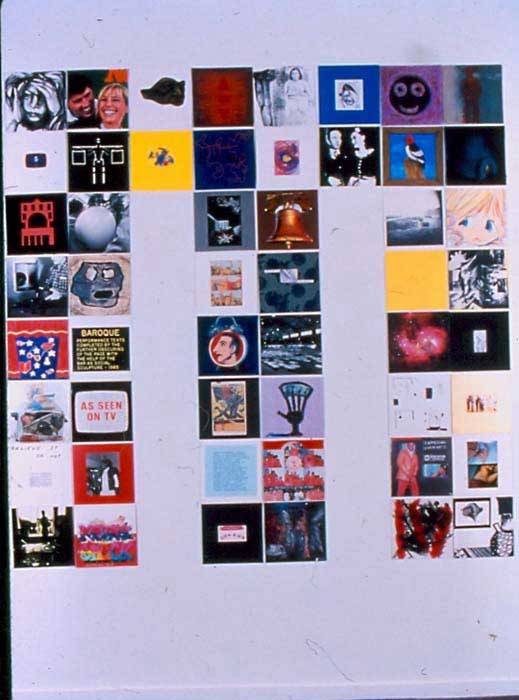
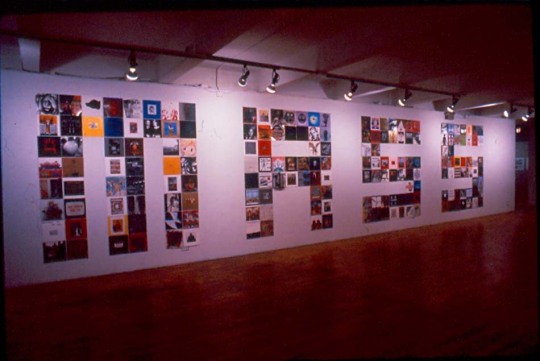


An exhibition of work by Group Material: MASS, a traveling exhibition that consists of the work of 250 artists, each measuring one square foot and arranged to spell the word "mass," which will premiere at Hallwalls.
"The issue of collaboration…is extremely complex in relation to Group Material for it is not merely a matter of four artists who collaborate with each other ("Group Material"), but four artists who have collaborated, over the past six years, with literally hundreds of other artists.…MASS was conceived by Group Material in response to some current buzzwords often used to describe the contemporary art scene: "hot," "expressionist," "heroic," "violent," "adventurous," and "raw." In opposition to these, Group Material proposed a different spelling of contemporary culture: "MASS." To this end, Group Material invited almost two hundred artists to contribute an image [which had to be 12 inches by 12 inches] of their own: a photograph, a record cover, or an advertisement—to offer literally a signifier which would become the signified "MASS," a twelve-by-forty-foot word which also functions as an image, a concept, a representation, and finally a collaboration.…This is a new opportunity to reconsider "MASS" in all of its contemporary significance: mass, as in the masses; mass, as in scientific denisity; mass, as in mass culture and mass media; mass, as in a religious mass, etc., etc.…" (excerpt from an exhibition brochure written by William Olander for the MASS show at The New Museum in New York City, 1986, and quoted on page 107 of Show and Tell: A Chronicle of Group Material edited by Julie Ault, Four Corners Press, London UK, 2010)

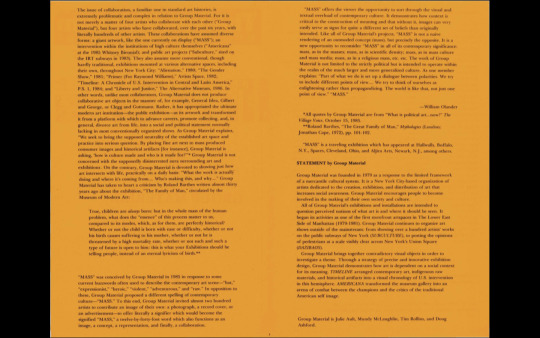
Andrea Fraser
Andrea Fraser is a performance and video artist who has been regarded primarily as a pioneer of “institutional critique,” since she structures her work around existing museum practices and protocols such as gallery talks and welcome speeches. Although they often begin rationally, her performances progressively unravel, frequently devolving into discussion of eccentric topics or performances of taboo behaviors.
Official welcome


Official Welcome (Hamburg Version) 2001–3 is a single channel colour video in which the American artist Andrea Fraser performs a speech to an audience at the Kunstverein in Hamburg. Wearing a black dress and standing on a white platform in front of a lectern and microphone, Fraser is filmed by two static digital cameras as she adopts a succession of different personae during the speech. Her performance is a satirical rendering of the rhetoric and rituals that traditionally constitute an ‘official welcome’ to an exhibition, with Fraser mimicking the language and gestures of archetypal figures associated with the art world, including patrons, museum directors, curators, critics and artists. Although Fraser does not explicitly inform the audience of the specific role she is inhabiting at any one time, the changes between different personae are signalled by distinct shifts in her tone, language and posture, often to comic effect. For instance, while she is fluid and grandiose during some sections, at other times she stutters as if struggling to articulate her thoughts. Around two-thirds of the way through the thirty-minute video, Fraser begins to undress. She moves to the side of the lectern in her black underwear and high-heeled shoes and tells the audience, ‘I’m not a person today. I’m an object in an artwork. It’s about emptiness’. She subsequently removes the last of her clothing and continues the speech naked. Towards the end of the performance, she puts her clothes back on, before beginning to cry. The video finishes with Fraser walking from the podium to applause from the audience. Official Welcome (Hamburg Version) can be shown as a video projection or on a monitor.
youtube
Museum Highlights: A Gallery Talk 1989

Museum Highlights: A Gallery Talk 1989 is a single channel colour video in which the American artist Andrea Fraser leads a tour of the Philadelphia Museum of Art in the guise of a fictional docent named Jane Castleton. Dressed in a smart grey suit, Castleton, who introduces herself as a ‘guest’, ‘a volunteer’ and ‘an artist’, speaks directly to the camera as she walks around the museum. Alongside conventional elements of a gallery tour – such as the history of the institution and its collection – Castleton offers her thoughts on the building’s toilets, cloakroom and shop. She also pronounces, in strange digressions and with great passion, on broader political and social ideas. The language Fraser employs in her performance appears to be a parody of the descriptions commonly provided by docents, with Castleton applying extensive and exaggerated praise to the items she encounters. There is often an odd disjuncture between the docent’s words and the objects she is describing, such as when she points to an exit sign and claims, ‘this picture is a brilliant example of a brilliant school’. Throughout the tour Castleton repeatedly returns to questions of personal taste, and the notions of grace, dignity and order that she feels artworks, museums and gallery visitors should embody.

youtube
Guerrilla Girls
Guerrilla Girls is an anonymous group of feminist, female artists devoted to fighting sexism and racism within the art world.[1] The group formed in New York City in 1985 with the mission of bringing gender and racial inequality into focus within the greater arts community.[2] The group employs culture jamming in the form of posters, books, billboards, and public appearances to expose discrimination and corruption. They also often use humor in their work to make their serious messages engaging.[3] They are known for their "guerilla" tactics, hence their name, such as hanging up posters or staging surprise exhibitions.[3] To remain anonymous, members don gorilla masks and use pseudonyms that refer to deceased female artists such as Frida Kahlo, Kathe Kollwitz, and Alice Neel. According to GG1, identities are concealed because issues matter more than individual identities, "Mainly, we wanted the focus to be on the issues, not on our personalities or our own work."[4]
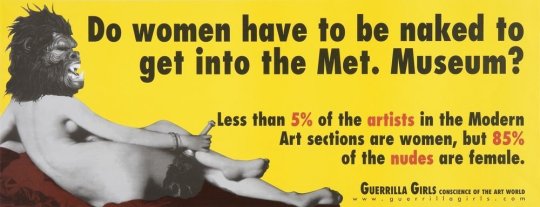



Dominique Gonzalez-Foerster
“Your work is often identified with the work of Relational Aesthetics artists such as Rikrit Tiravanija and Philippe Parreno who practise art as a social structure, as a real-time social activity, rather than as production of objects. Is the concept of an exhibition still relevant to your work?
I still think in terms of an exhibition, and I think an exhibition is an amazing medium. As much as I reject words and categories such as installation, performance and video art, I still think that the notion of an exhibition as an audience-based medium is open enough and can still take us beyond the field of visual art into the field of real experience. Though it has its splendour rooted in the context of the late nineteenth century, the term “exhibition” can still refer to a space where one is able to walk around and make one’s own time in relation to different situations and moments; but what is really interesting to me in relation to the exhibition as a medium is that, unlike cinema or theatre, it is not time-based but audience-based. This is where I think that the exhibition as a medium is still very attractive since it produces a viewer who has the qualities that Walter Benjamin, following Baudelaire, attributed to the urban flâneur; a viewer who has the possibility of being inside and outside at the same time; who is not fixed to his or her seat, or to a single viewing point for a predetermined duration.” (from Elephant).
0 notes
Text
Digital and Virtual
Niel Beloufa
Neïl Beloufa (b. 1985, Paris) is one the most powerful voices of the generation of artists born in the 1980s. His artistic research focuses on contemporary society and on how it is represented and mediated by digital interaction, often with the aim of exposing the control mechanisms. In his videos, feature films, sculptures, and technologically complex installations, Beloufa plays on the viewer’s sensory experience, inviting them to reappraise their own beliefs and stereotypes. He addresses present-day issues that range from power relationships to digital surveillance, to data collection and nationalistic ideologies, to identity and a post-colonial understanding of the world.
Neïl Beloufa’s work is strongly influenced by the world of the web, by videogames, by reality TV and political propaganda, using the vocabulary of the information age to lift the lid on the value system of a society permeated with digital technology, where everything, from food choices to human relationships is established on the basis of an algorithm.
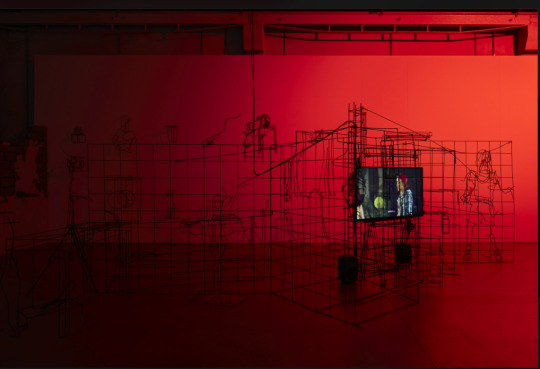

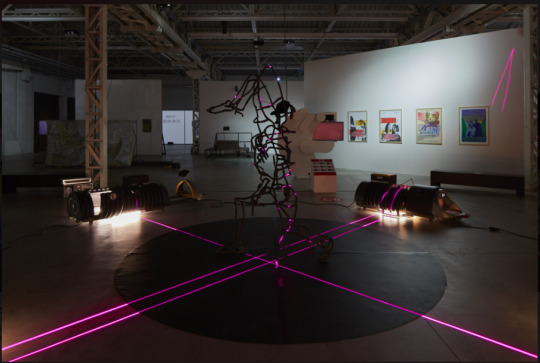


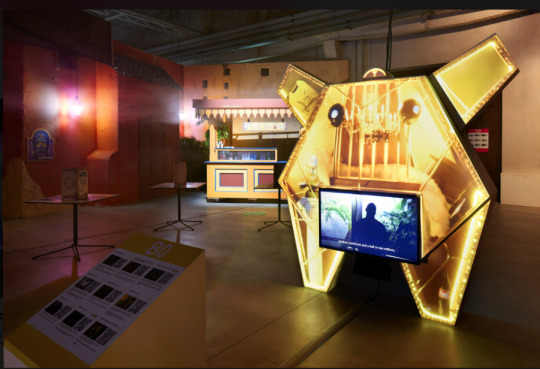
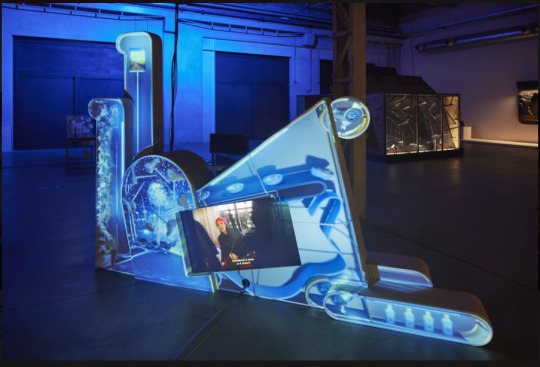
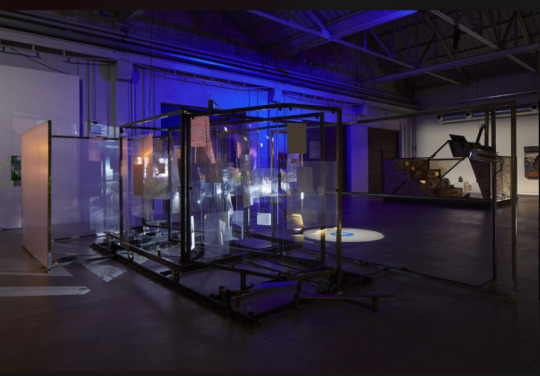
Ed Atkins
Ed Atkins (Oxford, 1982) is one of the most talked-about artists of his generation. He is among the vanguard of the “digital natives” who grew up with online technology and for whom it is second nature.
CUTTING EDGE DIGITAL TECHNOLOGIES
In his practice, Atkins makes extensive use of cutting edge digital technologies of production and display: High Definition computer generated imagery, surround soundtracking and extensive digital compositing. For him, the vast contemporary digital toolkit begins with his laptop: their integration is fundamental to the subverting of video art and its installation that goes on within his work.
Ed Atkins is an artist who makes videos, writes and draws, developing a complex and deeply figured discourse around definition, wherein the impossibilities for sufficient representations of the physical, specifically corporeal, world — from computer generated imagery to bathetic poetry — are hysterically rehearsed. Atkins’ works often centres on an unidentified figure, a kind of surrogate for the artist, who is animated by Atkins’ own performance. The figure is to be found in situations of everyday despair, anxiety, frustration and pitch comedy.
Atkins’ works are steeped in sentimentality. Sadness, beauty and transformation occur with the speed of paranoiac thought. Striking images, familiar musical phrases or poignant pleas are cut, ruined or denied at the last minute. Traces of profound affection and interrupted empathy linger. It is such sensation that makes Atkins’ works so striking; an artificial realism and romantic lushness that models feelings often inexpressible in real life. Atkins will present a slice of new and recent works for Bregenz, including Old Food, a body of works that expands with each iteration.
Here, Atkins transports us to a pseudo-historic world of peasantry, bucolic landscapes and eternal ruin. Characters weep continuously, their lives devoid of dramatic redemption; a looping piano motif haunts the space; crowds of people plummet while credits roll; and inedible, impossible sandwiches assemble and collapse in lurid advertisements. Produced exclusively using CGI (computer generated imagery), everything in Atkins’ exhibition is understood as fake — nostalgia, history, progress, authentic life, identity.

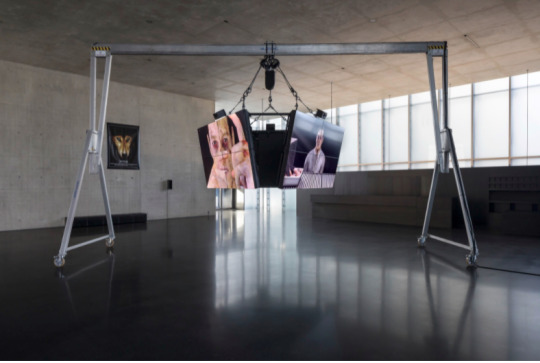

Sondra Perry
Sondra Perry constructs multifaceted narratives that explore the imagining, or imaging, of blackness throughout history. Often taking her own life as a point of departure, she makes works that revolve specifically around black American experiences and the ways in which technology and identities are entangled. Her use of digital tools and material, ranging from blue screen technology and 3D avatars to found footage from the internet, reflects on these modes of representation and the abstraction of black identity in art and media. Perry has said: "I'm interested in thinking about how blackness shifts,morphs, and embodies technology to combat oppression and surveillance throughout the diaspora. Blackness is agile."
Born in Perth Amboy, New Jersey, in 1986, Perry holds an MFA from Columbia University, a BFA from Alfred University, and is currently based in Houston, Texas as part of the artist-in-residence programme CORE at the Museum of Fine Arts, Houston. Recent solo exhibitions include flesh out at Squeaky Wheel Film and Media Art Center in Buffalo, Resident Evil at The Kitchen in New York. In 2015, the artist’s work appeared in the fourth iteration of the Greater New York exhibition at MoMA/PS1.
Cécile B. Evans
Cécile B. Evans is an American-Belgian artist living and working in London. Evans’ work examines the value of emotion and its rebellion as it comes into contact with ideological, physical, and technological structures. They have recently been on a residency with the National Ballet of Marseille in collaboration with the Kistefos Museum (NO) and exhibited a new performance commission at Centre Pompidou Paris (FR), both part of an ongoing adaptation of the Industrial Era ballet Giselle. Recent selected solo exhibitions include Tramway (UK), Tate Liverpool (UK), Castello di Rivoli (IT), 49 Nord 6 Est - Frac Lorraine (FR), Museum Abteiberg (DE), Chateau Shatto (US), Museo Madre (IT), mumok Vienna (AT), Galerie Emanuel Layr, Vienna (AT), Kunsthalle Aarhus (DK), M Museum Leuven (BE), De Hallen Haarlem (NL), and Serpentine Galleries (UK). Evans’ work has been included amongst others at Whitechapel Gallery (UK), Haus der Kunst (DE), Mito Art Tower (JP), Renaissance Society Chicago (US), the 7th International Moscow Biennale (RU), the 4th Ural Industrial Biennial (RU), Galerie Kamel Mennour (FR), Louisiana Museum of Modern Art, Copenhagen (DK), the 9th Berlin Biennale (DE), the 20th Sydney Biennale (AUS), Fundació Joan Miró, Barcelona (ES), and Musée d’Art Moderne de Paris (FR). Evans’ films have been screened in festivals such as the New York Film Festival and Rotterdam International. Public collections include The Museum of Modern Art, New York (US), The Rubell Family Collection, Miami (US), Whitney Museum of American Art (US), De Haallen (NL), Castello di Rivoli, Turin (IT), Louisiana Museum of Modern Art, Copenhagen (DK), and FRAC Auvergne (FR)
Hito Steyerl
Artist, theoretician, and educator Hito Steyerl has wondered, “Are people hidden by too many images? . . . Do they become images?” To make sense of global, digital, networked life, Steyerl integrates communications media into cinematic installations, blending documentary film techniques, speculative fiction, and first-person narrative. “There is a very valid reason for artworks about ‘real’ events to be more interesting than generic news reports,” she has said. For her, that reason is an artist’s ability to closely observe the world as it is, and at the same time assert how “things could be different.”1
Documentary and speculative film are integrated in her video November (2004). Steyerl examines the 1998 disappearance and death of her friend, sociologist Andrea Wolf, who was arrested during a battle for Kurdish independence from Turkey. Intercutting a martial arts film the pair made as teens with news footage, Steyerl shows Wolf as the fighter she portrayed, and who in death exists only as memory and image.
Steyerl studied filmmaking in Germany and Japan, then earned a philosophy PhD in Vienna. The cinematic and the philosophical are deeply intertwined in her influential essay “In Defense of the Poor Image.”2 Articulating the communicative power of “images based on cell phone cameras, home computers, and unconventional forms of distribution” characterized by “collective editing, file sharing, or grassroots distribution circuits,” Steyerl argues for the democratic, subversive potential of this anonymous, low-quality, high-circulation information.
Steyerl’s interest in visibility and disappearance is taken to an absurd extreme in How Not to Be Seen: A Fucking Didactic Educational .MOV File (2013). Satirizing instructional videos through a blend of analog and digital media, the artist demonstrates practical and comical ways to maintain privacy in an age of high visibility.
In more recent works Steyerl examines the flow of money and power through the global economy. Liquidity, Inc. (2014) looks back at the 2008 financial crisis, telling the story of a financial analyst through the metaphor of water. Projected on a curved wooden viewing platform, the work is intended to create the feeling of riding a battered raft or experiencing financial instability.
In her ongoing practice, Steyerl mobilizes contemporary media to do “what art...is best at: look, listen, and interpret with precision, imagine without compromise or fear.”3
0 notes
Text
Public Interventions
Guerrilla Girls
The Guerrilla Girls are an anonymous group of feminist, female artists devoted to fighting sexism and racism within the art world.
The group formed in New York City in 1985 with the mission of bringing gender and racial inequality into focus within the greater arts community.
The group employs culture jamming in the form of posters, books, billboards, and public appearances to expose discrimination and corruption.
To remain anonymous, members don gorilla masks and use pseudonyms that refer to deceased female artists.
According to GG1, identities are concealed because issues matter more than individual identities, "Mainly, we wanted the focus to be on the issues, not on our personalities or our own work."


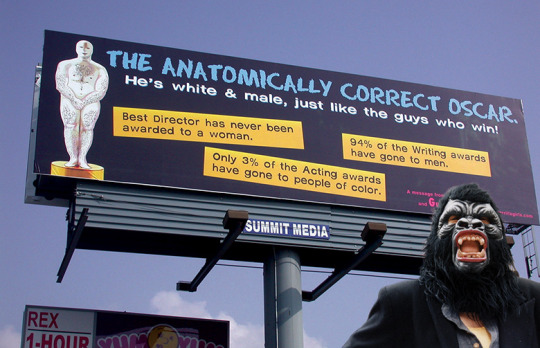
youtube
Christo and Jeanne-Claude
Along with his late wife Jeanne-Claude, Christo has spent the last 57 years repeatedly redefining the parameters of installation and land art, creating a body of work that defies categorization and recognizes no limit to possibility. Using cheap, commonplace materials—fabric, tape, plastic—and with a practice supported via the sale of drawings and architectural models, the artists realized ideas that sound entirely fantastical until carried through.
Christo began to "appropriate" everyday objects, to deprive them of their function, and, by putting them under wraps, to preserve them permanently for posterity. Even if the first works had been created as random artistic experiments, Christo soon realized that this was the beginning of an artistic career in which the transformation of everyday objects and places would become the central theme. His approach was direct, immediate, radical.
While he covered the first "wrapped" objects—mostly empty paint cans and glass bottles—with a layer of glue, sand and gloss paint to create an encrusted, haptic surface, he soon began to let the material "breathe," so that the work was subject to constant change. It was only later that Christo started to experiment with the contents of his wrappings as well, using transparent polyethylene so that one can at least guess at the content of his tied-up objects. Christo's passion was primarily directed towards the objects as physical things and not as bearers of meaning. He was concerned above all with the texture, the form, and not so much with the content. Wherever he could, he rummaged around to find new objects. He confiscated his landlord's chair, Jeanne-Claude's shoes, their son's stroller. In the following years he was to wrap objects with the obsession of a fetishist: magazines, bicycles, and telephones.
These early objects all arose in direct involvement with the real, physical object, spontaneously, without the need for any particular planning or preparation. That was soon to change. Christo was no longer satisfied with small-scale objects. His works became bigger, more complex and extended further and further into the surrounding space. He took a decisive step towards the later large-scale projects conceptually in the early 1960s, but especially after he and Jeanne-Claude moved to New York in 1964. The production of his works became so complex that he began to prepare them with sketches and drawings, which enabled him to visualize his ideas in advance. Each drawing was an independent work of art in its own right, but at the same time the drawings did not become pure ends in themselves. They fulfilled a specific function within the work process. In this sense, it is doubtless wrong to speak of "sketches" in relation to Christo's works. Rather, these were technical drawings: on a two-dimensional path, so to speak, the desired end-product took on its "definitive" form, a template from which the work could then be realized as a craft object.
Excerpt from the essay "Christo's Drawings from Vision to Document" by Matthias Koddenberg, published in Christo and Jeanne-Claude: Projects 1963–2020, PalaisPopulaire, Berlin, 2020. Text edited in 2021.

En 1983 la pareja realiza “Surrounded Islands”. Once islas en la Bahía de Miami son cubiertas con 603.850 m² de tela de polipropileno rosado. La obra fue finalizada el 4 de mayo de 1983 con la colaboración de 430 ayudantes y pudo ser contemplada durante dos semanas.
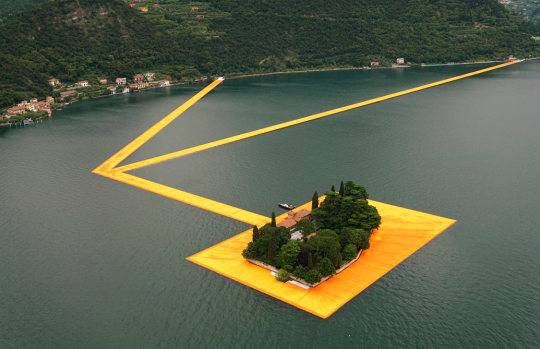
En 2016 el artista inaugura “Floating Piers”, un camino de nailon amarillo de 16 metros de ancho por tres de largo que conecta dos islas italianas ubicadas en el Lago Iseo. El material utilizado es sensible a la temperatura, cambiando de color. El proyecto procede del año 1970 cuando fue ideado por el artista para el del Río de la Plata, pero nunca pudo ser llevado a cabo hasta el año 2016.

En 1970 realizan el proyecto "Valley Curtain". Una tela de 400 m de largo sería colocada a través del Rifle Gap, un valle en las Montañas Rocosas, cerca de Rifle, Colorado. Pra el proyecto se necesitó 14.000 m² de tela para ser colgado en un cable de acero, el cual estaba sujeto a barras metálicas fijadas a cada ladera. También fueron necesarias 200 toneladas de hormigón, que debieron ser transportadas a mano en cubos cuesta arriba.
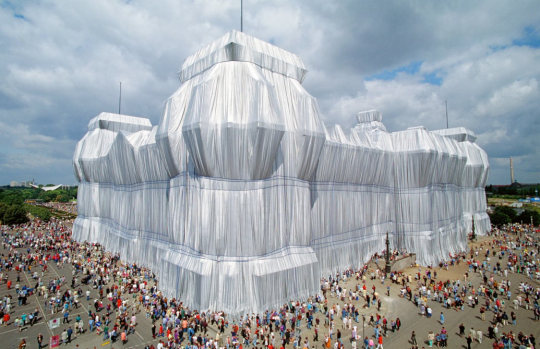
En 1995 realizan una de las obras más emblemáticas, intervienen en el edificio del Reichstag en Alemania. Tras largas negociaciones Chisto y Jeanne-Claude consiguen el apoyo del parlamento para que el 25 de febrero de 1995, el Bundestag autorice la ejecución del proyecto. El proyecto necesitó más de 10 ha de tela de polipropileno resistente al fuego, aluminio, y 15 km de cuerda. El edificio tardo en envolverse una semana y fue contemplado por 5 millones de visitantes.
El dúo dijo que el uso de tela en su instalación reflejaba la "impermanencia", que, después de la unificación de Alemania Oriental y Occidental, resonó políticamente.
Pussy Riot
Nadezhda Tolokonnikova, Maria Alyokhina, and Yekaterina Samutsevich—better known as Pussy Riot—were arrested in 2012 after disrupting a church service in Moscow. The impromptu performance of the band’s song "Punk Prayer," in which they shout “Mother Mary, please drive Putin away,” protests the Russian Orthodox Church’s support for Russia’s president, whom the trio see as an imperialist autocrat. The feminist band was sentenced to two years in prison on the charge of “hooliganism” because they offended churchgoers and “had intended to insult the Russian Orthodox Church and undermine public order.” The trial attracted broad attention to the state of freedom of speech in Russia and Amnesty International protested the court’s decision. Sting, Madonna, and Yoko Ono all spoke out against the trio’s treatment (Samutsevich was freed after five months of detention while the other two members remained imprisoned, although they were eventually released early due to a newly enacted Russian law).
youtube
youtube
Felix Gonzalez Torres
For Gonzalez-Torres, art was an effective means of addressing social concerns—even more so when it could be multiplied. Inhabiting the familiar forms of Minimalism and post-Minimalism with his stacks and floor pieces, the artist embedded subtle but insistent references to current issues, from political violence to gay rights. In billboard projects like “Untitled”, the artist played with the powerful juxtapositions that could be generated between private and public spaces. By choosing this photograph of his bed, the artist exposed this most intimate of spaces, emphasized by the rumpled sheets and the recent impressions of two heads in the pillows. In the early 1990s, with controversies surrounding homosexuality and the AIDS crisis simultaneously wreaking havoc across the gay community, the bed also represented a site of conflict, symbolizing both love and death. That Gonzalez-Torres’s partner, Ross, died of AIDS in 1991 brings an intensely personal note to this work, but does not diminish it of its universal associations with comfort, intimacy, loneliness, or loss.
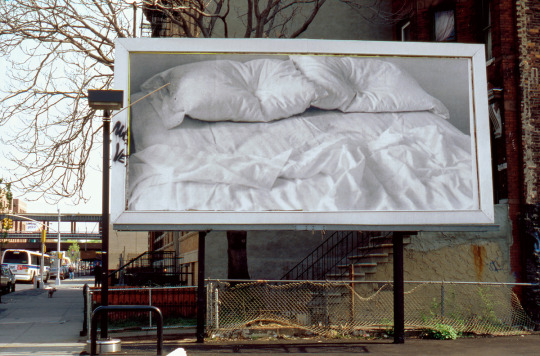
Olafur Elliason
Sometimes a simple demonstration works best. Icelandic artist Olafur Eliasson teamed up with a geologist named Minick Rosing in 2015 to import from southern Greenland 12 icebergs, which he arranged like the 12 digits on a clock. During the Paris Climate Conference he installed them in Paris’s Place du Pantheon, so onlookers could watch them melt, in his site-specific work Ice Watch. The 12 blocks took 12 days to disintegrate—the length of the conference. The ten-ton pieces of ice traveled via shipping container to Denmark and then ten hours by truck to reach the City of Light, according to a report in The New Yorker at the time.

Doris Salcedo
Salcedo's idea was to create a "topography of war"--not tied to a specific historical event, but to war in general. Seeing these 1,550 wooden chairs piled high between two buildings in central Istanbul, I'm reminded of mass graves. Of anonymous victims. I think of both chaos and absence, two effects of wartime violence.
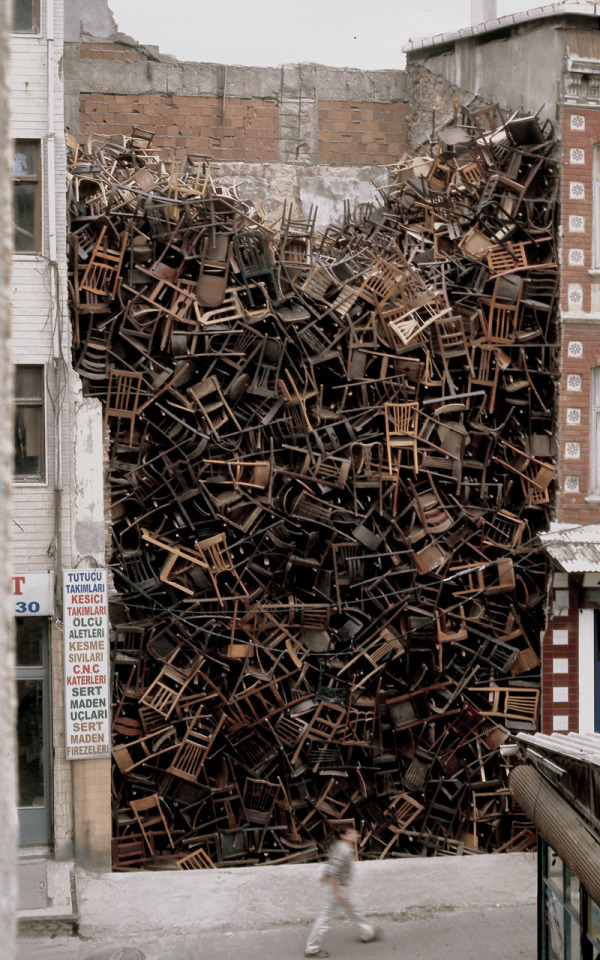
Buró Intervenciones Públicas de Guatemala
El Buró de Intervenciones Públicas (BIP) es un proyecto de Stefan Benchoam y Christian Ochaita que surge a raíz de la falta de espacios públicos y estructuras de ocio y socialización en la Ciudad de Guatemala. Las propuestas que desarrollan incorporan distintos aspectos de arquitectura, arte, diseño y urbanismo para intervenir las expectativas cotidianas del ciudadano, alterando así la manera en que éste se relaciona con los espacios abiertos. Sus intervenciones reivindican el uso del espacio colectivo a través de elementos lúdicos y acciones inusuales y se basan en la colaboración con otros artistas, colectivos y personas.
Los proyectos que desarrollan pueden ser vistos como un gesto situacionista que intenta crear debate y reflexión sobre la ciudad. Por otro lado, pretenden generar soluciones reales a la ausencia de iniciativas de gobiernos municipales y centrales.



Chris Burden
Dissappearing 22-24 december, 1971
You´ll never see my face in Kansas City 1971
Deadman 1972
Honest Labor 1979
Superstudio
Superstudio was an architectural firm, founded in 1966 in Florence, Italy by Adolfo Natalini and Cristiano Toraldo di Francia, later joined by Gian Piero Frassinelli, Alessandro and Roberto Magris, Alessandro Poli.[1][2]
Superstudio was a major part of the Radical architecture and design movement of the late 1960s. The founders had gone to school at the University of Florence with Archizoom Associati founder Andrea Branzi and first showed their work in the Superarchitettura show in 1966.[3] This exhibition became the manifesto of the Radical Design movement.[1]
In 1967, Natalini established three categories of future research: “architecture of the monument”, “architecture of the image”, and “technomorphic architecture”.
In 1969, Superstudio presented one of their most famous conceptual architecture works – Continuous Monument: An Architectural Model for Total Urbanization. Their anti-architectural proposals used grid systems as a way to mediate space.[4] Continuous Monument represented a critique of the urban planning at that time.[1]
Superstudio aimed for social change through architecture. In the early 1970s, they created a series of films in order to raise awareness of the harmful impact of construction on natural environment.[1]
Adolfo Natalini wrote in 1971 “...if design is merely an inducement to consume, then we must reject design; if architecture is merely the codifying of bourgeois model of ownership and society, then we must reject architecture; if architecture and town planning is merely the formalization of present unjust social divisions, then we must reject town planning and its cities...until all design activities are aimed towards meeting primary needs. Until then, design must disappear. We can live without architecture..." Through their models, Superstudio proposed an alternative strategy of life without objects, a view of architectural practice as essentially theoretical, with a primary focus on cultural criticism.[1]
youtube
Al Madhafah - Living room
Located between the domestic and the public sphere, Al-Madhafah, in Arabic, is the living room dedicated to hospitality. It has the potential to subvert the role of guest and host and give a different socio-political meaning to the act of hospitality. It seeks to mobilize the condition of permanent temporariness as an architectural and political concept able to challenge the binaries of inclusion and exclusion, public and private, guest and host. It activates the rights of temporary people to host and not to be eternally a guest, the right to claim life in the new destination but without feeling obliged to revoke the desire to belong to the life back home Al Madhafah the living room is a project created by Sandi Hilal, based on her experience conducting fieldwork for the Public Art Agency Sweden with refugees in the city of Boden, Sweden, in November 2016. Boden is a former military town located in northern Sweden, 80 kilometers from the arctic circle. From being a military town, it has now become an important reception center for asylum seekers. The project is inspired by a story about a Syrian refugee couple Yasmeen and Ibrahim, who had moved to Boden from Syria two years previously, and drew on the tradition of hospitality, never accepting that they should give up their right to be hosts in their new home. They continued what was an important part of their life in Syria, opening up their living room to host both Swedes and others. The living room, when opening itself to host the stranger guest, functions as a self-representational space, that has the potential to subvert the role of guest and host and give a different socio-political meaning to the act of hospitality. The possibility of hosting had become, for them, a way to regain access to their lost personal and collective history, combining their lost life in Syria with their new life in Sweden. By exercising their right of hosting and activating their living room, Yasmeen and Ibrahim no longer felt themselves to be statistics, passive guests in Sweden but to be owners of their own story. Over the past two years, the Public Art Agency Sweden, Bodenbo, Havremagasinet and the Defense Museum Boden have collaborated with the architect Sandi Hilal and Yasmeen Mahmoud and Ibrahim Muhammad Haj Abdullah in the Al Madhafah / Living Room art project. With common forces, a local living room has been created, a place where conversation, cooking, and learning become art and the exchange of knowledge. Al Madhafah / The Living Room in the Yellow House at Prästholmen is a work of art, but also a living room open to those who want to host new encounters.
youtube
Stuart Brisley
BENEATH DIGNITY, BREGENZ (1977) 1981



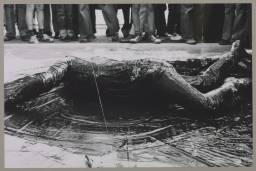
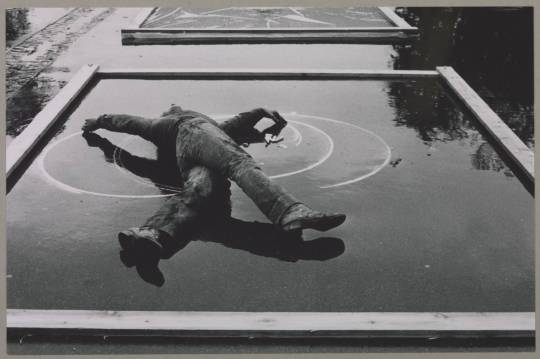


'Beneath Dignity, Bregenz’ (1977) was performed in conjunction with an exhibition of British art in Austria (Englishe Kunst der Gegenwart in September 1971); Brisley was invited by Norbert Lynton to take part. Brisley had worked during this year on an Artist Placement Group project in Peterlee in a community of miners and the title is indicative of his sympathy with the miners, and the lowness (and implied loneliness) of their working conditions. The work that preceded it had a similar preoccupation with digging and working in appalling conditions.
In Bregenz he was presented with a strikingly different environment: a picturesque town by the side of a lake (Lake Constance) with a small mountain behind. This work is a response to this setting, the movement from mountain to flat ground and the lake (from the vertical to the horizontal). He chose to work on a quayside, using five roughly constructed frames which marked the limits of his physical reach. The materials which he employed were water, chalk, powder (flour) and paint (black and white). He made five separate statements using each of the materials, working in all for four days. In order to reduce the drama of the work (a character that Brisley abhors) the fifth frame was a mixture of black and white. On the last day the audience was large and Brisley avoided a climax to the work by jumping into the lake and swimming, replicating his drawing action in water, another medium. He describes his action here as similar to the other works in the Tate's collection, showing a preoccupation with formal, sculptural problems. It is possible however that Brisley may, in hindsight, be emphasising this aspect at the expense of his political concerns.
The photographer for this work was his friend Janet Anderson; he preferred her photographs to those of a trained photographer, who he felt would have a particular and exclusive aesthetic. The viewpoint for these photographs was fixed and decided upon by discussion between Brisley and the photographer.
0 notes
Text
Art and the Environment
“Part of addressing a complex politics of ecology and its aesthetic reach means critically rethinking current or provincialist terms of debate by foregrounding overlooked actors, actants, voices and constituencies. In examining social, political and environmental conditions of crisis, envisaging a post-humanist method of inquiry towards the long-term development of sustainable solutions does call for the rejection of binaries or polarisations. Yet it must also be pursued on a cross-disciplinary basis that aims to animate serious proposals that reject and rethink the ‘restricted economy’.”
Carolina Caycedo
BE DAMMED (ongoing Project)
In Indigenous cosmogonies of the Americas, all bodies of waters are connected. Rivers are the veins of the planet, their waters associate communities and ecosystems. Be Dammed investigates the effects that large dams have on natural and social landscapes in several American bio-regions. More than 250 large hydroelectric dams are projected or under construction by transnational corporations in Latin America, signifying the transition of public bodies of water into privatized resources. At the same time, the U.S. is the leading country in dam removal, allowing for the restoration of river ecosystems. In Be Dammed, aerial and satellite imagery, geo-choreographies and audio-visual essays intersect social bodies with bodies of water, exploring public space in rural contexts, and conjuring water as a common good.
Conjuro de rios - rio cauca e hidroituango dam
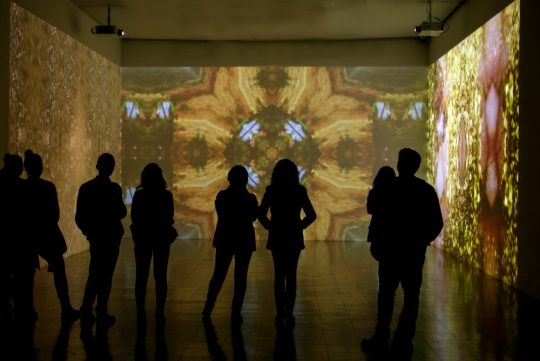
Itaipu river

The Cosmotarrayas
a series of hanging sculptures assembled with handmade fishing nets and other objects, collected during my field research in different riverine communities affected by the privatization of waters in Colombia and Brazil.


YUMA, or the land of friends, El Quimbo Dam

Lygia Clark
Baba Antropofágica
In collective works like «Túnel» or «Objetos relacionais,» Lygia Clark initiates psychic processes of exchange which transform the dichotomy of subject and object. In doing so, she follows the transgressive logic of «devouring» and «vomiting». The reception of «Baba antropofágica» («Cannibalistic Saliva») also relies on the documentary film «O mundo de Lygia Clark,» filmed by Eduardo Clark in 1973. But escaping this phantasmal staging of the body seems almost impossible: kneeling over a guinea-pig-like subject lying on the floor, a figure pulls from its mouth—like spiders do from their bodies—a spittle-drenched thread and spins a cocoon around the reclining figure. The precarious division of subject and object is eliminated by this thread-like weaving, with the gestural webbing of the passive subject completing the inversion of the internal and external. In the retrospective, these interactive aspects might have been what was most convincing. In contrast to Performance and Body Art, Lygia Clark understood herself to be an initiator of processes, and was most successful in this respect when her haptic attempts on orderings were targeted at inter-subjective body politics.


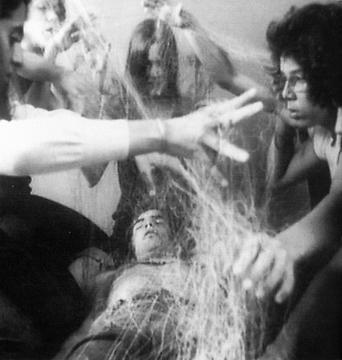
“¿Cuál es entonces la misión del artista?”, decía Clark, “Dar al participante el objeto que no tiene importancia por sí mismo y que sólo la tendrá en la medida en que el participante actúe. Es como un huevo que sólo revela su interior al ser abierto. (…) Es menester que la obra no cuente por ella misma y que sea un simple trampolín para la libertad del espectador-autor. Éste tomará conciencia a través de la proposición que le es ofrecida por el artista. No se trata de la participación por la participación, ni de la agresión por la agresión, sino de que el participante dé un significado a su gesto y de que su acto sea alimentado por un pensamiento, en ese caso el énfasis de su libertad de acción.” (1997: 152-153)
re-enactment
Short film records "Anthropophagic Slobber", proposal by Lygia Clark (1920 - 1988) (re)lived at Clark Art Center (CAC), Rio de Janeiro, Brasil, with Jards Macalé.
Direction and screenplay: Walmor Pamplona.
By Clark Art Center.
vimeo
she termed relational objects (everyday objects that the artist employed in an attempt used to stimulate the senses)
“Toward the end of her career, Clark coined another term, phantasmagoria of the body, which was also a way of intertwining art and psychotherapy. It’s a practice that deals with the notion of a life within an art object, something that scholars usually dismiss. It was through the discovery of her concept of the “phantasm” that Clark was able to surpass a mere anticipation of sensorial knowledge to enter the realm of actual fulfillment of that knowledge—a concept that differs from the contemporary notion of performance, and moves into the unconscious.
(...)
In Anthropophagic Slobber (1973) the ritualistic aspect of the proposition is crystal clear: a person lies on the floor, arms against her body. She doesn’t wear much. She rests, her eyes are closed. A group of people approach, they come, they kneel. They form a circle around the lying person and put colored threads inside their mouths—the threads are expelled from their lips wet, soaked with slobber. Saliva is stimulation. These people are then like spiders, depositing the webs on the person’s body. The spider can see the prone body—but only her “phantasm” can see the spider. It is within this kind of exercise that the object, a simple thread, becomes, for Clark, a powerful tool for the marriage between body and unconscious knowledge through art. When the person allows herself to become part of this embracing web, the slobber accepts her, she accepts herself.“ (from: https://artwriting.sva.edu/journal/post/lygia-clark-at-moma)
Vogue Germany January 2020
Images of a editorial photo shoot of the Voque Germany of January 2020, inviting artist Katharina Grosse as art director for the editorial fashion part. It’s called : Imagine (our title). She invited a platform of women ‘ Wir machen das’, writers, artists, architects, students, musicians to join the project. Their working field is migration, diversity and refugee movements in conversation with and over ….. The shoot shows divers types of women of different ages and shapes together in a shoot having conversations, also exposed in writings in the magazine.
https://wirmachendas.jetzt/en/mission/
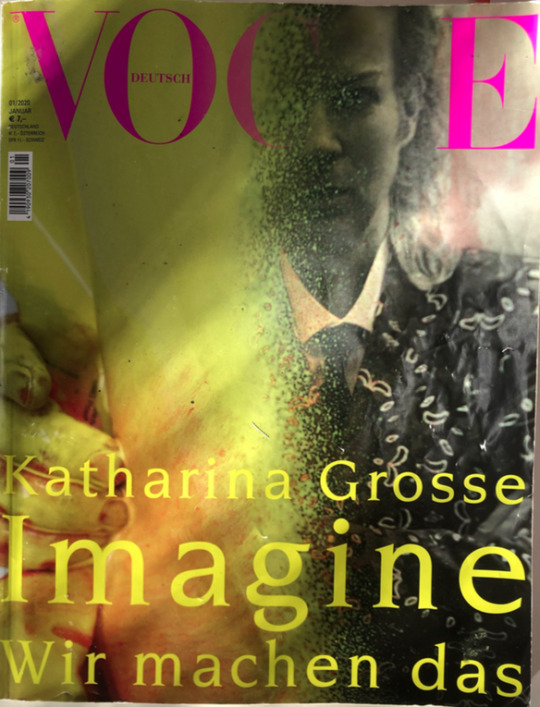
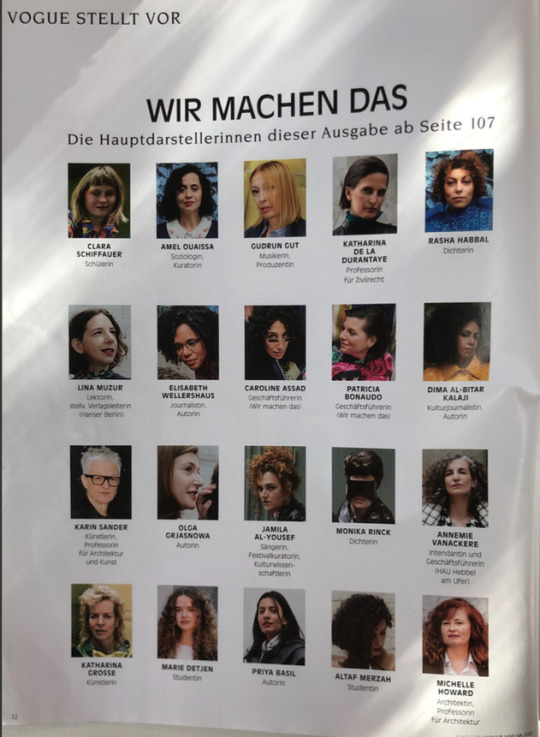

WIR MACHEN DAS – and this is who we are
WIR MACHEN DAS (WE ARE DOING IT) arose from a network of 100 women from arts and culture, science, journalism and public life under the association wearedoingit e.V. in 2015.
As a non-profit organisation we use various projects in the fields of arts and public relations to advocate for support, participation and the recognition of diversity in the context of refugee movements and migration.
Our Aims
We address all people not as “the needy”, but with regard to their expertise, because diverse perspectives enrich local discourses. Together we aim to improve career prospects, educational offers and networking opportunities. We foster individual resources and create opportunities for exchange. In this way, we bolster the involvement of people from zones of war and conflict. Together we are shaping a future in which immigration and diversity are seen as an opportunity and asset.
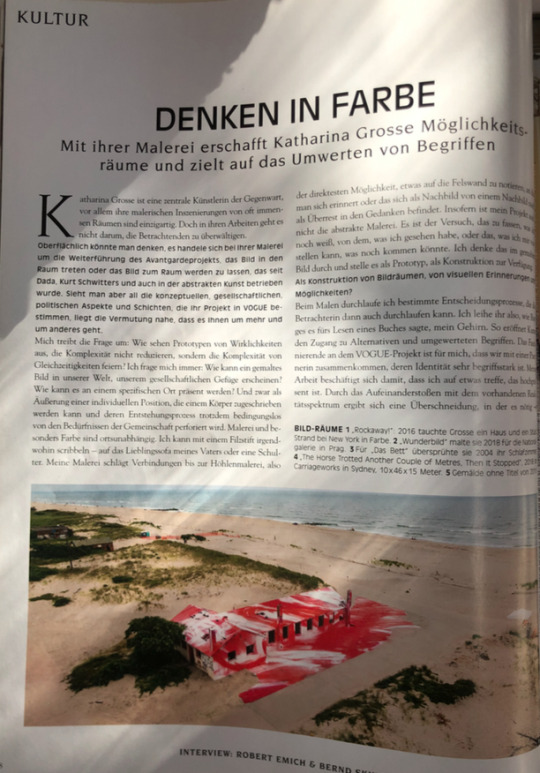


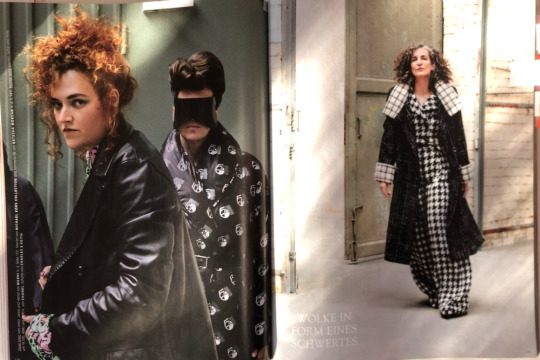
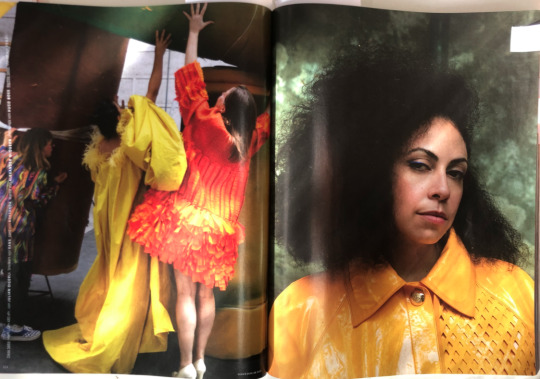




Plastic T-shirt bag invented to save the chopping of trees for paper bags in 1960

The inventor of the plastic bag Sten Gustaf Thulin. He intended the opposite with his invention:
American and European patent applications relating to the production of plastic shopping bags can be found dating back to the early 1950s, but these refer to composite constructions with handles fixed to the bag in a secondary manufacturing process. The modern lightweight shopping bag is the invention of Swedish engineer Sten Gustaf Thulin.[1] In the early 1960s, Thulin developed a method of forming a simple one-piece bag by folding, welding and die-cutting a flat tube of plastic for the packaging company Celloplast of Norrköping, Sweden. Thulin's design produced a simple, strong bag with a high load-carrying capacity, and was patented worldwide by Celloplast in 1965. As his son Raoul said later, Sten believed that durable plastic bags will be not single-used but long-term used and could replace paper bags which need chopping of trees.[7][8]
Source: https://en.wikipedia.org/wiki/Plastic_shopping_bag
https://www.independent.co.uk/environment/plastic-bags-pollution-paper-cotton-tote-bags-environment-a9159731.html
https://disposableamerica.org/the-plastic-bag/inventor-sten-gustaf-thulin/
Nzambi Matee
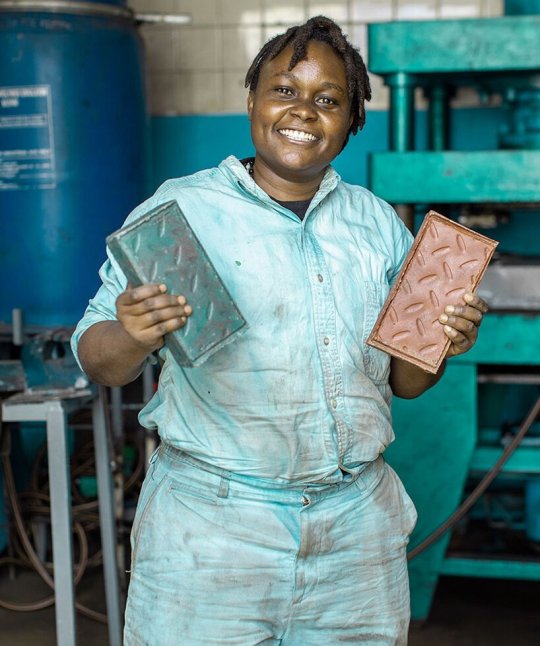
A nairobi-based 29-year-old entrepreneur and inventor — is the founder of a startup that recycles plastic waste into bricks that are stronger than concrete. called gjenge makers ltd, her company initiated following the development of a prototype machine that turns discarded plastic into paving stones. one day at the factory means 1,500 churned plastic pavers, prized not just for the quality, but for how affordable they are.
‘it is absurd that we still have this problem of providing decent shelter – a basic human need,’ said matee. ‘plastic is a material that is misused and misunderstood. the potential is enormous, but its after life can be disastrous.’
before creating gjenge makers ltd, nzambi matee majored in material science and worked as an engineer in kenya’s oil industry. in 2017 she quit her job to start creating and testing pavers, which are a combination of plastic and sand. she gets the waste material for free from packaging factories and also buys it from other recyclers. through experimentation, she understood which plastics bind better together and then created the machinery that would allow her to mass produce them.

‘we must rethink how we manufacture industrial products and deal with them at the end of their useful life,’ said soraya smaoun, who specializes in industrial production techniques with UNEP. ‘nzambi matee’s innovation in the construction sector highlights the economic and environmental opportunities when we move from a linear economy, where products, once used, are discarded, to a circular one, where products and materials continue in the system for as long as possible.’

Pierre Huyghe - Zoodram
Zoodrams: large aquariums with marine ecosystems, that embody the logic of the exhibition, in particular Zoodram 4 (2011) in which a crab turned a resin mask of the Sleeping Muse (1910) by Constantin Brancusi into its living habitat.


Zoodram 5 (After Sleeping Muse by Constantin Brancusi), 2011, a glass tank that provided living quarters for different species of crabs that cannibalize each other, a none-too-subtle metaphor for human rapaciousness.
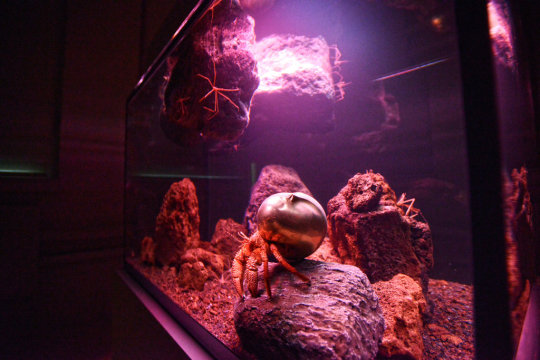
The tank is a repeated object in many of Huyghe’s works. They featured prominently in his retrospective, and a massive fish tank currently sits on the roof of the Metropolitan Museum as part of the Roof Garden Commission. Huyghe’s tanks are filled with strange, beautiful creatures. On the roof of the Met are tadpole shrimp, while inside the tanks in the retrospective were hermit crabs. The tank is an enclosed space. The viewer stands outside it, watching the creatures engage in their everyday activities. The tank is a lens through which we can better see Huyghe’s overall project. In an interview with Emily Nathan for Art in America, Huyghe stated:
The work is not “displayed” under a narrative — that’s a system I avoid. I could not imagine a chronological order, either. As you say, most of what I have done is construct situations that happen within a given body. Every one is a constellation network of process, all sorts of heterogenous and anachronistic things come together or are associated within a constructed situation, and so it is difficult to present them in a site where they were not originally, or to organize them in a linear way.
Pierre Huyghe says that life is the core interest of his practice: “I’m interested in how to quantify the different variations of being alive…how to intensify the presence of things.” Many of his performance, film, and installation pieces employ a range of living creatures—insects, plants, animals, and human beings—in order to explore their behavior and interactions. These works become laboratories for articulating complex social phenomena, the precarious distinction between fiction and reality, and contemporary belief systems.
Pawel Althamer
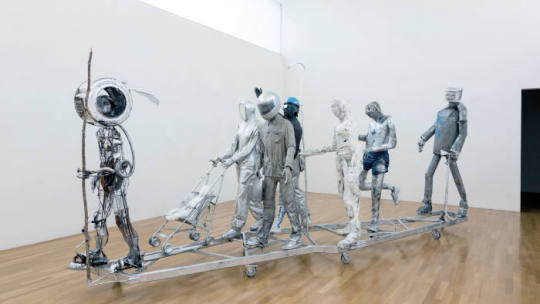
The sculptor Pawel Althamer, who had a cameo in After Nature with a pair of flayed bodies, has brought an entire parade of the undead to Expo 1. He and neighbours from his apartment block in Bródno, Poland, each created a life-sized alter ego, modelled out of scrap metal and technological trash. Like zombies from an apocalyptic nightmare, the figures in “Bródno People” march sightlessly through a huge gallery, an ungainly procession of solid ghosts that recalls Rodin’s “Burghers of Calais”.
Mel Chin
Revival Field
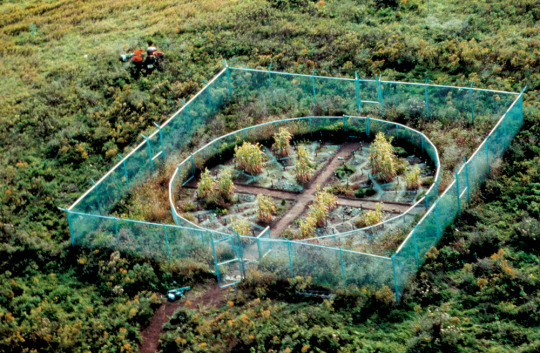
1991-ongoing
plants, industrial fencing on a hazardous waste landfill
an ongoing project in conjunction with Dr. Rufus Chaney, senior research agronomist, USDA
Revival Field began as a conceptual artwork with the intent to sculpt a site’s ecology. 1993 marked a successful conclusion to the first phase of this collaborative effort. The initial experiment, located at Pig’s Eye Landfill, a State Superfund site in St. Paul, Minnesota, was a replicated field test using special hyperaccumulator plants to extract heavy metals from contaminated soil. Scientific analysis of biomass samples from this field confirmed the potential of “Green Remediation” as an on-site, low-tech alternative to current costly and unsatisfactory remediation methods. Despite soil conditions adverse to metal uptake, a variety of Thlaspi, the test plant with the highest capacity for hyperaccumulation, was found to have significant concentration of cadmium in its leaves and stems.
vimeo
In Mel Chin’s Revival Field FIG. 3 soil is detoxified through the use of ‘hyperaccumulator’ plants in a dumping ground in Minnesota, demonstrating the need for speculative ecological proposals.
Thomas Hirschhorn
Jumbo Spoons and Big Cake




At first glance, Thomas Hirschhorn’s monumental installation Jumbo Spoons and Big Cake resembles a kind of documentation centre turned upside down, filled with papers, chained books, piled archives and photographs. In the centre, the jarring presence of a monumental cake surrounded by twelve giant spoons creates a metaphor on the state of the world today, and on the end of many 20th century utopias. Reminiscent of popular ‘souvenir spoon’ trinkets, the spoons portray individuals or entities that the artist associates with failed utopias: Mies van der Rohe, Rosa Luxemburg, Malevitch, Nietzsche, Venice, China, the Moon, firearms, fashion, the Nazis’ 1937 exhibition of “degenerate art,” Swiss Rolex watches, and the Chicago Bulls basketball team.
Tejal Shah
Between the Waves

Landfill Dance by Tejal Shah FIG. 5 is a video installation that involves several professional dancers dressed as quasi-mythical creatures, striking poses and moving in synchronicity in an unnamed mass landfill site in India. The work portrays ‘neither a neoliberal optimism nor paralysing despair’, but instead draws on the ‘potential of the bodies to coexist with this environment’, as is part of Boetzkes’s broader thesis that artists have demonstrated the need for an ‘intensive “working through” of the site’ and waste (pp.121–25). How, if at all, the work deals with people that notoriously have little choice but to rummage and work through mass garbage sites on a daily basis is unattended to.
Tejal Shah: Landfill Dance is part of the larger five-channel video installation, Between the Waves. Each channel also functions as a stand-alone piece. I first worked on channel 1, which is a longer film that forms the backbone of the installation.
“I am a big fan of contemporary and folk dance, with immense reverence for the medium. I have been eagerly awaiting an appropriate opportunity to collaborate with dancers. Finally, I decided to work with contemporary dance in this project to create seemingly nonsensical movements within the setting of a landfill to think about the futility of our gestures of sense making and recuperation in the Anthropocene (with a sense of humour of course!).” (https://huismarseille.nl/interview-tejal-shah/)
vimeo
vimeo
Olafur Eliasson
“Riverbed was for the Louisiana Museum, whose architecture is from a period where the seamlessness between inside and outside was introduced, as were a number of modern illusions of openness,” he says by way of preface. “Within this very contemplative museum, but also this very well functioning exhibition machine, I wanted something that would almost have the volume and scale to destabilise the museum a bit, pressure it. So I wanted it to look almost like a rock garden, but also to have a sense of a mudslide. Brutal, deathlike; it’s almost an alien landscape, and really it’s there to introduce destabilising qualities that one experiences outside – you’re walking on a slope, keeping your balance, recomposing your walking to fit the landscape – but you don’t really notice, you take them for granted. So I don’t only move the landscape in but also the microconflicts: suddenly we don’t take them for granted. This is what is interesting: the experience, the activities you do, also become exhibited. It’s as much about the interaction as about the actual plateau, the platform, on which people are walking.”



3 notes
·
View notes
Text
P1 - Anthropocene
Second Class:
2. Discussing Art in the Anhtopocene
13:00 – 14:15: Reading and group discussion of Art in the Anthropocene.
14:15 – 14:20: Break
14:20 – 15:00: Exercise inspired by Cloud Writing Poetry: Describing Soft Architectures of Change in the Anthropocene by Ada Smailbegovic.
Anthropocene
“The Anthropocene Epoch is an unofficial unit of geologic time, used to describe the most recent period in Earth’s history when human activity started to have a significant impact on the planet’s climate and ecosystems.

Atomic bomb tests like this one at Bikini Atoll in 1946 not only reassured military personnel that the bomb worked, but also created a powerful new symbol of the destructive power of the human species: the mushroom cloud.
Earth’s history is divided into a hierarchical series of smaller chunks of time, referred to as the geologic time scale. These divisions, in descending length of time, are called eons, eras, periods, epochs, and ages.
These units are classified based on Earth’s rock layers, or strata, and the fossils found within them. From examining these fossils, scientists know that certain organisms are characteristic of certain parts of the geologic record. The study of this correlation is called stratigraphy.
Officially, the current epoch is called the Holocene, which began 11,700 years ago after the last major ice age. However, the Anthropocene Epoch is an unofficial unit of geologic time, used to describe the most recent period in Earth’s history when human activity started to have a significant impact on the planet’s climate and ecosystems. The word Anthropocene is derived from the Greek words anthropo, for “man,” and cene for “new,” coined and made popular by biologist Eugene Stormer and chemist Paul Crutzen in 2000.
Scientists still debate whether the Anthropocene is different from the Holocene, and the term has not been formally adopted by the International Union of Geological Sciences (IUGS), the international organization that names and defines epochs. The primary question that the IUGS needs to answer before declaring the Anthropocene an epoch is if humans have changed the Earth system to the point that it is reflected in the rock strata.
To those scientists who do think the Anthropocene describes a new geological time period, the next question is, when did it begin, which also has been widely debated. A popular theory is that it began at the start of the Industrial Revolution of the 1800s, when human activity had a great impact on carbon and methane in Earth’s atmosphere. Others think that the beginning of the Anthropocene should be 1945. This is when humans tested the first atomic bomb, and then dropped atomic bombs on Hiroshima and Nagasaki, Japan. The resulting radioactive particles were detected in soil samples globally.
In 2016, the Anthropocene Working Group agreed that the Anthropocene is different from the Holocene, and began in the year 1950 when the Great Acceleration, a dramatic increase in human activity affecting the planet, took off.” (taken from: https://www.nationalgeographic.org/encyclopedia/anthropocene/)
Art in the Anthropocene. Encounters among aesthetics, politics, environments and epistemologies.
Edited by Heather Davis and Etienne Turpin.
Excerpts for class:
“First, we argue that the Anthropocene is primarily a sensorial phenomenon: the experience of living in an increasingly diminished and toxic world. Second, the way we have come to understand the Anthropocene has frequently been framed through modes of the visual, that is, through data visualization, satellite imagery, climate models, and other legacies of the “whole earth.” Third, art provides a polyarchic site of experimentation for “living in a damaged world,” as Anna Tsing has called it, and a non-moral form of address that offers a range of discursive, visual, and sensual strategies that are not confined by the regimes of scientific objectivity, political moralism, or psychological depression.
(...)
the Anthropocene can be felt as a call to re-imagine the human through biology and geology. It is a call, in other words, to place our industrialized present—a present that consumes time itself— within a temporal frame that is at once evolutionary and geologic. As a charismatic mega-concept (and one that seems to herald its own extinction through its enunciation), it emphasizes the need, as Donna Haraway says, “for a word to highlight the urgency of human impact on this planet, such that the effects of our species are literally written into the rocks.”18 The Anthropocene is a term that beckons environmental justice thinking, asking what worlds we are intentionally and inadvertently creating, and what worlds we are foreclosing while living within an increasingly diminished present. It has become a concept that speaks not just to the hallmarks of our time, such as climate change and the so-called Sixth Extinction, but creates a need to think through the interconnections and interactions of these events in conjunction with political economic logics and their attendant debts to the future.19
(...)
The Anthropocene can be framed as the global condition of being born into a world that no longer exists, as Bill McKibben has recently claimed.48 We are all “being overtaken by processes that are unmaking the world that any of us ever knew,” Deborah Bird Rose asserts.49 This overtaking is primarily an aesthetic event. Our sensorial and perceptive systems are being refashioned at rates that we can barely keep up with, as the world around us changes so rapidly. We daily experience what used to be a sublime moment; anthropogenic mountains are now so ordinary that we don’t even notice them.
(...)
Whether framing Anthropocene aesthetics through the arts or our sensory experience of an increasingly unpredictable world, “The Anthropocene is so built in to our senses that it determines our perceptions, hence it is aesthetic.”51 The fact that we have become so anaesthetized to these realities necessitates a reconsideration of the historical avant-garde. Beyond the modernist valorization of the principle of shock in art, our current climate demands a different kind of aesthetic and sensorial at- tention. In Regarding the Pain of Others, Susan Sontag presciently warned: “Shock can become familiar. Shock can wear off.”52 There is no shock that could be greater than that of realizing the scope and scale of the human transformation of the world.
(...)
If we are to learn to adapt in this world, we will need to do so with all the other creatures; seeing from their perspective is central to re-organizing our knowledge and perceptions. The ability to think the human species implied by the terminology of the Anthropocene within a particular Umwelt (a concept proposed by Jakob von Uexküll) affords us the possibility of opening up and onto the life worlds of other species. To think of ourselves as biological organisms first, as one type among the worlds of other critters, allows for more open and curious relations to the other beings with whom we co-compose the world.
Exercise: Cloud Writing Poetry
Each student will take 20 minutes to describe in writing the clouds above them and use poetic and creative writing to detail the changing present.
Each student must have at least three (3) descriptions that can portray the change in the sky.
Focus in the passage of time and think about the different temporalities that co-exist in our living environment.
Do experimental writing, use metaphors, work with repetition, be creative.
Each student can do it in their own preferred language, except for one (1) in English.

“the Blur Building, designed by Elizabeth Diller and Ricardo Scofidio as a temporary installation for the Swiss National Expo held in Yverdon-les-Bains, Switzerland, in 2002. [Fig. 01] The archi- tects used water and air as primary construction materials, drawing up the lake water available at the site and atomizing it into a fine mist by passing it through “a dense array of high-pressure water nozzles.”1 The result is a cloud building, com- posed of innumerable tiny droplets of vapour suspended above a steel pavilion ele- vated over the surface of Neuchâtel Lake.”
(find more here: https://dsrny.com/project/blur-building)
Exercise inspired by Ada Smailbegovic descriptions of the Blur Building using Lisa Robertson’s descriptive practices of natural history as her inspiration:
Description of Change One
At this instant the sky is bright blue. In the foreground, halfway up the frame, a low-lying cumulus cloud is forming above the surface of the lake. A white volume begins to change and spread outward. At its middle the mass of the cloud is wide and vibrant so that it appears to form a bright solid. Moving and unmoving blocks of sky become visible. A steel structure appears as an orbit of vertical columns and a tensile spun canopy resting on the surface of an elevated saucer. The vapour begins rising again from the left corner of the frame, filling and filling the space until no discernment is possible between the shape of the cloud and the sky.
Description of Change Two
At this instant the sky is bright blue. In the foreground, halfway up the frame, a low-lying cumulus cloud is forming above the surface of the lake. A white volume begins to change and spread outward. At its middle the mass of the cloud is wide and vibrant so that it appears to form a bright solid. The wool- pack begins unraveling at the edges, the wind rending it into fine wisps that involute in the way that smoke strands bend, thicken for an instant and then move outwards until they are morselled to nothing and consumed. Moving and unmoving blocks of sky become visible. A steel structure appears as an orbit of vertical columns and a tensile spun canopy resting on the surface of an elevated saucer. The vapour begins rising again from the left corner of the frame, filling and filling the space until no discernment is possible between the shape of the cloud and the sky. Darker clouds appear, overhung by straggling clouds that sail over them passing quickly, driven by the lower winds. Then the sky is spread over with one continuous cloud, streaked by silver lines of water running between the ridges of the vapour.
Description of Change three:
At this instant the sky is bright blue. In the foreground, halfway up the frame, a low-lying cumulus cloud is forming above the surface of the lake. A white volume begins to change and spread outward. At its middle the mass of the cloud is wide and vibrant so that it appears to form a bright solid: solid but not crisp, white like the white of egg, and bloated-looking. The woolpack begins unraveling at the edges, the wind rending it into fine wisps that in- volute in the way that smoke strands bend, thicken for an instant and then move outwards until they are morselled to nothing and consumed. A shallow valley forms in the middle with widening slopes, which begin to form a shape of the letter V. Moving and unmoving blocks of sky become visible. At once the clouds seem to cleave asunder. A steel structure appears as an orbit of vertical columns and a tensile spun canopy resting on the surface of an elevated saucer. The sky is flat, unmarked by distances, a white thin cloud, chalky and milk-coloured, with a remarkable oyster-shell molding. The vapour begins rising again from the left corner of the frame, filling and filling the space until no discernment is possible between the shape of the cloud and the sky. Darker clouds appear, overhung by straggling clouds that sail over them, passing quickly driven by the lower winds. Then the sky is spread over with one continuous cloud, streaked by silver lines of water running between the ridges of the vapour.
The Anthropocene is a way of framing time; it offers a means for characterizing a new epoch defined by human impact on the geological, atmospheric, and ecological processes occurring on Earth. Understanding the Anthropocene not merely as an abstract taxonomic category but as a felt temporality requires a careful attunement to the variegated kinds of change that compose this temporal frame in the unfolding moment of the present. Such an attunement to the particulate differences that com- pose change is difficult because many of them occur at rhythms of transformation that are below the threshold of temporal sensitivity available to human perception.
Imagine, for instance, a sea floor covered with starfish. To a human observer, this may appear to be a scene of near stillness, as the cold purple and red shapes of the starfish seem only slightly more animate than the rocks beneath them. Viewing this scene with the aid of time-lapse photography, however, reveals that the starfish are rapidly moving across the sea floor according to the parameters of their own Umwelt.6 Some of them, like the morning sun star (Solaster dawsoni), inch rapidly across the seafloor to attack other starfish, such as leather stars (Dermasterias im- bricata), which move more slowly and are thus too sluggish to evade the morning sun star. The lens of a camera—capable of capturing increments of change at a different number of frames per second than the human eye—floods the stillness of such an underwater scene with innumerable details, revealing contracting ar- rays of orange dots and spines moving with hydraulic slowness as individual tube feet attach and detach from the rocky substrate. Such a mediated series of images brings the rhythms of starfish time into contact with the temporal pace of the human perceptual world.

0 notes
Text
Feminism and its waves
1st Wave
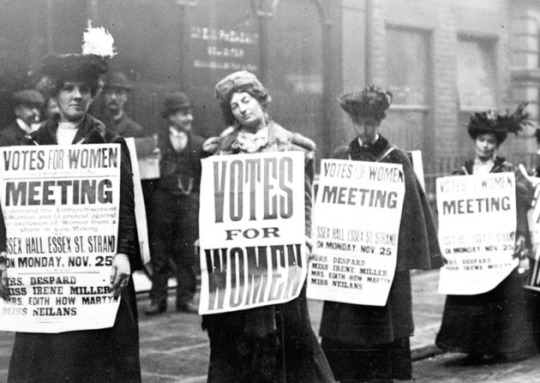
The first wave of feminism took place in the late nineteenth and early twentieth centuries, emerging out of an environment of urban industrialism and liberal, socialist politics. The goal of this wave was to open up opportunities for women, with a focus on suffrage. The wave formally began at the Seneca Falls Convention in 1848 when three hundred men and women rallied to the cause of equality for women. Elizabeth Cady Stanton (d.1902) drafted the Seneca Falls Declaration outlining the new movement's ideology and political strategies.
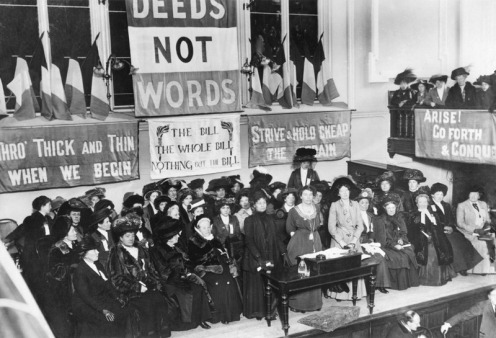
In its early stages, feminism was interrelated with the temperance and abolitionist movements and gave voice to now-famous activists like the African-American Sojourner Truth (d. 1883), who demanded: "Ain't I a woman?" Victorian America saw women acting in very "un-ladylike" ways (public speaking, demonstrating, stints in jail), which challenged the "cult of domesticity." Discussions about the vote and women's participation in politics led to an examination of the differences between men and women as they were then viewed. Some claimed that women were morally superior to men, and so their presence in the civic sphere would improve public behavior and the political process. (https://www.pacificu.edu/magazine/four-waves-feminism)
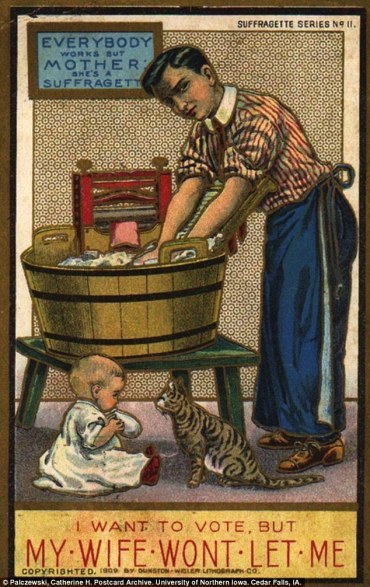
2nd Wave
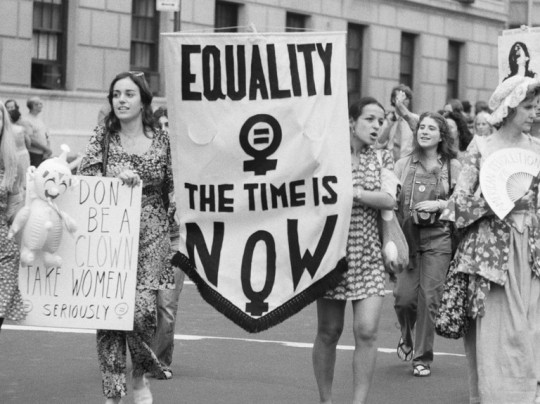
The second wave began in the 1960s and continued into the 90s. This wave unfolded in the context of the anti-war and civil rights movements and the growing self-consciousness of a variety of minority groups around the world. The New Left was on the rise, and the voice of the second wave was increasingly radical. In this phase, sexuality and reproductive rights were dominant issues, and much of the movement's energy was focused on passing the Equal Rights Amendment to the Constitution guaranteeing social equality regardless of sex.
This phase began with protests against the Miss America pageant in Atlantic City in 1968 and 1969. Feminists parodied what they held to be a degrading "cattle parade" that reduced women to objects of beauty dominated by a patriarchy that sought to keep them in the home or in dull, low-paying jobs. The radical New York group called the Redstockings staged a counter pageant in which they crowned a sheep as Miss America and threw "oppressive" feminine artifacts such as bras, girdles, high-heels, makeup and false eyelashes into the trashcan.
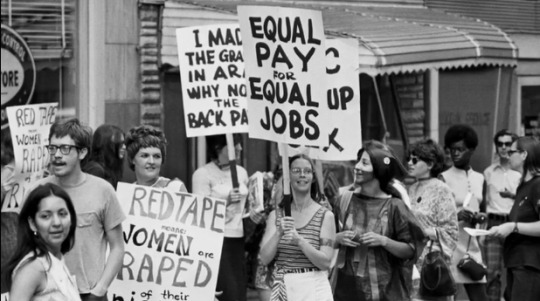
Because the second wave of feminism found voice amid so many other social movements, it was easily marginalized and viewed as less pressing than, for example, Black Power or efforts to end the war in Vietnam. Feminists reacted by forming women-only organizations (such as NOW) and "consciousness raising" groups. In publications like "The BITCH Manifesto" and "Sisterhood is Powerful," feminists advocated for their place in the sun. The second wave was increasingly theoretical, based on a fusion of neo-Marxism and psycho-analytical theory, and began to associate the subjugation of women with broader critiques of patriarchy, capitalism, normative heterosexuality, and the woman's role as wife and mother. Sex and gender were differentiated—the former being biological, and the later a social construct that varies culture-to-culture and over time.
Whereas the first wave of feminism was generally propelled by middle class, Western, cisgender, white women, the second phase drew in women of color and developing nations, seeking sisterhood and solidarity, claiming "Women's struggle is class struggle." Feminists spoke of women as a social class and coined phrases such as "the personal is political" and "identity politics" in an effort to demonstrate that race, class, and gender oppression are all related. They initiated a concentrated effort to rid society top-to-bottom of sexism, from children's cartoons to the highest levels of government.
One of the strains of this complex and diverse "wave" was the development of women-only spaces and the notion that women working together create a special dynamic that is not possible in mixed-groups, which would ultimately work for the betterment of the entire planet. Women, due whether to their long "subjugation" or to their biology, were thought by some to be more humane, collaborative, inclusive, peaceful, nurturing, democratic, and holistic in their approach to problem solving than men. The term eco-feminism was coined to capture the sense that because of their biological connection to earth and lunar cycles, women were natural advocates of environmentalism.(https://www.pacificu.edu/magazine/four-waves-feminism)
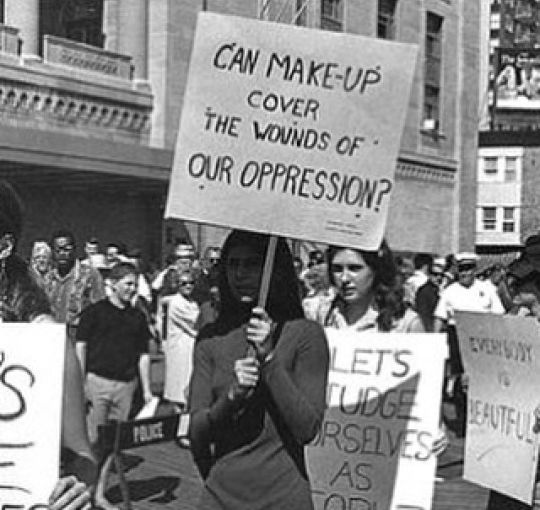
Critique to the 2nd wave: Some black and/or working class and poor women felt alienated by the main planks of the second-wave feminist movement, which largely advocated women's right to work outside the home and expansion of reproductive rights. Women of color and poor white women in the US had been working outside of the home in blue-collar and service jobs for generations. Additionally, Angela Davis wrote that while Afro-American women and white women were subjected to multiple unwilled pregnancies and had to clandestinely abort, Afro-American women were also suffering from compulsory sterilization programs that were not widely included in dialogue about reproductive justice.Beginning in the late 20th century, numerous feminist scholars such as Audre Lorde[118] and Winona LaDuke[119] critiqued the second wave in the United States as reducing feminist activity into a homogenized and whitewashed chronology of feminist history that ignores the voices and contributions of many women of color, working-class women, and LGBT women.[120][121]The second-wave feminist movement in the United States has been criticized for failing to acknowledge the struggles of women of color, and their voices were often silenced or ignored by white feminists.[122][120] It has been suggested that the dominant historical narratives of the feminist movement focuses on white, East Coast, and predominantly middle-class women and women's consciousness-raising groups, excluding the experiences and contributions of lesbians, women of color, and working-class and lower-class women.[43]Chela Sandoval called the dominant narratives of the women's liberation movement "hegemonic feminism" because it essentializes the feminist historiography to an exclusive population of women, which assumes that all women experience the same oppressions as the white, East Coast, and predominantly middle-class women.[123] This restricting view purportedly ignored the oppressions women face determined by their race, class, and sexuality, and gave rise to women-of-color feminisms that separated from the women's liberation movement, such as Black feminism, Africana womanism, and the Hijas de Cuauhtémoc that emerged at California State University, Long Beach, which was founded by Anna Nieto-Gómez, due to the Chicano Movement's sexism.[124][125][126]Kimberlé Crenshaw coined the term "intersectionality" in 1989 in response to the white, middle-class views that dominated second-wave feminism. Intersectionality describes the way systems of oppression (i.e. sexism, racism) have multiplicative, not additive, effects, on those who are multiply marginalized. It has become a core tenet of third-wave feminism.[127] (wikipedia)
Black Feminism

Black feminism holds that the experience of Black women gives rise to a particular understanding of their position in relation to sexism, class oppression, and racism.[1][2] The experience of being a Black woman, it maintains, cannot be grasped in terms of being Black or of being a woman but must be elucidated via intersectionality,[3] a term coined by legal scholar Kimberlé Crenshaw in 1989. Crenshaw argued that each concept—being Black and being female—should be considered independently while understanding that intersecting identities deepen and reinforce one anothe
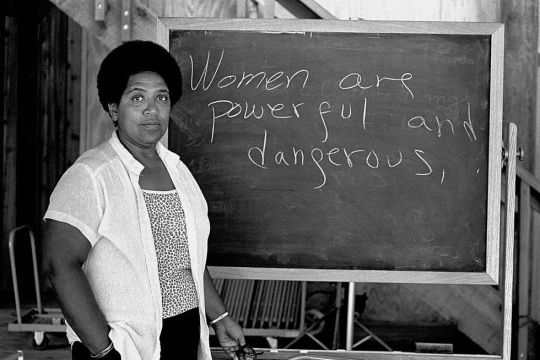
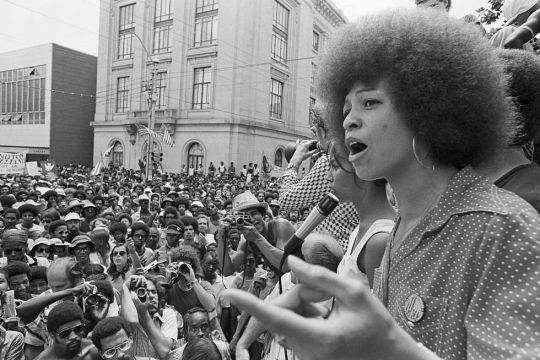
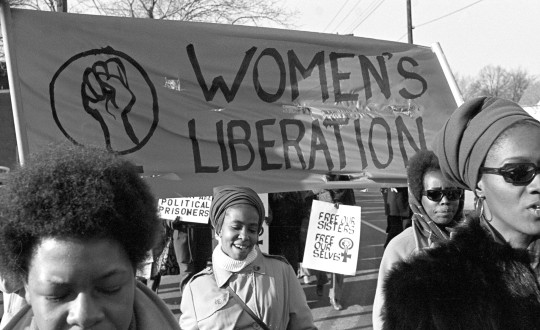
3rd WAVE
The third wave of feminism began in the mid-90's and was informed by post-colonial and post-modern thinking. In this phase many constructs were destabilized, including the notions of "universal womanhood," body, gender, sexuality and heteronormativity. An aspect of third wave feminism that mystified the mothers of the earlier feminist movement was the readoption by young feminists of the very lip-stick, high-heels, and cleavage proudly exposed by low cut necklines that the first two phases of the movement identified with male oppression. Pinkfloor expressed this new position when she said that it's possible to have a push-up bra and a brain at the same time.
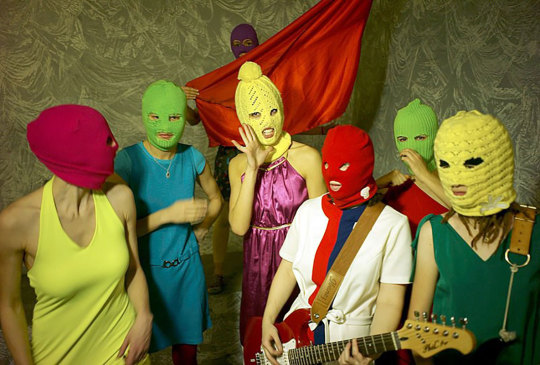
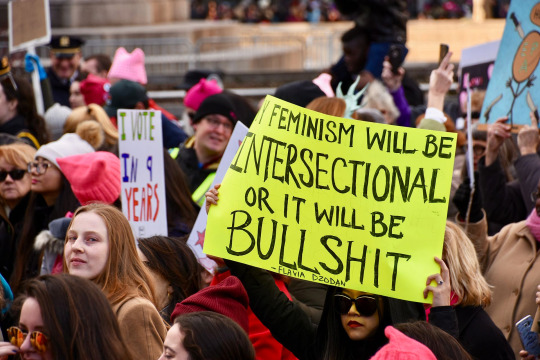
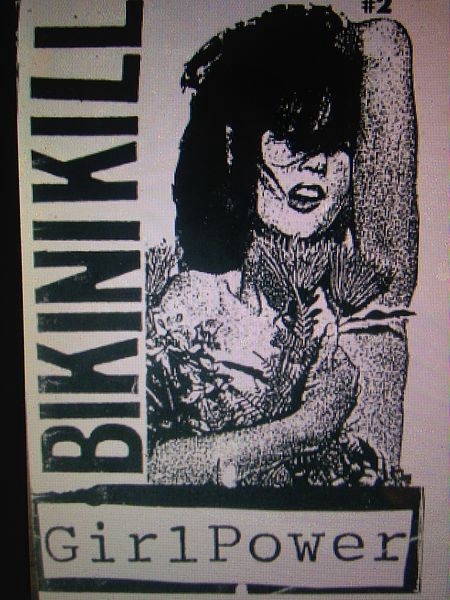
The "grrls" of the third wave stepped onto the stage as strong and empowered, eschewing victimization and defining feminine beauty for themselves as subjects, not as objects of a sexist patriarchy. They developed a rhetoric of mimicry, which appropriated derogatory terms like "slut" and "bitch" in order to subvert sexist culture and deprive it of verbal weapons. The web is an important tool of "girlie feminism." E-zines have provided "cybergrrls" and "netgrrls" another kind of women-only space. At the same time — rife with the irony of third-wave feminism because cyberspace is disembodied — it permits all users the opportunity to cross gender boundaries, and so the very notion of gender has been unbalanced in a way that encourages experimentation and creative thought.
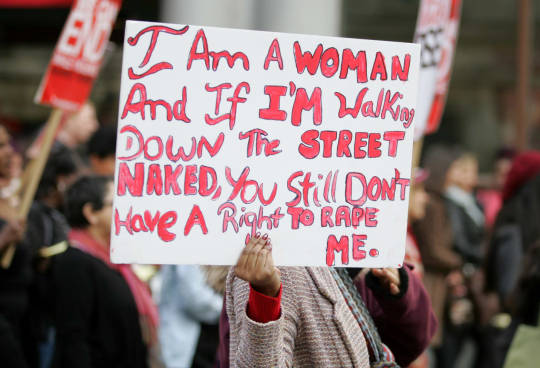
This is in keeping with the third wave's celebration of ambiguity and refusal to think in terms of "us-them." Most third-wavers refuse to identify as "feminists" and reject the word that they find limiting and exclusionary. Grrl-feminism tends to be global, multi-cultural, and it shuns simple answers or artificial categories of identity, gender, and sexuality. Its transversal politics means that differences such as those of ethnicity, class, sexual orientation, etc. are celebrated and recognized as dynamic, situational, and provisional. Reality is conceived not so much in terms of fixed structures and power relations, but in terms of performance within contingencies. Third wave feminism breaks boundaries.
(https://www.pacificu.edu/magazine/four-waves-feminism)
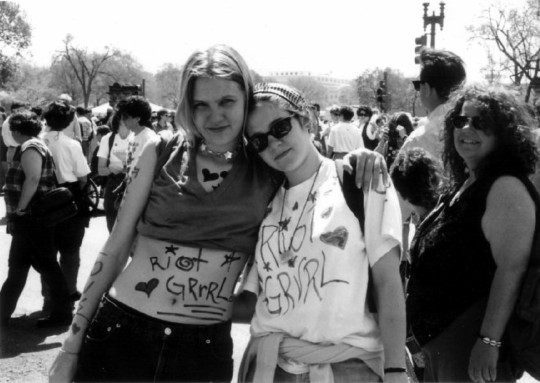

4th WAVE -

The Guardian-
Welcome to the fourth wave of feminism. This movement follows the first-wave campaign for votes for women, which reached its height 100 years ago, the second wave women's liberation movement that blazed through the 1970s and 80s, and the third wave declared by Rebecca Walker, Alice Walker's daughter, and others, in the early 1990s. That shift from second to third wave took many important forms, but often felt broadly generational, with women defining their work as distinct from their mothers'. What's happening now feels like something new again. It's defined by technology: tools that are allowing women to build a strong, popular, reactive movement online.
The majority of activists I speak to define themselves as intersectional feminists – or say they try to live up to this decription – and when I mention this to Kimberlé Crenshaw, the US law professor who coined the term intersectionality in 1989, she's genuinely surprised. The theory concerns the way multiple oppressions intersect, and although, as Crenshaw says, it can be interpreted in a wild variety of ways, today's feminists generally seem to see it as an attempt to elevate and make space for the voices and issues of those who are marginalised, and a framework for recognising how class, race, age, ability, sexuality, gender and other issues combine to affect women's experience of discrimination. Younis considers intersectionality the overriding principle for today's feminists, and Ali says she constantly tries to check her privilege, to recognise how hierarchies of power are constructed.
(https://www.theguardian.com/world/2013/dec/10/fourth-wave-feminism-rebel-women)
Britannica -
Although debated by some, many claim that a fourth wave of feminism began about 2012, with a focus on sexual harassment, body shaming, and rape culture, among other issues. A key component was the use of social media to highlight and address these concerns. The new wave arose amid a number of high-profile incidents. In December 2012 a young woman was brutally gang-raped in India and subsequently died, sparking local protests and international outrage. That was followed two years later by the Gamergate campaign, a manifestation of the so-called “men’s rights movement” that had its origins on the Web site 4chan. GamerGate ostensibly sought to promote ethics in video-game journalism, but it was in reality a harassment campaign against “social justice warriors.” The latter were often women who objected to female stereotypes in video games and were subsequently inundated with death threats and rape threats.
Against this background came Donald Trump’s defeat of Hillary Clinton in the U.S. presidential election in 2016. Trump had made a number of inflammatory remarks about women, and the day after the election a grandmother went on Facebook to propose a march on Washington, D.C. The suggestion quickly gained traction and became a call for social change, especially in regard to gender equality. Known as the Women’s March, it grew to include demonstrations across the United States and around the world. The protests took place on January 21, 2017, the day after Trump’s inauguration, and as many as 4.6 million people attended the various events in the United States, making the Women’s March perhaps the largest single-day demonstration in that country’s history.

Arguably even more significant was the Me Too movement, which was launched in 2006 in the United States to assist survivors of sexual violence, especially females of colour. The campaign gained widespread attention beginning in 2017, after it was revealed that film mogul Harvey Weinstein had for years sexually harassed and assaulted women in the industry with impunity. Victims of sexual harassment or assault around the world—and of all ethnicities—began sharing their experiences on social media, using the hashtag #MeToo. The movement grew over the coming months to bring condemnation to dozens of powerful men in politics, business, entertainment, and the news media.

10 notes
·
View notes
Text
Site Specific Performance
GHOST, The Boat

GHOST, Swarming spawns rebel workers

Piet Zwart Institute
vimeo
Eduardo Navarro, In Collaboration With The Sun
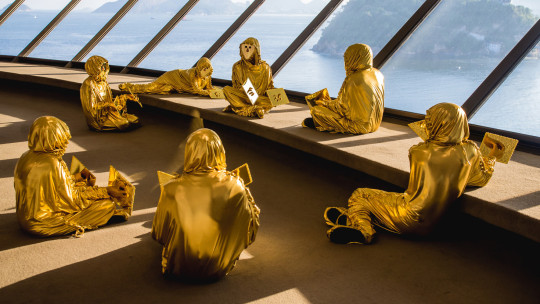
http://www.navarroeduardo.com/In.Collaboration.With.the.Sun.pdf
Heinz Mack
vimeo
https://artblart.com/tag/heinz-mack-sahara-project/
Others in other pages:
ex. Ana Mendieta, Adrian Piper, Doris Salcedo, Regina José Galindo, Pope L.
0 notes
Text
Statement

— AIDS activist and queer artist Zoe Leonard saying exactly what we’re thinking each election season. Leonard was a member of the queer/HIV civil-disobedience group ACT UP and also a founding member of the feminist collective fierce pussy, a collective of queer women artists who raise lesbian identity visibility in the streets through “wheat pasting posters on the street [and] renaming New York City streets after prominent lesbian heroines.”
0 notes
Text
Taking the square
15M = Los Indignados
(First gathering before Spanish elections on the 15 May 2011)
On 15 May 2011, the platforms Democracia Real Ya (Real Democracy Now) and Jovenes sin Futuro (Young People with No Future) organized a demon- stration in Madrid’s Puerta del Sol square that attracted unexpectedly large numbers of protesters (around 20,000 people) through a call for action that went viral on Twitter. At the end of the demonstration, a group of about a hundred protesters decided to occupy the Puerta del Sol. is occupation was followed by a violent eviction attempt by the police that had the e ect of attracting thousands of protesters and wide popular support. is event marked the birth of the indignados social movement which is also known as 15M movement.


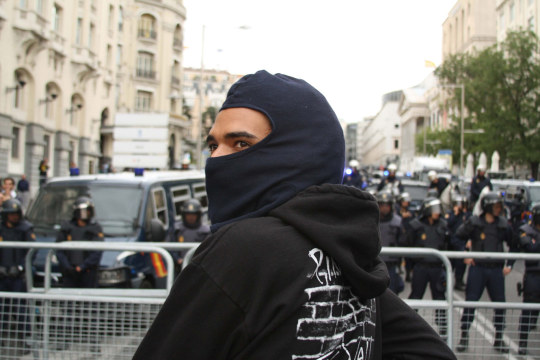

Tahrir Square
The Egyptian revolution of 2011, also known as the 25 January Revolution (Arabic: ثورة 25 يناير; Thawrat khamsa wa-ʿišrūn yanāyir),[21] started on 25 January 2011 and spread across Egypt. The date was set by various youth groups to coincide with the annual Egyptian "Police holiday" as a statement against increasing police brutality during the last few years of Mubarak's presidency. It consisted of demonstrations, marches, occupations of plazas, non-violent civil resistance, acts of civil disobedience and strikes. Millions of protesters from a range of socio-economic and religious backgrounds demanded the overthrow of Egyptian President Hosni Mubarak. Violent clashes between security forces and protesters resulted in at least 846 people killed and over 6,000 injured.[22][23] Protesters retaliated by burning over 90 police stations across the country.
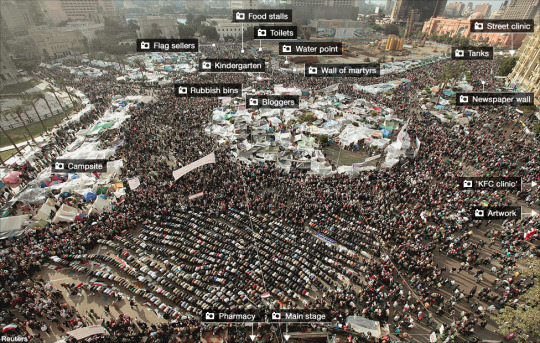
Anti-Mubarak 18 day demonstrations - Camp

This artwork, "Egypt's Heart", is one of many created by the demonstrators. The heart faces down one of the streets through which pro-Mubarak supporters came to clash with the anti-government protesters. Many visitors have had their photographs taken next to the heart. (From BBC)

This Kentucky Fried Chicken fast food restaurant has been taken over by protesters and turned into a clinic for the injured and the sick. (From BBC)

Every morning Egypt's main newspapers are pasted up on the shutters of this shop, allowing protesters who cannot afford to buy a paper can still follow the latest reports, says our correspondent. (From BBC)

This "street hospital", staffed by volunteer doctors, is one of several clinics where injured protesters have their wounds treated. Since Egyptians do not typically have access to free medical care, some say the clinics in the square are an improvement on what they are used to. (From BBC)

Schools in Cairo have been closed during the protests. But there are so many mothers who want to attend the demonstration that many bring their children here - to a kindergarten organised by the demonstrators. (From BBC)
Occupy Movement


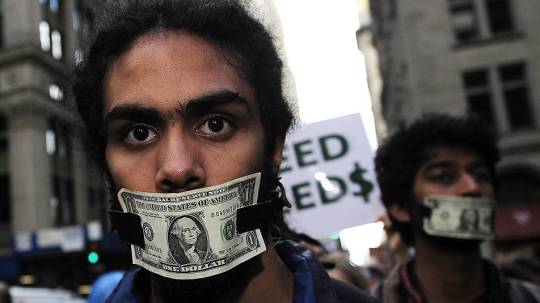
1968 student protests
Beginning in May 1968, a period of civil unrest occurred throughout France, lasting some seven weeks and punctuated by demonstrations, general strikes, and the occupation of universities and factories. At the height of events, which have since become known as May 68, the economy of France came to a halt.[1] The protests reached such a point that political leaders feared civil war or revolution; the national government briefly ceased to function after President Charles de Gaulle secretly fled France to Germany at one point. The protests spurred movements worldwide, with songs, imaginative graffiti, posters, and slogans.[2][3]
The unrest began with a series of student occupation protests against capitalism, consumerism, American imperialism and traditional institutions. Heavy police repression of the protesters led France's trade union confederations to call for sympathy strikes, which spread far more quickly than expected to involve 11 million workers, more than 22% of the total population of France at the time.[1] The movement was characterized by spontaneous and decentralized wildcat disposition; this created a contrast and at times even conflict internally amongst the trade unions and the parties of the left.[1] It was the largest general strike ever attempted in France, and the first nationwide wildcat general strike.[1]


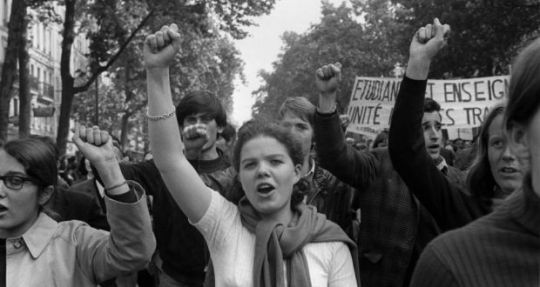

The protests of 1968 comprised a worldwide escalation of social conflicts, predominantly characterized by popular rebellions against the military and the bureaucracy.
In the United States, these protests marked a turning point for the civil rights movement, which produced revolutionary movements like the Black Panther Party. In reaction to the Tet Offensive, protests also sparked a broad movement in opposition to the Vietnam War all over the United States as well as in London, Paris, Berlin and Rome. Mass movements grew not only in the United States but also elsewhere. In most Western European countries, the protest movement was dominated by students. The most spectacular manifestation of these were the May 1968 protests in France, in which students linked up with wildcat strikes of up to ten million workers, and for a few days the movement seemed capable of overthrowing the government. In many other countries, struggles against dictatorships, political tensions and authoritarian rule were also marked by protests in 1968, such as the beginning of the Troubles in Northern Ireland, the Tlatelolco massacre in Mexico City, and the escalation of guerrilla warfare against the military dictatorship in Brazil.


Sit-Ins from the Civil Rights Movement
Many African Americans inspired by the Brown decision, the unjust murder of Emmett Till and the courage of Rosa Parks had been waiting for faster progress in school desegregation and civil rights reforms. College students were eager to join the movement and adopted a new non-violent tactic inspired by the teachings of Martin Luther King Jr., based on the philosophy of Gandhi and Jesus. It consisted in peacefully and patiently sitting at segregated locations such as lunch counters, movie theaters, parks and other public places.


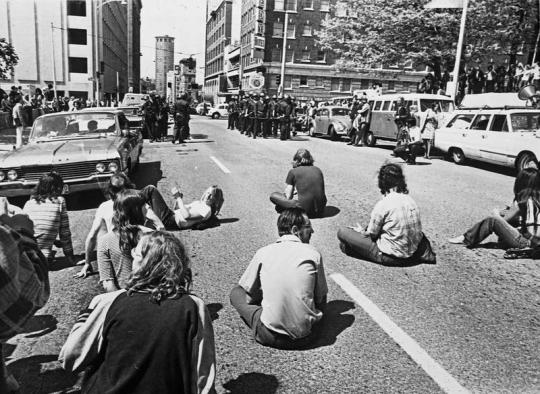
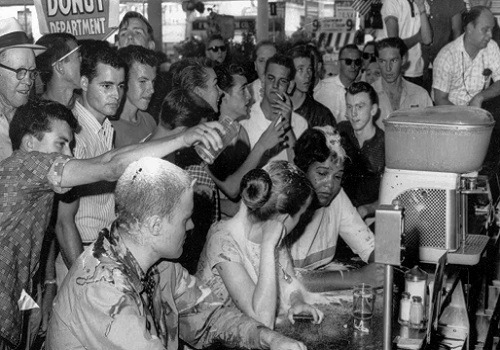

Rosa Parks

On this day in 1955, Rosa Parks was arrested and charged with violating an ordinance that required her to relinquish her bus seat to a white passenger.
Tiananmen square protests 1989
In May 1989, nearly a million Chinese, mostly young students, crowded into central Beijing to protest for greater democracy and call for the resignations of Chinese Communist Party leaders deemed too repressive. For nearly three weeks, the protesters kept up daily vigils, and marched and chanted. Western reporters captured much of the drama for television and newspaper audiences in the United States and Europe.



On June 4, 1989, however, Chinese troops and security police stormed through Tiananmen Square, firing indiscriminately into the crowds of protesters. Turmoil ensued, as tens of thousands of the young students tried to escape the rampaging Chinese forces. Other protesters fought back, stoning the attacking troops and overturning and setting fire to military vehicles. Reporters and Western diplomats on the scene estimated that at least 300, and perhaps thousands, of the protesters had been killed and as many as 10,000 were arrested.
Détournement
An artistic practice conceived by the Situationists for transforming artworks by creatively disfiguring them. In ‘A User's Guide to Détournement’ (1956), Guy Debord, a key Situationist theorist, and Gil Wolman, argue that détournement has a double purpose: on the one hand, it must negate the ideological conditions of artistic production, the fact that all artworks are ultimately commodities; but on the other hand, it must negate this negation and produce something that is politically educative. It achieves negation in two main ways: either it adds details to existing works, thus revealing a previously obscured ambiguity, or it cuts up a range of works and recombines them in new and surprising ways. The enemy of this practice is, however, sheer novelty, and it is this that must be guarded against in producing the negation of the negation. The Situationists take the position that the literary and artistic heritage of humanity should be used for what they term partisan propaganda purposes, by which they mean the promotion of radical politics. The advantage of détournement, Debord and Wolman argue, is that it is cheap but powerful and that makes it a weapon anyone can use to break through what they famously call the Chinese walls of understanding. Marcel Duchamp's moustache on the Mona Lisa is regarded as consistent with this aim, but too tame; similarly, Bertolt Brecht's re-staging of classical plays by Shakespeare is regarded as a crucial prototype, but again it is seen as being too conservative. The poète maudit Lautréamont (pen-name of Paris-based Uruguayan writer Isidore Ducasse) is generally regarded as the main precursor; his Les Chants de Maldoror (1868) is cited by Debord and others as the perfect example of an extended détournement. The main exponent of the practice of détournement was Danish painter Asger Jorn who, along with Guy Debord, was one of the founders of the Situationist movement. (from: Oxford Reference)
Exercise with this?
0 notes
Text
References
Pauline Boudry / Renate Lorenz -
Telepathic Improvisation 2017
youtube
Pauline Curnier Jardin
youtube
http://paulinecurnierjardin.com/sebastiano-blu-2018/
Ragnar Kjartansson
youtube
Sophie Jung
https://vimeo.com/330191743
youtube
0 notes
Text
Performance references
Jacob Jonas the Company
View this post on Instagram
A post shared by Jacob Jonas The Company (@__jjtc__) on Jan 13, 2020 at 9:54am PST
View this post on Instagram
A post shared by Jacob Jonas The Company (@jacobjonasthecompany) on Feb 23, 2020 at 6:54pm PST
Isabelle Wenzel
View this post on Instagram
A post shared by Isabelle Wenzel (@isabelle.w.e.n.z.e.l) on May 2, 2020 at 2:51am PDT
View this post on Instagram
A post shared by Isabelle Wenzel (@isabelle.w.e.n.z.e.l) on Sep 1, 2020 at 4:23am PDT
Sadler’s Wells
View this post on Instagram
A post shared by Sadler's Wells (@sadlers_wells) on May 22, 2020 at 6:53am PDT
Joan Jonas
https://art21.org/watch/art-in-the-twenty-first-century/s7/joan-jonas-in-fiction-segment/
Osías Yanov
Choreographies of Salt
0 notes